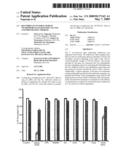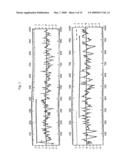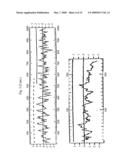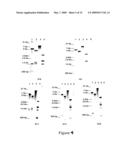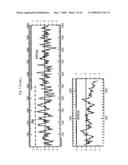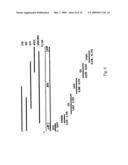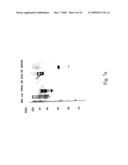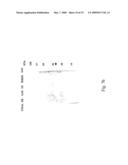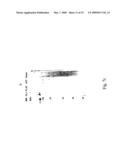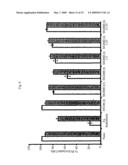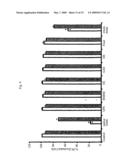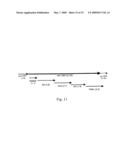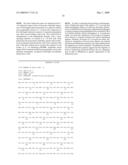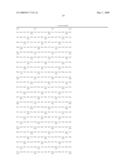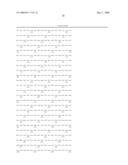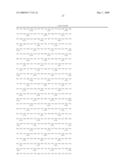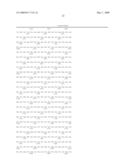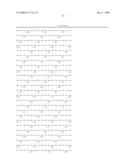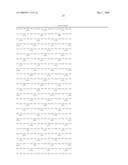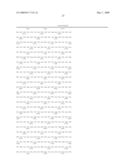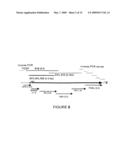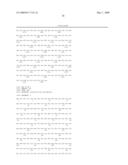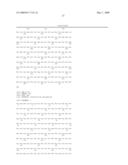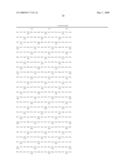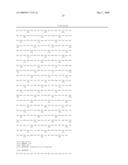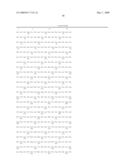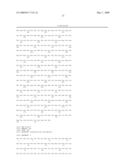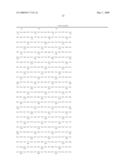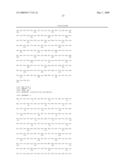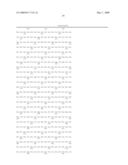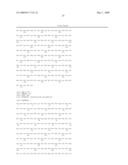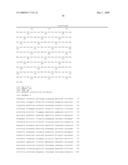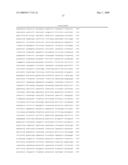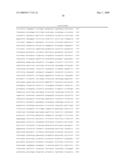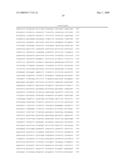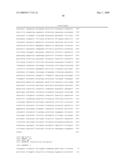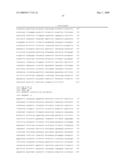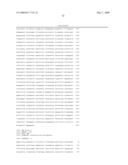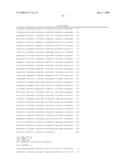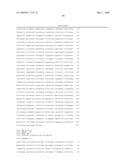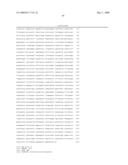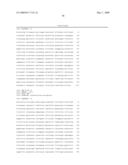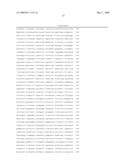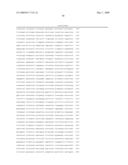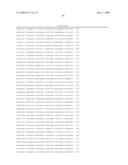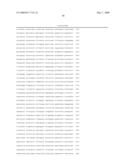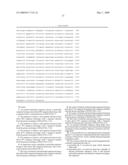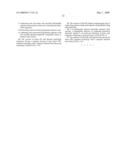Patent application title: RECOMBINANT FUSOBACTERIUM NECROPHORUM LEUKOTOXIN VACCINE AND PREPARATION THEREOF
Inventors:
Tiruvoor G. Nagaraja (Manhattan, KS, US)
George C. Stewart (Columbia, MO, US)
Sanjeev K. Narayanan (Manhattan, KS, US)
Muckatira M. Chengappa (Manhattan, KS, US)
Assignees:
Kansas State University Research Foundation
IPC8 Class: AA61K39114FI
USPC Class:
4241901
Class name: Antigen, epitope, or other immunospecific immunoeffector (e.g., immunospecific vaccine, immunospecific stimulator of cell-mediated immunity, immunospecific tolerogen, immunospecific immunosuppressor, etc.) amino acid sequence disclosed in whole or in part; or conjugate, complex, or fusion protein or fusion polypeptide including the same disclosed amino acid sequence derived from bacterium (e.g., mycoplasma, anaplasma, etc.)
Publication date: 2009-05-07
Patent application number: 20090117142
Claims:
1. An isolated nucleotide sequence having a nucleotide sequence having at
least about 50% sequence homology with a sequence that is a truncated
form of SEQ ID No. 8.
2. The sequence of claim 1, said sequence having at least about 60% sequence homology with a sequence selected from the group consisting of SEQ ID Nos. 8-14.
3. The sequence of claim 1, said sequence having at least about 75% sequence homology with a sequence selected from the group consisting of SEQ ID Nos. 8-14.
4. The sequence of claim 1, said sequence having at least about 87% sequence homology with a sequence selected from the group consisting of SEQ ID Nos. 8-14.
5. The sequence of claim 1, said sequence having at least about 95% sequence homology with a sequence selected from the group consisting of SEQ ID Nos. 8-14.
6. An expression vector containing a nucleotide sequence having at least about 50% sequence homology with a truncated sequence from SEQ ID No. 8.
7. The vector of claim 6, said nucleotide sequence having at least about 60% sequence homology with a sequence selected from the group consisting of SEQ ID Nos. 8-14.
8. The vector of claim 6, said nucleotide sequence having at least about 75% sequence homology with a sequence selected from the group consisting of SEQ ID Nos. 8-14.
9. The vector of claim 6, said nucleotide sequence having at least about 87% sequence homology with a sequence selected from the group consisting of SEQ ID Nos. 8-14.
10. The vector of claim 6, said nucleotide sequence having at least about 95% sequence homology with a sequence selected from the group consisting of SEQ ID Nos. 8-14.
11. An isolated nucleotide sequence which differs from that of claim 1 due to a mutation event selected from the group consisting of point mutations, deletions, insertions and rearrangements.
12. A vaccine effective for conferring protective immunity against F. necrophorum comprising the protein expressed by a portion of SEQ ID No. 8 and a suitable pharmacologically compatible carrier.
13. The vaccine of claim 12, said vaccine being prepared by a method comprising the steps of:a) providing the F. necrophorum gene which expresses leukotoxin;b) truncating said F. necrophorum gene into a plurality of discrete nucleotide sequences, each of said discrete nucleotide sequences encoding for a respective polypeptide sequence;c) expressing and recovering said encoded polypeptide sequence expressed by at least one of said discrete nucleotide sequences;d) inactivating said recovered polypeptide sequence; ande) combining said inactivated polypeptide sequence with said suitable pharmacologically compatible carrier to produce said vaccine.
14. The vaccine of claim 13, said discrete nucleotide sequences having a sequence having at least about 50% sequence homology with a sequence selected from the group consisting of SEQ ID Nos. 9-14.
15. The vaccine of claim 13, further comprising the step of expressing and recovering said respective polypeptides using said nucleotide.
16. A recombinantly derived nucleotide sequence than encodes a polypeptide effective in conferring protective immunity against F. necrophorum infections in mice, said sequence comprising a truncated form of SEQ ID No. 8.
17. The sequence of claim 16, said sequence having at least about 50% sequence homology with a sequence selected from SEQ ID Nos. 9-14.
Description:
CROSS-REFERENCE TO RELATED APPLICATIONS
[0001]This application is a divisional application of application Ser. No. 09/841,786 filed Apr. 24, 2001 which was a continuation-in-part application to application Ser. No. 09/558,257, Filed Apr. 25, 2000. The content and teachings of each of these applications is hereby incorporated by reference herein.
SEQUENCE LISTING
[0002]A printed Sequence Listing accompanies this application, and also has been submitted with identical contents in the form of a computer-readable ASCII file on a floppy diskette with application Ser. No. 09/558,257, filed Apr. 25, 2000. Use of this previously filed CRF sequence listing is requested.
BACKGROUND OF THE INVENTION
[0003]1. Field of the Invention
[0004]The present invention is concerned with methods of cloning and expressing the leukotoxin gene from Fusobacterium necrophorum (F. necrophorum), sequencing and characterizing the leukotoxin protein expressed by this gene, truncating the gene into a series of nucleotide sequences, amplifying these sequences, expressing and recovering the polypeptides encoded by the nucleotide sequences, and utilizing the protein and the polypeptides in recombinant vaccines in order to confer effective immunity against infection caused by the production of leukotoxin by F. necrophorum. More particularly, it is concerned with production of an inactivated recombinant leukotoxin vaccine generated by amplifying five leukotoxin gene fragments and one upstream region through PCR, digesting the nucleotide sequences encoded by the gene fragments with restriction enzymes, expressing the polypeptide sequences coded by the nucleotide sequences through an expression vector, recovering these proteins as five truncated leukotoxin proteins (or polypeptides), purifying these proteins (or polypeptides) to apparent homogeneity, with or without inactivation of the truncated and full length proteins, and combining the inactivated recombinant leukotoxins with adjuvants.
[0005]2. Description of the Prior Art
[0006]Liver abscesses in feed lot cattle are a serious economic problem, causing condemnation of over 3 million livers and an estimated loss of $15 million annually in the United States. This estimate is based primarily on condemnation of liver and other organs, and does not include economic losses stemming from reduced feed intake, reduced feed efficiencies, decreased carcass dressing percentage and lowered weight gains. A number of studies have confirmed that cattle with abscessed livers gain less (average 4-5%) and have reduced feed efficiencies (average 7%) compared with cattle having healthy livers. The average incidence of abscessed liver in grain-fed cattle approximates 25-30%. To a lesser extent, liver abscesses in sheep and goats are also an economic problem.
[0007]F. necrophorum is a gram-negative, rod-shaped, nonsporeforming, nonmotile, strictly anaerobic and pleomorphic organism. Morphologically, the organism varies from short rods to filamentous with pointed and rounded ends. Cell lengths range from coccoid bodies of 0.5-0.7 μm in diameter to filaments over 100 μm. Surface colonies are 1-2 mm in diameter, circular, transparent to opaque, and with some strains producing α or β hemolysis. The organism ferments glucose, fructose and maltose only weakly with final pH around 5.0-6.3. It ferments lactate to acetate, propionate, and butyrate. Butyrate is the major product from lactate fermentation. Indole is produced from peptone. F. necrophorum has been isolated from the normal flora in the oral cavity, gastrointestinal cavity, and genitourinary tract of humans and animals. The organism is also known to survive in the soil.
[0008]F. necrophorum is a normal inhabitant of the gastrointestinal tracts of animals and humans. Virulence factors and pathogenic mechanisms that contribute to the transition of this otherwise commensal organism to a pathogen are poorly understood. A leukotoxin, endotoxin, hemolysin, hemagglutinin, and several enzymes such as deoxyribonuclease and proteases have been suggested as possible virulence factors. However, several studies implicate leukotoxin, a protein cytotoxic to ruminant polymorphonuclear cells, as the major virulence factor. The importance of leukotoxin as a virulence factor in F. necrophorum infections is indicated by a correlation between toxin production and ability to induce abscesses in laboratory animals, an inability of nonleukotoxin-producing strains to induce foot abscesses in cattle following intradermal inoculation, and a relationship between antileukotoxin antibody titers and protection against infection in experimental challenge studies.
[0009]F. necrophorum is an opportunistic pathogen that is the primary etiologic agent of liver abscesses in ruminant animals. (Scanlan, et al., (1983) Bovine rumenitis-liver abscess complex: a bacteriological review. Cornell Vet. 73:288-297; Nagaraja, T. G. et al., (1998) Liver abscesses in feedlot cattle: A review. J. Anim. Sci., 76:287-298; and Tan, et al., (1996) Fusobacterium necrophorum infections: virulence factors pathogenic mechanism and control measures. Vet. Res. Comm., 20:113-140). The organism has been recognized as an animal and human pathogen since the late 1800s, and is associated as a primary or secondary etiologic agent with numerous necrotic disease conditions in domestic and wild animals. In addition to liver abscesses, the organism is also the primary etiologic agent of foot rot, foot abscesses, calf diphtheria, and is frequently isolated from cases of mastitis, metritis, and necrotic lesions of the oral cavity.
[0010]Liver abscesses in cattle are part of a disease complex where the abscessation is secondary to primary foci of infection in the rumen epithelium. The pathogenesis can be summarized as follows: (1) ruminal lesions are induced by acidosis that follows rapid change in diet from high-roughage to high grain, prolonged feeding of high grain diet, or occasionally by foreign body penetration of the rumen epithelium; (2) bacteria present in the rumen invade the epithelium and form focal abscesses in the rumen wall; and (3) bacteria enter the portal circulation, and are carried to the liver where they localize in the parenchyma with subsequent abscess formation.
[0011]The ability of F. necrophorum to establish in the liver is attributed to the production of a toxin which is a secreted protein of high molecular weight active against leukocytes from ruminants called leukotoxin (or leucocidin). The toxin is a soluble extracellular protein that is cytotoxic to neutrophils, macrophages, hepatocytes, and ruminal cells. The leukotoxin protects against phagocytosis and is believed to aid in the establishment of F. necrophorum in the liver by directly impairing the normal defense mechanism and indirectly by the damage caused by cytolytic products released from neutrophils and macrophages to the hepatic cells. Therefore, the leukotoxin elaborated from F. necrophorum plays a critical role in F. necrophorum infection of the liver and is believed to be the primary virulence factor in the pathogenesis of liver abscesses (Tan et al., 1996).
[0012]Four biotypes (A, B, AB and C) of F. necrophorum have been described. (Langworth, (1977) Fusobacterium necrophorum: its characteristics and role as an animal pathogen. Bacteriol. Rev. 41:373-390) Biotype A, most frequently isolated from liver abscesses, is more pathogenic than biotype B, which predominates in ruminal wall abscesses. Biotypes AB and C are rarely isolated in liver abcesses (Berg, et al., (1982) Studies of Fusobacterium necrophorum from bovine hepatic abscesses: Biotypes guantitation, virulence, and antibiotic susceptibility. Am. J. Vet. Res. 43:1580-1586), and biotype A has pathogenicity intermediate that of biotypes A and B while biotype C is non-pathogenic. (Shinjo, et al., (1990) Recognition of biovar C of Fusobacterium necrophorum (flugge) Moore and Holdeman as Fusobacterium pseudonecrophorum sp. nov.nom.rev. (ex prevot 1940) Int. J. Sys. Bacteriol. 41:395-397) Biotypes A and B, the most frequent types encountered in liver abscesses, have been assigned subspecies status: subsp. necrophorum and subsp. funduliforme, respectively (Shinjo et al., 1990). The subsp necrophorum is more virulent, produces more leukotoxin and hemagglutinin, and is more frequently isolated from cattle liver abscesses than the subsp. funduliforme. Virulence factors and pathogenic mechanisms contributing to the formation of liver abscesses by F. necrophorum are poorly understood (Tan et al., 1996). However, several studies implicate leukotoxin to be a major virulence factor (Emery, et al., (1986) Generation of immunity against Fusobacterium necrophorum in mice inoculated with extracts containing leukotoxin. Vet. Microbiol. 12:255-268; Tan et al., 1996). The importance of leukotoxin is evidenced by correlation between toxin production and ability to induce abscesses in laboratory animals (Coyle-Dennis, et al., (1979) Correlation between leukocidin production and virulence of two isolates of Fusobacterium necrophorum. Am. J. Vet. Res. 40:274-276; Emery and Vaughn, 1986), inability of nonleukotoxin-producing strains to induce foot abscesses in cattle following intradermal inoculation (Emery, et al., (1985) Culture characteristics and virulence of strains of Fusobacterium necrophorum isolated from feet of cattle and sheep. Australian Vet. J. 62:43-46) and relationship between antileukotoxin antibody titers and protection in experimental challenge studies (Saginala, et al., (1996a) The serum neutralizing antibody response in cattle to Fusobacterium necrophorum leukotoxoid and possible protection against experimentally induced hepatic abscesses. Vet. Res. Comm., 20:493-504; Saginala, et al., (1996b) The serum neutralizing antibody response and protection against experimentally induced liver abscesses in steers vaccinated with Fusobacterium necrophorum. Am. J. Vet Res., 57:483-488; and Shinjo, et al., (1991) Proposal of two subspecies of Fusobacterium necrophorum (Flugge) Moore and Holdeman: Fusobacterium necrophorum subsp. necrophorum subsp.nov.,nom.rev. (ex Flugge 1886), and Fusobacterium necrophorum subsp. funduliforme subsp.nov.nom.rev. (ex Hall 1898). Int. J. Sys. Bacteriol. 41:395-397).
[0013]Several investigators have attempted to induce protective immunity against F. necrophorum by using a variety of antigenic components. The results of such attempts have varied from ineffectual to significant protection. Clark et al. reported that cattle injected with F. necrophorum culture supernatant containing leukotoxin had a low incidence of foot rot caused by F. necrophorum. (Clark, et al. (1986), Studies into immunization of cattle against interdigital necrobacillosis. Aust. Vet. J. 63:107-110) Cell-free culture supernatant of a high leukotoxin producing strain of F. necrophorum (Tan et al., (1992) Factors affecting leukotoxin activity of F. necrophorum. Vet. Microbiol. 33: 15-28), mixed with an adjuvant, was shown to elicit a high antileukotoxin antibody titer when injected in steers and provided significant protection to experimentally induced liver abscesses (Saginala et al., 1996a, b; 1997). F. necrophorum bacterin was used as an agent for immunizing cattle and sheep against liver necrosis as shown in EPO Application No. 460-480 of Dec. 11, 1991 (the teachings of which are incorporated herein by reference). Specifically, virulent F.-necrophorum isolates are inactivated using β-propiolactone, followed by addition of adjuvants. In addition, Abe et al., Infection and Immunity, 13:1473-1478, 1976 grew F.-necrophorum for 48 hours. Cells were obtained by centrifuging, washing three times with saline, and were inactivated with formalin (0.4% in saline). The inactivated cells were then injected into mice to induce immunity. Two weeks after the last booster injection, each mouse was challenged with viable cells of F. necrophorum. The mice immunized with killed cells and challenged with live cells had no detectable bacteria in the liver, lung or spleen for up to 28 days. It was concluded that immunization of mice with formalin-killed F.-necrophorum conferred protection against infection. Garcia et al. (Canadian J. Comp. Med, 38:222-226, 1974), conducted field trials to evaluate the efficacy of alum-precipitated toxoids of F. necrophorum. The vaccine preparation consisted of washed cells (unlikely to contain leukotoxin) that were ruptured by sonication. The most promising result was achieved with the injection of 15.5 mg protein of cytoplasmic toxoid. In this group, the incidents of liver abscesses was reduced to 10% from an average 35% in the control group. Emery et al., Vet. Microbiol., 12:255-268, 1986, prepared material by gel filtration of 18-hour culture supernate of F. necrophorum. This elicited significant immunity against challenge by with viable F. necrophorum. The injected preparation contained endotoxin and the majority of the leukotoxic activity. U.S. Pat. No. 5,455,034 (the teachings of which are incorporated herein by reference) by Nagaraja et al. disclosed that prevention of leukotoxin production (or inhibition of its activity) in immunized animals prevents the establishment of F. necrophoruim infection. Thus, immunization of the animals against F.-necrophorum leukotoxin, so that the animals' white blood cells or tissue macrophages may phagocytize the bacteria, presented a way to prevent diseases associated with F. necrophorum infection, e.g., liver abscesses in cattle and sheep, and foot rot in cattle. In order to produce such a leukotoxoid vaccine, the F. necrophorum bacteria was cultured in a way to enhance the elaboration of leukotoxin in the supernate. Thereupon, bacterial growth and leukotoxin elaboration was terminated, and a vaccine prepared by inactivating at least the leukotoxin-containing supernate. In more detail, the leukotoxin elaboration method of the '034 patent involved first forming a culture of F. necrophorum bacteria in growth media, and thereafter causing the bacteria to grow in the culture and to simultaneously elaborate leukotoxin in the supernate. At the end of the culturing step, i.e., at the end of the selected culture time within the range of from about 4-10 hours, the bacterial growth and leukotoxin elaboration were terminated, and the leukotoxoid vaccine was prepared. This involved first separating the leukotoxin-containing supernate from the bacteria, followed by inactivation through use of formalin, 13-propiolactone, heat, radiation or any other known method of inactivation. Alternately, the entire culture could be inactivated to form the vaccine.
[0014]Presently, the control of liver abscesses is with the use of antimicrobial feed additives. Antimicrobial compounds reduce the incidence of liver abscesses but do not eliminate the problem (Nagaraja et al., 1998). Therefore, an effective vaccine would be highly desirable to the feedlot industry. The vaccine approach also would alleviate public health concerns associated with the use of subtherapeutic levels of antibiotics in the feed. Because studies have indicated that antileukotoxin immunity reduces the incidence of hepatic abscesses and interdigital necrobacillosis (Garcia et al., 1974; Clark et al., 1986; Saginala et al., 1996a, b; 1997), the development of a recombinant leukotoxin vaccine will be of great value in the control of hepatic and interdigital necrobacillosis in cattle.
SUMMARY OF THE INVENTION
[0015]In order to better define the molecular nature of the F. necrophorum leukotoxin, and as a first step toward determining its specific role in the virulence of this bacterium, the leukotoxin gene was isolated, its nucleotide sequence determined, and the recombinant leukotoxin was expressed in E. coli.
[0016]The leukotoxin open reading frame (lktA) is part of a multi-gene operon containing 9,726 bp, and encoding a protein containing 3,241 amino acids with an overall molecular weight of 335,956 daltons. F. necrophorum leukotoxin is highly unstable as evidenced by western blot analysis of native leukotoxin (culture supernatant, sephadex gel or affinity purified) (FIG. 1). In this Figure, lane 1 contains whole cell lysate of E. coli cells expressing full-length recombinant leukotoxin, lane 2 contains Immuno-affinity purified native leukotoxin, lane 3 contains Sephadex gel purified leukotoxin, and lane 4 contains culture supernatant from F. necrophorum concentrated 60 times. The blots were probed with polyclonal antiserum raised in rabbits against affinity purified native leukotoxin. Because of the apparent instability of the full-length recombinant leukotoxin protein, the protein encoded by the gene was truncated into five recombinant polypeptides (or protein fragments, BSBSE, SX, GAS, SH and FINAL) having overlapping regions by truncating the full length gene into five different sections and amplifying, expressing in E. coli, and recovering the protein or polypeptide encoded by each of these sections. These polypeptides along with the full length protein are then tested to determine their immunogenicity and protective immunity in comparison to the efficacy of immunization conferred by inactivated native leukotoxin in F. necrophorum culture supernatant.
[0017]Specifically, the chromosomal DNA was extracted from F. necrophorum and partially digested by restriction endonucleases prior to being size-fractionated by sucrose gradient centrifugation. The 10-12 kb fragments were then ligated into a BamHI digested, dephosphorylated λZAP expression vector. Recombinant phages were infected into Escherichia coli and plated onto agar plates. Plaque lifts were performed (with polyclonal antiserum raised in rabbits against affinity purified leukotoxin) using an immunoscreening kit. Six immunoreactive recombinant phages were identified and denominated as clones 816, 611, 513, 911, 101, and 103. These clones were plaque-purified three times to ensure purity, phagemids rescued, and anti-leukotoxin immunoreactivity of the encoded proteins was confirmed. This immunoreactivity verified that the clones represented native leukotoxin F. necrophorum.
[0018]Expression of a polypeptide encoded by the 3.5 kb from the 5' end of the lktA caused immediate cessation of the growth and lysis of E. coli host cells suggesting that regions of leukotoxin could be toxic to E. coli. Of course, the objective was to create overlapping gene truncations extending over the entire lktA ORF so that the resulting polypeptide products are small and relatively stable on expression, but are large enough to be immunogenic. Also, the effectiveness of various recombinant truncated leukotoxin polypeptides alone or in combinations as immunogens and evaluated protective immunity against challenge with F. necrophorum in mice was investigated. The use of mice as an experimental model for F. necrophorum infection in cattle is well established (Abe et al., 1976; Conion et al., 1977; Smith et al., 1989; Garcia and McKay, 1978; Emery and Vaughan, 1986). Extension of the patterns of immunity and infection to cattle has shown that mice can be a valuable model to evaluate the immunogenicity and protection provided by various F. necrophorum fractions (Garcia et al., 1975; Garcia and McKay, 1978). Studies have also indicated that strains of F. necrophorum that are pathogenic in domestic animals, frequently are pathogenic in mice suggesting necrobacillosis as a disease is similar among these species of animals (Smith and Thornton, 1993).
[0019]The nucleotide sequence of the full length version of the gene is designated as SEQ ID No. 8 and the nucleotide sequences of the five truncations of the full length gene are designated as BSBSE (SEQ ID No. 9), SX (SEQ ID No. 10), GAS (SEQ ID No. 11), SH (SEQ ID No. 12), and FINAL (SEQ ID No. 13). Additionally, the nucleotide sequence of the upstream region of the full length gene is designated UPS (SEQ ID No. 14). The amino acid sequence of the full length protein encoded by the F. necrophorum gene is designated as SEQ ID No. 1 and the amino acid sequences of the truncated protein fragments respectively encoded by BSBSE, SX, GAS, SH and FINAL are designated as SEQ ID No. 2, SEQ ID No. 3, SEQ ID No. 4, SEQ ID No. 5, and SEQ ID No. 6. In the case of UPS, the polypeptide or truncated protein fragment encoded for by UPS is designated as SEQ ID No. 7. Finally, SEQ ID No. 15 is the full length gene sequence along with contiguous sequences.
[0020]Truncated recombinant polypeptides were purified by nickel affinity chromatography, and injected into rabbits to raise polyclonal antisera. Antibodies raised against two of the five polypeptides (BSBSE and GAS) neutralized the toxicity of F. necrophorum leukotoxin against bovine neutrophils. The effectiveness of the purified truncated polypeptides to induce a protective immunity was determined by injecting the polypeptides, individually or in mixtures, homogenized with Ribi adjuvant in mice, followed by experimental challenge with F. necrophorum. Two polypeptides (BSBSE and SH) induced significant protection in mice against F. necrophorum infection and the extent of protection was greater than the full-length native leukotoxin or inactivated culture supernatant. The study provided further credence to the importance of leukotoxin as the major virulence factor of F. necrophorum and the protein carries a domain (s) or epitope (s) that induces protective immunity against experimental infection.
[0021]The DNA and deduced amino acid sequences were compared with sequences in Genbank but no significant similarities (no sequences having greater than 22% sequence identity) were found. Thus, the F. necrophorum leukotoxin appears to be distinct from all known leukotoxins and RTX-type toxins. When the deduced amino acid sequence of the lktA region was subjected to the Kyte-Doolittle hydropathy analysis (FIG. 3), 14 sites of sufficient length and hydrophobic character to be potential membrane spanning regions, were found. Upstream to the leukotoxin ORF is an open reading frame of at least 1.4 kb in length, which is in the same orientation. It encodes a protein that has significant sequence similarity (21% or 62 out of 283 residues) to the heme-hemopexin utilization protein (UxuB) of Haemophilus infuenzae.
[0022]Bacterial leukotoxins and cytotoxins generally have molecular masses of less than 200 kDa. This includes characterized leukotoxins of Pasteurella hemolytica (104,000 kDa; 10), Staphylococcus aureus (38,000+32,000 kDa; 20), or Actinomyces actinomycetecomitans (114,000 kDa; 15) or other pore-forming toxins of gram-negative bacteria (103,000 to 198,000 kDa; 30). However, leukotoxin secreted by F. necrophorum was shown to be approximately 300 kDa in size based on sephadex column purification and SDS-PAGE analyses.
[0023]As used herein, the following definitions will apply: "Sequence Identity" as it is known in the art refers to a relationship between two or more polypeptide sequences or two or more polynucleotide sequences, namely a reference sequence and a given sequence to be compared with the reference sequence. Sequence identity is determined by comparing the given sequence to the reference sequence after the sequences have been optimally aligned to produce the highest degree of sequence similarity, as determined by the match between strings of such sequences. Upon such alignment, sequence identity is ascertained on a position-by-position basis, e.g., the sequences are "identical" at a particular position if at that position, the nucleotides or amino acid residues are identical. The total number of such position identities is then divided by the total number of nucleotides or residues in the reference sequence to give % sequence identity. Sequence identity can be readily calculated by known methods, including but not limited to, those described in Computational Molecular Biology, Lesk, A. N., ed., Oxford University Press, New York (1988), Biocomputing: Informatics and Genome Projects, Smith, D. W., ed., Academic Press, New York (1993); Computer Analysis of Sequence Data, Part I, Griffin, A. M., and Griffin, H. G., eds., Humana Press, New Jersey (1994); Sequence Analysis in Molecular Biology, von Heinge, G., Academic Press (1987); Sequence Analysis Primer, Gribskov, M. et al., eds., M. Stockton Press, New York (1991); and Carillo, H., et al. Applied Math., 48:1073 (1988), the teachings of which are incorporated herein by reference. Preferred methods to determine the sequence identity are designed to give the largest match between the sequences tested. Methods to determine sequence identity are codified in publicly available computer programs which determine sequence identity between given sequences. Examples of such programs include, but are not limited to, the GCG program package (Devereux, J., et al., Nucleic Acids Research, 12(1):387 (1984)), BLASTP, BLASTN and FASTA (Altschul, S. F. et al., J. Molec. Biol., 215:403-410 (1990). The BLASTX program is publicly available from NCBI and other sources (BLAST Manual, Altschul, S. et al., NCVI NLM NIH Bethesda, Md. 20894, Altschul, S. F. et al., J. Molec. Biol., 215:403-410 (1990), the teachings of which are incorporated herein by reference). These programs optimally align sequences using default gap weights in order to produce the highest level of sequence identity between the given and reference sequences. As an illustration, by a polynucleotide having a nucleotide sequence having at least, for example, 95% "sequence identity" to a reference nucleotide sequence, it is intended that the nucleotide sequence of the given polynucleotide is identical to the reference sequence except that the given polynucleotide sequence may include up to 5 point mutations per each 100 nucleotides of the reference nucleotide sequence. In other words, in a polynucleotide having a nucleotide sequence having at least 95% identity relative to the reference nucleotide sequence, up to 5% of the nucleotides in the reference sequence may be deleted or substituted with another nucleotide, or a number of nucleotides up to 5% of the total nucleotides in the reference sequence may be inserted into the reference sequence. These mutations of the reference sequence may occur at the 5' or 3' terminal positions of the reference nucleotide sequence or anywhere between those terminal positions, interspersed either individually among nucleotides in the reference sequence or in one or more contiguous groups within the reference sequence. Analogously, by a polypeptide having a given amino acid sequence having at least, for example, 95% sequence identity to a reference amino acid sequence, it is intended that the given amino acid sequence of the polypeptide is identical to the reference sequence except that the given polypeptide sequence may include up to 5 amino acid alterations per each 100 amino acids of the reference amino acid sequence. In other words, to obtain a given polypeptide sequence having at least 95% sequence identity with a reference amino acid sequence, up to 5% of the amino acid residues in the reference sequence may be deleted or substituted with another amino acid, or a number of amino acids up to 5% of the total number of amino acid residues in the reference sequence may be inserted into the reference sequence. These alterations of the reference sequence may occur at the amino or the carboxy terminal positions of the reference amino acid sequence or anywhere between those terminal positions, interspersed either individually among residues in the reference sequence or in the one or more contiguous groups within the reference sequence. Preferably, residue positions which are not identical differ by conservative amino acid substitutions. However, conservative substitutions are not included as a match when determining sequence identity.
[0024]Similarly, "sequence homology", as used herein, also refers to a method of determining the relatedness of two sequences. To determine sequence homology, two or more sequences are optimally aligned as described above, and gaps are introduced if necessary. However, in contrast to "sequence identity", conservative amino acid substitutions are counted as a match when determining sequence homology. In other words, to obtain a polypeptide or polynucleotide having 95% sequence homology with a reference sequence, 95% of the amino acid residues or nucleotides in the reference sequence must match or comprise a conservative substitution with another amino acid or nucleotide, or a number of amino acids or nucleotides up to 5% of the total amino acid residues or nucleotides, not including conservative substitutions, in the reference sequence may be inserted into the reference sequence.
[0025]A "conservative substitution" refers to the substitution of an amino acid residue or nucleotide with another amino acid residue or nucleotide having similar characteristics or properties including size, charge, hydrophobicity, etc., such that the overall functionality does not change significantly.
[0026]Isolated" means altered "by the hand of man" from its natural state., i.e., if it occurs in nature, it has been changed or removed from its original environment, or both. For example, a polynucleotide or polypeptide naturally present in a living organism is not "isolated," but the same polynucleotide or polypeptide separated from the coexisting materials of its natural state is "isolated", as the term is employed herein. Finally, all references and teachings cited herein which have not been expressly incorporated by reference are hereby incorporated by reference.
[0027]Preferably, sequences having at least about 50% sequence homology or at least about 60% sequence identity with any of SEQ ID Nos. 1-15 are used for purposes of the present invention. More preferably, sequences having at least about 60% sequence homology or at least about 70% sequence identity are used for purposes of the present invention. Still more preferably, sequences having at least about 75% sequence homology or at least about 85% sequence identity are used for purposes of the present invention. Even more preferably, sequences having at least about 87% sequence homology or at least about 92% sequence identity are used for purposes of the present invention. Most preferably, sequences having at least about 95% sequence homology or at least about 98% sequence identity are used for purposes of the present invention.
BRIEF DESCRIPTION OF THE DRAWINGS
[0028]FIG. 1 is a Western blot assay of native and recombinant leukotoxins.
[0029]FIG. 2 is an illustration of the full length F. necrophorum gene and a map of the truncated regions of the genes and the expression clones encoded by the truncated regions;
[0030]FIG. 3 is a Kyte-Doolittle hydropathy plot of the leukotoxin from F. necrophorum;
[0031]FIG. 4 is an illustration of the Southern Hybridization pattern of the chromosomal DNA of F. necrophorum with inserts from clones 513, 611, 816, 911, and 101;
[0032]FIG. 5 is a Kyte-Doolittle hydropathy plots of deduced amino acid sequences from the F. necrophorum leukotoxin gene wherein the lines above the plot correspond to the regions of the five truncated LktA polypeptides (BSBSE, SX, GAS, SH, and FINAL);
[0033]FIG. 6 is an illustration of the leukotoxin locus of F. necrophorum;
[0034]FIG. 7a is a Western blot analysis of truncated forms of purified recombinant leukotoxin protein probed with polyclonal antileukotoxin antiserum;
[0035]FIG. 7b is a Western blot analysis of truncated forms of purified recombinant leukotoxin protein probed with monoclonal antibody F7B10;
[0036]FIG. 7c is a Western blot of whole-cell lysates from E. coli clones expressing full-length recombinant leukotoxin probed with the monoclonal anti-leukotoxin antibody;
[0037]FIG. 8 is a graph illustrating the evaluation of leukotoxic activity by flow cytometry;
[0038]FIG. 9 is graph illustrating the toxicity of the recombinant leukotoxin and the truncated polypeptides by flow cytometry;
[0039]FIG. 10 is an illustration of the hybridization patterns of radiolabeled lktA with Southern blotted HaeIII digested restriction fragments of genomic DNAs from F. necrophorum subsp. necrophorum isolates from liver abscesses;
[0040]FIG. 11 is an illustration of the expression clones for the truncated proteins designated UPS, BSBSE, SX, GAS, SH, and FINAL;
DETAILED DESCRIPTION OF THE PREFERRED EMBODIMENT
[0041]The following examples set forth preferred embodiments of the present invention. It is to be understood, however, that these examples are provided by way of illustration and nothing therein should be taken as a limitation upon the overall scope of the invention.
Example 1
Cloning of the Leukotoxin Encoding F. necrophorum Gene
[0042]Chromosomal DNA, extracted from Fusobacterium necrophorum subsp. necrophorum, strain A25 (Hull et al., 1981, Construction and expression of recombinant plasmids encoding type 1 or D-mannose-resistant pili from a urinary tract infection Escherichia coli isolate. Infect. Immun. 33:933-938.), was partially digested with the restriction endonuclease Sau3AI, and size-fractionated by sucrose gradient centrifugation (Baxter-Gabbard, 1972, A simple method for the large scale preparation of sucrose gradients. FEBS. Lett. 20117-119). The 10-12 kb DNA fragments were ligated in BamHI-digested, dephosphorylated λZAP Express vector, packaged into lambda phage head and tail protein components (Stratagene, La Jolla, Calif.), and recombinant phages were infected into Escherichia coli XL1-Blue MRF' and plated onto agar plates. Plaque lifts were performed (with polyclonal antiserum raised in rabbits against affinity purified leukotoxin) using the Pico-blue immunoscreening kit (Stratagene, La Jolla, Calif.). Six immunoreactive Recombinant phages were identified (816, 611, 513, 911, 101, and 103; FIG. 2). These clones were plaque-purified three times to ensure purity, and anti-leukotoxin immunoreactivity of the proteins was confirmed.
Characterization of the Leukotoxin Gene
Excision of the Cloned DNA Insert Into a Phagemid Vector
[0043]The λZAP Express vector is composed of a plasmid, designated pBK-CMV, which flanks the cloned insert DNA and which can be readily excised in order to obtain a phagemid that contains the cloned insert DNA. Therefore, a recombinant phagemid containing cloned F. necrophorum DNA insert was obtained by simultaneously infecting E. coli XLOLR with ExAssist helper phage and the recombinant phage (containing the cloned F. necrophorum DNA) according to the manufacturers instructions (Stratagene, La Jolla, Calif.). Once the recombinant plasmid was recovered, the presence of the DNA insert was confirmed by restriction endonuclease digestion and agarose gel electrophoresis.
Physical Mapping of the F. necrophorum DNA Inserts
[0044]Restriction enzyme digestion and mapping of the recombinant phagemid was performed (Sambrook et al., 1989, Molecular cloning: a laboratory manual. Cold spring harbor laboratory, Cold Spring Harbor, N.Y.). Combinations of the restriction enzyme SacI, SalI, SpeI, BamHI, EcoRI, HindIII, PstI, DraI, XbaI, HaeIII, BglII, SmaI, and KpnI were used for restriction enzyme mapping since single sites for these enzymes exist in the multiple cloning site of pBK-CMV. Insert DNA from all the six immunoreactive clones contained EcoRI, PsiI, HindIII, DraI, HaeIII and BglII sites but not sites for Sac I, SmaI, SalI, XbaI, KpnI or BamHI.
Hybridization of the Cloned DNA Fragments with F. necrophorum Chromosomal DNA
[0045]Southern hybridization (Southern, 1975, Detection of specific sequences among DNA fragments separated by gel electrophoresis. J. Mol. Biol. 98:503) experiments were performed to confirm that the cloned DNA encoding the putative leukotoxin gene originated from F. necrophorum strain A25. Inserts from clones 513, 611, 816 and 911 were separated from the vector sequence by agarose gel electrophoresis of DNA digested with restriction enzymes SalI and XbaI. The insert DNA was used as a probe to hybridize to chromosomal DNA of F. necrophorum digested with EcoRI, EcoRV, HaeIII, and HindIII. A negative control, E. coli DH5αDNA, was digested with EcoRV. The Southern hybridization patterns included common DNA fragments indicating that the six clones carried overlapping inserts (FIG. 4). FIG. 2 illustrates the overlapping of each of the six immunoreactive clones designated 816, 611, 513, 911, 101, and 103. The expression clones for truncated peptides are designated UPS, BSBSE, SX, GAS, SH, and FINAL while the numbers in parentheses indicate the size in kilo-bases of each insert. The overlaps illustrated in FIG. 2 were further confirmed by sequence analysis.
DNA Sequence Analysis of the F. necrophorum DNA Inserts
[0046]Subclones of the cloned insert DNAs were constructed based on the restriction enzyme map of the cloned insert. Plasmid DNA was isolated from the resulting subclones (Birnboim and Doly, 1979, A rapid alkaline extraction procedure for screening recombinant plasmid DNA. Nucleic acids Res. 7:1513) and subjected to DNA sequence analysis using the Sanger dideoxy chain termination method (Sanger et al., 1977, DNA sequencing with chain terminating inhibitors. Proc. Natl. Acad. Sci. 74:5463-5467) using vector based primers. Additional sequence data were obtained by creating deletion clones utilizing restriction endonuclease sites discovered in the preliminary sequencing or by sequencing using primers derived from the sequenced DNA.
[0047]A total of 9.3 kb of the leukotoxin chromosomal region was cloned and sequenced. A single large open reading frame (designated lktA) is common to each of the immunoreactive clones. The ORF is preceded by a ribosome binding site (RBS) sequence (AAGGGGGT). Eight base pairs following the RBS sequence is a start codon (the ninth base pair) for the open-reading frame, which is approximately 8 kb in length. The stop codon of lktA was not found in this region. Therefore, the downstream sequences were extended by inverse PCR amplification, followed by cloning and sequencing of the amplified region.
Extension of the lktA Open Reading Frame Using Inverse PCR
[0048]Chromosomal DNA from F. necrophorum strain A25 was digested with restriction endonucleases TaqI, EcoRI, DdeI, or Sau3AI individually. After complete digestion of the chromosomal DNA with any one of these enzymes, the products were extracted with phenol and chloroform, and ethanol precipitated. Under dilute conditions (100 μl final volume) 200 ng of digested DNA was self-ligated using T4 DNA ligase at 16° C. overnight (Ochman et al., 1990, Amplification of flanking sequences by inverse PCR. In: M. A. Innis, D. H. Gelfand, J. J. Sninsky, and T. J. White (eds); PCR protocols; A guide to methods and applications. Acad. Press, Inc. Harcourt Brace Jovanovich, publishers, Sandiego, 219-227). Ligated DNA was phenol and chloroform extracted, ethanol precipitated and reconstituted in 10 μl of nuclease free water. Two microliters of the ligated DNA were used as template for PCR reaction with forward and reverse primers designed based on the sequence already known to us from previous sequencing reactions. Amplified products were cloned in the pCR 2.1 plasmid vector (Invitrogen) and sequenced using vector specific sequences. Sequencing six consecutive inverse PCR products enabled us to identify the stop codon for leukotoxin gene and the presence of another ORF downstream of lktA.
[0049]The entire leukotoxin gene was amplified using heat-stable DNA polymerase (ExTaq) as two fragments using F. necrophorum strain A25 chromosomal DNA as the template. The 5'4.3 kb of the lktA open-reading frame encoding the N-terminal half of the leukotoxin, and the 3'5.4 kb representing the C-terminal half of the leukotoxin protein. Making use of the unique Nhe I site present at this location (4.3 kb from the start codon), the leukotoxin gene was joined together to give the giant 9.726 kb ORF. The entire leukotoxin gene was cloned into the modified variant (with coding sequence for six histidine residues in the N-terminus of the expressed protein) of the expression vector pET 14b (Novagen Corp. Madison, Wis.). This T7 polymerase based system should enhance expression of toxic proteins, without damage to the host cell E. coli.
Example 2
Preparation of Polyclonal Antileukotoxin Antiserum
[0050]Leukotoxin from F. necrophorum subsp.necrophorum strain A25 was purified using an immunoaffinity column containing antileukotoxin monoclonal antibody, F7B10 (Tan, Z. L., T. G. Nagaraja, M. M. Chengappa, J. J. Staats. 1994. Purification and quantification of Fusobacterium necrophorum leukotoxin using monoclonal antibodies. Vet. Microbiol. 42:121-133.). Affinity-purified native leukotoxin (0.5 mg) in 100 μl of PBS was homogenized with an equal volume of Freund's complete adjuvant and injected intramuscularly in rabbits. A booster dose was given on day 21 with 0.5 mg of native toxin in 100 μl of PBS homogenized with an equal volume of Freund's incomplete adjuvant. Serum samples were collected on day 42. Naturally occurring rabbit antibodies that react to E. coli proteins were removed from the antisera as follows. Cell pellets of E. coli XL1-Blue MRF' host cells grown overnight in Luria broth were sonicated in PBS and centrifuged to remove cellular debris, and the supernatant was incubated with 100 mm diameter nitrocellulose membranes at 37° C. for 3 hours. The nitrocellulose membranes were then washed twice in PBS-T (0.05% Tween 20 in PBS [pH 7.2]), blocked in 2% BSA, and washed three times again in PBS-T. Two ml of rabbit antileukotoxin polyclonal antiserum were diluted 10-fold in PBS-T containing 0.2% BSA and exposed to 10 changes of E. coli lysate-treated nitrocellulose membranes for 30 minutes duration each at 37° C. The resultant polyclonal antisera had minimal reactivity against E. coli proteins. Neutralizing activity of the serum, as determined by the MTT dye neutralization test and the indirect ELISA titer, were measured as described previously (Tan, Z. L., T. G. Nagaraja, M. M. Chengappa. 1992. Factors affecting leukotoxin activity of Fusobacterium necrophorum. Vet. Microbiol 33:15-28; Tan, Z. L., T. G. Nagaraja, M. M. Chengappa, and J. S. Smith. 1994. Biological and biochemical characterization of Fusobacterium necrophorum leukotoxin. Am. J. Vet. Res. 55:515-519; Tan, Z. L., T. G. Nagaraja, M. M. Chengappa, J. J. Staats. 1994. Purification and quantification of Fusobacterium necrophorum leukotoxin using monoclonal antibodies. Vet. Microbiol. 42:121-133).
Extraction of Genomic Dna from F. Necrophorum and E. Coli
[0051]Chromosomal DNA was extracted from highly virulent F. necrophorum subsp. necrophorum, strain A25 (18) and E. coli DH5α (F-X-φ80 Δ[lacZYA-argF] endA1 recA1 hsdR17deoR thi-1 supE44 gyrA96 relA1), using a modification of the method described by Hull and coworkers (Hull, R. A., R. E. Gill, P. Hsu, B. H. Minshew, and S. Falkow. 1981. Construction and expression of recombinant plasmids encoding type 1 or D-mannose-resistant pili from a urinary tract infection Escherichia coli isolate. Infect. Immun. 33:933-938). E. coli was cultured in Luria broth with shaking under aerobic conditions at 37° C. and F. necrophorum was grown overnight in a prereduced anaerobically sterilized brain heart infusion broth in serum bottles under anaerobic conditions at 39° C. Cell pellets were resuspended in TES buffer (25% sucrose, 50 mM Tris-HCl [pH 7.5] and 1 mM EDTA); spheroplasted with lysozyme at room temperature for 30 min; and lysed using sarkosyl in the presence of proteinase K at 60° C. for 1 hour. The product was extracted with buffer-saturated phenol and chloroform, and the DNA was precipitated in 2.5 volumes of ice-cold ethanol. The DNA pellet was resuspended in TE buffer (10 mM Tris-HCl [pH 8.0] and 1 mM EDTA) and subjected to ultracentrifugation in a cesium-chloride step-gradient (43.5% to 60%) containing ethidium bromide (0.4 mg/ml final volume). The chromosomal DNA band was extracted with TE buffer and CsCl saturated isopropanol to remove ethidium bromide and dialyzed against double-distilled water. The DNA concentration and purity were checked spectrophotometrically.
Genomic Library and Screening
[0052]Genomic DNA of F. necrophorum A25 was digested partially with restriction endonuclease Sau3AI, and the fragments were size-fractionated in a sucrose gradient. Ten to 12 kb fragments were cloned into BamHI digested and alkaline phosphatase-treated Lambda zap Express vector (Stratagene Corp. La Jolla, Calif.) as per the manufacturer's instructions. Recombinant lambda DNA was packaged (Gigapack gold; Stratagene) and used to infect XL I Blue MRF' host cells (Stratagene). Plaques were lifted onto nitrocelluose membrane and screened with antileukotoxin polyclonal antiserum using a Picoblue immuno-screening kit as per the manufacturer's protocol (Stratagene). Immunoreactive clones were plaque purified three times using the polyclonal antiserum. The recombinant DNA from immunoreactive clones was rescued as phagemid (pBKCMV) clones using Exassist helper phage in E. coli XLOLR strain as per the manufacturer's protocol (Stratagene).
DNA Sequencing Analysis
[0053]Phagemids from immunoreactive clones, purified PCR products, and plasmid subclones were sequenced using vector-specific or internal primers with a model 373A automated DNA sequencer (Applied Biosystems, Foster City, Calif.). The DNA sequences were aligned and analyzed using Sequencher (version 3.1.1, Gene Codes Corp., Ann Arbor, Mich.) and DNA Strider (Version 1.2).
Inverse Pcr and Sequence Extension
[0054]Chromosomal DNA from F. necrophorum strain A25 was digested singly with restriction endonucleases TaqI, EcoRI, DdeI, or Sau3AI. After complete digestion of the chromosomal DNA with any one of these enzymes, the products were extracted with phenol and chloroform, and precipitated with ethanol. Under dilute conditions (200 ng of digested DNA in 100 μml total volume), DNA was self-ligated using T4 DNA ligase at 16° C. overnight. Ligated DNA was extracted with phenol and chloroform, precipitated with ethanol and reconstituted in 10 ml of nuclease free water. Two microliters of the ligated DNA were used as templates for 100 ml PCR reactions with forward and reverse primers designed based on the sequence obtained from previous sequencing reactions. The products from inverse PCR were cloned in pCR TOPO cloning vectors (TA, Blunt2 or Blunt4) as per the manufacturer's instructions (Invitrogen Corp. San Diego, Calif.), and sequenced directly or after subcloning, using vector specific primers. Six successive inverse PCRs were carried out to reach the 3' end of the leukotoxin gene.
Creation of Gene Truncations
[0055]Polymerase chain reaction using thermostable polymerase (EXTaq; Takara Corporation, Madison, Wis.) was used to amplify five overlapping regions of the leukotoxin gene ranging in size from 1.1 kb to 2.8 kb. Chromosomal DNA from F. necrophorum strain A25 was used as the template. The forward primers were designed to contain a SacI site, and the reverse primers had an XmaI site, for in-frame insertion into the His-tag expression vector pQE30 (Qiagen Inc. Valencia, Calif.). Each truncated gene product overlapped with the adjacent product by at least 100 bp. One kb of DNA from the 3' end of the upstream open reading frame (ups) was amplified and cloned in pQE30 vector as described above. Recombinant plasmids were transformed into E. coli host strain M15 for inducible expression of proteins encoded by cloned genes under the control of the lac promoter. The five truncated leukotoxin polypeptides and the C-terminus of the upstream polypeptide were purified using nickel chelation chromatography under denaturing conditions to apparent homogeneity as indicated by silver-stained SDS-PAGE gels (data not shown).
Preparation of Polyclonal Antiserum Against the Truncated Leukotoxin Polypeptides
[0056]New-Zealand White rabbits were injected intramuscularly with the five truncated leukotoxin polypeptides or the upstream polypeptide (0.5 mg/animal) precipitated with aluminum hydroxide. A booster dose was given on day 21 (0.5 mg/animal). Serum samples were collected on days 21 and 42 and antileukotoxin titers were determined by indirect ELISA using affinity purified native leukotoxin (Tan, Z. L., T. G. Nagaraja, M. M. Chengappa, J. J. Staats. 1994. Purification and quantification of Fusobacterium necrophorum leukotoxin using monoclonal antibodies. Vet. Microbiol. 42:121-133.). Leukotoxin neutralizing activities of the 42 day serum samples were determined by the MTT dye neutralization assay using 200 units of toxin (id.).
Immunoblot Analysis
[0057]Affinity-purified native leukotoxin, the truncated leukotoxin polypeptides and upstream polypeptide purified over nickel columns, whole cell lysates from bacterial clones carrying recombinant expression plasmids, and concentrated culture supernatants were resolved by SDS-PAGE (6 or 10% acrylamide) and electroblotted to nitrocellulose membranes (BioRad minigel II electrophoresis and transfer unit). Monoclonal antibody against native leukotoxin (F7B10) or polyclonal antisera raised against native leukotoxin, various truncated leukotoxin or upstream polypeptides were used to probe the western blotted proteins. Goat antimouse or antirabbit IgG conjugated to alkaline phosphatase (Sigma Chemical Company, St. Louis, Mo.) was used as the secondary antibody, and the immunoreactive proteins were detected using nitro blue tetrazolium and 5-bromo-4-chloro-3-indolyl-phosphate as substrates.
Cloning and Expression of Full-Length Leukotoxin ORF
[0058]A 4.3 kb DNA fragment containing the 5' end of the lkta open reading frame up to the internal NheI restriction endonuclease recognition site was amplified from A25 chromosomal DNA. This fragment was cloned into the kanamycin resistance encoding vector pCR Blut II TOPO. A 5.4 kb DNA fragment extending from the NheI site to the 3' end of the lktA open reading frame was PCR amplified and cloned into the low-copy, spectinomycin resistance plasmid pCL1921 (Lerner, C. G., and M. Inouye. 1990. Low copy number plasmids for regulated low level expression of cloned genes in Escherichia coli with blue/white insert screening capability. Nuc. Acid. Res. 18:4631-4633.). The two resulting plasmid clones were ligated together making use of the unique NheI site present in lktA ORF, and the transformants were selected on media containing spectinomycin (100 μg/ml) and kanamycin (21 μg/ml). The pCR Blunt II vector specific sequences were then removed by digesting the resultant plasmid with SacI followed by ligation under dilute conditions and selection on L-agar containing 100 μg/ml spectinomycin. Thus the entire 9,726 base pairs of the leukotoxin ORF were cloned in a low-copy number plasmid pCL1921 to produce pSN1999. Making use of the unique XmaI site introduced into at the 3' end of the open reading frame and the SacI site introduced into the 5' end of the reading frame, the entire lktA coding sequence was cloned in-frame into the expression plasmid pQE30 to give pSN2000.
Flow Cytometric Analysis of Leukotoxin Biological Activity
[0059]Bovine peripheral polymorphonuclear leukocytes were isolated as described previously (Tan, Z. L., T. G. Nagaraja, M. M. Chengappa. 1992. Factors affecting leukotoxin activity of Fusobacterium necrophorum. Vet. Microbiol. 33:15-28; Tan, Z. L., T. G. Nagaraja, M. M. Chengappa, and J. S. Smith. 1994. Biological and biochemical characterization of Fusobacterium necrophorum leukotoxin. Am. J. Vet. Res 55:515-519). Untreated cells (negative control) or those treated with either 200 units of native leukotoxin from F. necrophorum (positive control) or whole-cell lysates from clones expressing full-length recombinant leukotoxin were tested for viability by flow cytometry (Facstar, Becton Dickinson Immunocytometry Systems, San Jose, Calif.). Briefly, 1 ml of bovine peripheral PMNs (9×106 cells/ml) was incubated with various preparations of toxin for 45 min at 37° C. in a chamber containing 5% CO2. The cells were then washed twice in 2 ml of HBSS (pH 7.2) and resuspended in 300 μl of HBSS. These cells were treated for 10 min in the dark at room temperature with 10 μl of 5 mg/ml propidium iodide (PI). The red fluorescence (FL-2 [585/42]) is proportional to the number of cells which have lost membrane integrity and, therefore, do not exclude the propidium iodide. Leukocyte subpopulations were displayed in a dot plot and gated according to size based on forward scatter (FSC) and granularity or 90 degree light scatter (SSC). A region was placed around granulocytes, cells of larger size and granularity and thus excluding monocytes, and data were collected on 10,000 gated cells. The identity of the gated cells as granulocytes by was indicated by indirect immunofluorescence labelling with monoclonal antibody DH59B (VMRD Inc., Pullman, Washington) which reacts with the granulocyte-monocyte-1 receptor. Fluorescence signals displayed as a dot plot were used to determine the percent positive cells by quadrant statistics.
Southern Blot Analysis
[0060]Genomic DNA was extracted from several strains of F. necrophorum subsp. necrophorum and subsp. funduliforme isolated from ruminal contents or liver abscesses. Chromosomal DNA was digested to completion with HaeIII, which cleaves the leukotoxin ORF once. The digested DNA was electrophoresed in a 1% agarose gel and Southern blotted onto a nitrocellulose membrane. The full-length lktA ORF cloned in pQE30 (pSN2000) was released by digestion with SacI and XmaI, and the insert DNA was gel purified, radiolabelled with [α-35S]dATP, and hybridized.
Nucleotide Sequence Accession Number
[0061]The nucleotide sequence of F. necrophorum subsp. necrophorum strain A25 lktA has been assigned GenBank accession number AF312861.
Cloning and Nucleotide Sequence of the F. Necrophorum Leukotoxin Determinant
[0062]A Sau3A-generated genomic library of F. necrophorum strain A25 DNA was screened using rabbit polyclonal antisera raised against immunoaffinity-purified native leukotoxin and immunoreactive clones were identified. The clones carried inserts of approximately 4.6, 5.5, and 6.3 kb in length. The immunoreactive clones containing the leukotoxin open reading frame (designated lktA) are depicted in FIG. 1. Inverse PCR was used to extend the cloned region to allow completion of the sequence of the lktA open reading frame. The 11,130 bp sequence of F. necrophorum DNA contained one complete and two partial ORFs. The upstream (orjB) partial ORF comprises the first 1,018 bp. The lktA ORF initiates 16 bp downstream of the lktB ochre codon. A putative ribosome-binding site (RBS) with the sequence AAGGGGGT precedes the lktA ORF. The first two bases of the RBS were the last two bases of the lktB stop codon. The leukotoxin determinant is 9,726 bp and encodes a protein of 3,241 amino acids with an overall molecular weight of 335,956. The deduced protein sequence is unusual in that it lacks cysteine residues. The protein has substantial hydrophobic character (FIG. 5) and possesses 14 regions with sufficient hydrophobic character and length to be membrane spanning. However, this is a secreted toxin in F. necrophorum. The potential transmembrane domains may provide a clue as to the mode of action of the leukotoxin on the target neutrophils.
[0063]A BLAST search of the protein database with the deduced leukotoxin did not indicate significant sequence similarity to any bacterial cytotoxins. Some sequence similarity, generally 17-20% amino acid identity over a window of 1,500 to 2,000 residues, was found to certain high molecular weight cell surface proteins. These include the SrpA serine-rich protein from Streptococcus cristatus (accession number U96166), the hemagglutinin from Streptococcus gordonii (AB029393), a surface protein from Xylella fastidiosa (AE003982), the outer membrane protein A from Rickettsia australis (AF149108), the 190 kDa surface antigen precursor from R. rickettsii (A41477), and the high molecular weight antigen (HmwA) of Haemophilus influenzae (AF180944). Given the molecular size of the leukotoxin protein, which is larger than any known bacterial exotoxin, its lack of cysteine residues, and its lack of sequence similarity to other bacterial leukotoxins, the LktA protein from F. necrophorum appears to be a novel leukotoxin.
[0064]The deduced amino acid sequence of the carboxy terminus of the OrfB protein has some sequence identity to heme-hemopexin utilization protein (HxuB) of Haemophilus influenzae (21% amino acid identity over a 283 residue window). The putative open reading frame upstream of the leukotoxin determinant does encode a protein product. The 1 kb sequence encoding the carboxyl terminus of this ORF was cloned into pQE30, and the polypeptide was expressed with the six histidine tag at its N-terminus. The protein was purified by nickel chelation chromatography, and the antiserum was raised against this protein in rabbits. Western blot analysis revealed that this antiserum recognized a 60 kDa protein in whole-cell lysates of F. necrophorum (data not shown). This protein was not present in culture supernatants or in purified outer membranes of F. necrophorum.
[0065]Downstream of lktA is another apparent open reading frame, which extends to the end of the cloned sequences (375 bp). The putative ATG start codon overlaps the opal stop codon of lktA. The nucleotide and deduced amino acid sequences do not show significant sequence similarity to any sequences currently in GenBank.
Creation of Truncated Leukotoxin Polypeptides and Characteristics of Polyclonal Antisera Raised Against Them
[0066]A 3.5 kb sequence from the 5 end of lktA gene was amplified by PCR and cloned in-frame in the expression vector pQE30. Induced expression of this truncated version of the leukotoxin protein with IPTG resulted in the immediate cessation of growth and lysis of the host E. coli cells. In order to obtain better expression of recombinant protein and less toxicity to E. coli host cells, smaller truncations of the leukotoxin gene were constructed. The truncated polypeptides were named BSBSE, SX, GAS, SH, and FINAL starting from the N-terminus and ending at the C-terminus of the leukotoxin protein (FIG. 6). In this Figure, the boxes represent the leukotoxin open reading frame (lktA) and its flanking putative open reading frames. The lines above the boxes represent the phagemid clones (816, 101, and 611) obtained from the immunoreactive plaques in the cloning experiments. The region designated iPCR represents the sequence obtained from sequencing a series of inverse PCR clones. The plasmid pSN2000 contains the entire lktA open reading frame. Below the boxes are the clones expressing the truncated leukotoxin polypeptides. The numbers refer to the nucleotide positions of the boundaries of each truncation relative to the 11,130 bp sequence deposited in GenBank.
[0067]Each polypeptide had an overlap of at least 21 amino acids with its adjacent polypeptide. The C-terminal truncated polypeptide of the upstream protein and the polyclonal antiserum raised against it, served as a negative control in our toxicity and toxin-neutralization studies. Purified truncated leukotoxin and upstream polypeptides were then analyzed by western blots, for their reactivity against polyclonal and monoclonal antisera raised against affinity-purified native leukotoxin, using western blot analysis. Antileukotoxin polyclonal antisera reacted strongly with polypeptides BSBSE, SX, and FINAL and weakly with polypeptides GAS and SH (FIG. 7a). Monoclonal antileukotoxin antibody reacted with the N-terminal polypeptide, BSBSE, but not any other truncated leukotoxin polypeptides (FIG. 7b). As expected, the UPS polypeptide did not react with polyclonal or monoclonal antileukotoxin antibodies. Polyclonal antisera raised in rabbits against each of the truncated leukotoxin polypeptides reacted strongly with the corresponding polypeptide and also the native leukotoxin. These results are shown below in Table 1. Antibodies raised against individual truncations reacted weakly to their adjacent polypeptides because of the presence of the overlapping amino acid sequences between them (data not shown). Antiserum raised against UPS (from the upstream ORF) failed to recognize the leukotoxin.
TABLE-US-00001 TABLE 1 Neutralization of Leukotoxin from F. Necrophorum by Rabbit Polyclonal Antisera Raised Against the Recombinant Truncated Polypeptides. ELISA Titer Neutralization Immunogen Self polypeptide Native Leukotoxin Titer UPS 9,600 ± 1,693 19 ± 17 <5 BSBSE 10,420 ± 1,142 10,680 ± 1,653 1,460 ±71 SX 8,754 ± 983 7,480 ± 1,593 <5 GAS 8,748 ± 865 8,100 ± 1,297 1,280 ± 89 SH 10,180 ± 1,789 8,220 ± 1,301 <5 FINAL 9,750 ± 1,343 9,440 ± 1,262 <5 ELISA titers are presented as the mean of three determinations expressed as the reciprocal of the highest dilution giving a positive reaction (± standard deviation). The neutralization titer is the reciprocal of the greatest dilution of antiserum able to neutralize the activity of 200 units of native leukotoxin in an MTT assay.
[0068]Antisera raised against the individual polypeptides were tested for neutralization activity against the native leukotoxin from F. necrophorum. An ELISA assay was utilized to measure the reactivity of each antiserum against the leukotoxin. An MTT dye reduction assay was then utilized to determine if the antiserum could neutralize the toxic effects of the leukotoxin against bovine peripheral leukocytes. As shown in Table 1, two of the antisera could neutralize the leukotoxin. The active antisera were raised against the N terminal polypeptide (BSBSE) and the middle polypeptide (GAS). The other three antisera did not have neutralizing activity in this assay, although the ELISA data indicated that each antiserum recognized the F. necrophorum leukotoxin.
Creation of Full-length Recombinant Leukotoxin and its Toxicity to Bovine Peripheral Blood Polymorphonuclear Cells
[0069]The entire leukotoxin gene (9,726 bp) was cloned into the pQE30 expression vector. Unlike certain truncated versions of the leukotoxin protein, full-length recombinant leukotoxin upon expression was not toxic to E. coli host cells. When whole-cell lysates from clones expressing full-length leukotoxin were subjected to western blot assays, both polyclonal (not shown) and monoclonal antileukotoxin antibodies reacted to high-molecular weight (>220 kDa) protein species (FIG. 7c). In this Figure, MW is molecular weight markers; Lkt, is affinity-purified leukotoxin from F. necrophorum; FL-I and FL-UI are full-length clone induced or uninduced with IPTG; Super is concentrated F. necrophorum A25 culture supernatant. Additionally, the arrows denote the positions of the reactive BSBSE band in FIG. 7b and the full-length leukotoxin in FIG. 7c. The amount of full-length leukotoxin in the culture supernatant in panel C was insufficient to be visualized as a distinct band in this blot. The protein was extremely unstable, as evident by the presence of numerous smaller molecular weight species, which presumably represent breakdown products. This instability was also observed with native leukotoxin that was immunoaffinity-purified from F. necrophorum culture supernatants. Antisera raised against all the truncated leukotoxin polypeptides, including the C-terminal FINAL polypeptide, reacted to recombinant leukotoxin suggesting that the protein may be expressed in its full-length (data not shown). As expected, antibody raised against the upstream polypeptide failed to react to the full-length recombinant leukotoxin.
[0070]Bovine peripheral polymorphonuclear leukocytes exposed to whole-cell lysates of full-length or truncated recombinant clones (12 mg/ml protein) prior to or after induction with IPTG were tested for membrane integrity using propidium iodide exclusion and flow cytometry. Control cells untreated with leukotoxin gave a baseline value of 5.4% PI-staining cells (FIG. 8). In this Figure, membrane damage was assessed by staining of the cells with propidium iodide. Shown are the values obtained after counting 10,000 PMNs (stippled bars) or the lymphocyte fraction (hatched bars). Cells were untreated (control), treated with 200 units of affinity purified leukotoxin from F. necrophorum (Fn leukotoxin) or lysates of E. coli harboring expression plasmids bearing the upstream polypeptide (pSN100) or the full-length lktA open reading frame (pSN2000). The "U" and "I" designations refer to lysates from uninduced cultures and cultures induced with 1 mM IPTG, respectively. Induced lysates were also tested after 1:5, 1:25, and 1:125 dilutions in PBS. The results shown are the averages of three experiments and the standard deviation is indicated.
[0071]The addition of 200 MTT units of affinity-purified native leukotoxin resulted in 75.4% of the PMNs taking up the dye. An MTT unit of the toxin is defined as the reciprocal of the dilution causing a 10% decrease in MTT-dye reduction activity. The affinity-purified leukotoxin preparation used in this study had an activity of 2×105 units/ml. Lysates from the clone expressing the upstream polypeptide (SN 100) did not increase the percentage of PI-staining cells, indicating that the truncated form of this protein lacked membrane-damaging activity. Whole-cell lysates from E. coli carrying recombinant full-length leukotoxin gene (SN2000), uninduced with IPTG, gave rise to 9.6% PI-staining bovine PMNs, whereas lysates from induced clones gave 27.3% staining PMNs. The low percentage of damaged cells from the uninduced lysate resulted from leaky expression of the toxin with this vector, consistent with the results obtained by western blot analysis (not shown). The membrane damaging activity in the induced lysate was proportionately lost when the samples were diluted in phosphate-buffered saline. The data indicate that recombinant full-length leukotoxin is toxic to bovine neutrophils.
[0072]Preparations of PMNs had residual contaminating cells of smaller size and granularity, which were found to be predominantly lymphocytes by immunophenotyping with anti-CD3 and anti-IgM specific monoclonal antibody. These cells were gated, and the effects of various leukotoxin preparations on the viability of these cells were measured as described for PMNs. Untreated control lymphocytes gave a baseline value of 13.6% staining cells, whereas inclusion of 200 units of affinity-purified native leukotoxin resulted in 31.3% of the lymphocytes taking up the PI (FIG. 8). The apparently lower sensitivity of lymphocytes compared to PMNs is characteristic of F. necrophorum leukotoxin. Furthermore, the recombinant toxin displayed the same degree of activity against lymphocytes as did the native leukotoxin. Among lymphocytes treated with lysates from E. coli carrying uninduced recombinant full-length lktA, 12.8% were PI-positive compared to 19.2% obtained with lysates from induced clones. Thus the expressed recombinant leukotoxin had toxicological properties similar to those of the native leukotoxin purified from F. necrophorum culture supernatant. Lysates from E. coli with IPTG-induced expression of the leukotoxin truncated polypeptides or the upstream polypeptide did not display membrane-damaging activity against either bovine PMNs or the lymphocyte-containing population (FIG. 9). In this Figure, membrane damage was assessed by staining of the cells with propidium iodide. Shown are the values obtained after counting 10,000 PMNs (stippled bars) or the lymphocyte fraction (hatched bars). Cells were untreated (control), treated with 200 units of affinity purified leukotoxin from F. necrophorum (native toxin), lysates from IPTG-induced cultures of clones expressing the truncated polypeptides (ups, BSBSE, SX, GAS, SH, and Final) or the whole recombinant leukotoxin (whole toxin). The results shown are the averages of three experiments and the standard deviation is indicated.
Presence of the Leukotoxin Determinant in F. Necrophorum Isolates
[0073]The leukotoxin gene was cloned and sequenced from F. necrophorum subsp. necrophorum A25, a strain originally isolated from a bovine liver abscess. Southern blot hybridization of the chromosomal DNA extracted from various F. necrophorum strains of both subspecies isolated from ruminal contents or liver abscesses was carried out using the leukotoxin ORF as a probe (FIG. 10). In this Figure, F. necrophorum subsp. necrophorum from liver abscesses are in lane 1 which is strain A21; lane 2 which is A25; and lane 3 which is A39. F. necrophorum subsp. necrophorum from ruminal contents are in lane 7 which is RA13; lane 8 which is RA15; lane 9 which is RA16; lane 10 which is RA18; lane 11 which is RA26; lane 12 which is RA28; and lane 13 which is RA29. The F. necrophorum subsp. funduliforme isolates from liver abscesses are in lane 4 which is B17; lane 5 which is B29; lane 6 which is B35 or ruminal contents which are in lane 14 which is RB33; and lane 15 which is RB37. Strains are described in reference 24. M, DNA molecular weight markers. The restriction endonuclease HaeIII was used to digest the chromosomal DNA from F. necrophorum isolates. A single recognition site for this enzyme occurs 5,933 bp from the start codon in the lktA ORF. Thus, two hybridizing fragments should be present in strains carrying this gene. All strains of F. necrophorum subsp. funduliforme isolated from liver abscesses (B17, B29, and B35) or ruminal contents (RB33 and RB37) were identical in their hybridization patterns showing two bands at approximately 7 and 8 kb each. Also, all isolates of F. necrophorum subsp. necrophorum, except A39, isolated from liver abscesses (A21 and A25) and those isolated from ruminal contents (RA13, RA15, RA16, RA18, RA26, RA28, and RA29) had identical hybridization patterns showing two bands of approximately 10 and 11 kb each. A single band of approximately 10.5 kb, presumably a doublet, hybridized to the leukotoxin gene in chromosomal DNA of strain A39 (FIG. 10, lane 4). This suggests that some heterogeneity may be present in the leukotoxin locus sequences among strains of F. necrophorum subsp. necrophorum. However, the hybridization pattern does appear to be a good indicator for subspecies determination.
Example 3
Construction of Truncated Forms of the Leukotoxin
[0074]A 3.5 kb sequence from the 5' end of lktA gene was amplified by PCR and cloned in-frame in the expression vector pQE 30 (Qiagen Corporation). Induced expression of this truncated version of the leukotoxin protein with IPTG resulted in the immediate cessation of growth and caused lysis of the host E. coli cells. In order to obtain better expression of recombinant protein, smaller truncations of the leukotoxin gene were constructed. Polymerase chain reaction using thermostable polymerase with proof reading ability (EXTaq; Takara Corp.) was used to amplify five overlapping regions of the leukotoxin gene. The forward primers were designed to contain a SacI site, and the reverse primers had a XmaI site. F. necrophorum A25 chromosomal DNA was used as the template, and the amplified products were digested with restriction enzymes SacI and XmaI, and cloned in-frame in the His-tag expression vector pQE 30. Five truncated leukotoxin proteins and the C-terminus of the upstream protein were purified using nickel chelation chromatography to apparent homogeneity as indicated by silver-stained SDS-PAGE gels. The proteins were then tested for their reactivity with polyclonal antisera raised in rabbits against affinity purified native leukotoxin using western blot analysis. Purified proteins were injected in rabbits to produce polyclonal antisera, which in turn were used to carry out western blot analysis and neutralization tests (Table 2). Antisera raised against each protein recognized native leukotoxin from F. necrophorum. Antisera directed against the BSBSE9 and GAS polypeptides were able to neutralize the activity of native leukotoxin. Thus the cloned ORF does indeed represent the F. necrophorum leukotoxin.
TABLE-US-00002 TABLE 2 Characterization of the Truncated Upstream and Leukotoxin Proteins Antisera Truncated Recognized by Antisera Raised Neutralizes Leukotoxin Number Anti-native Against Truncated Activity of Proteins (N to C of Amino Size (in Leukotoxin Proteins Recognized Leukotoxin terminal) Acids Daltons) Antibodies Native Leukotoxin Against PMNs UPS 9 339 38324 - - - BSBSE 9 377 40810 + + + SX7 926 97453 + + - GAS 15 713 71949 - + + SH 12 628 63457 - + - FINAL 2 774 80590 + + -
Production of an Inactivated Recombinant Leukotoxin Vaccine
[0075]The immunogenicity and protective immunity of the recombinant full length and truncated leukotoxin proteins is determined in mice and compared to the efficacy of immunization with inactivated native leukotoxin in F. necrophorum culture supernatant. The usefulness of the mouse model in studying experimental Fusobacterium infections has been well documented (Abe et al., 1986, Emery and Vaughn, 1986).
Vaccine Preparations
[0076]Purified recombinant leukotoxins (described above) including the full-length protein are inactivated by the addition of formalin (final concentration 0.3%) and homogenized with Ribi or other suitable adjuvant (10% vol/vol; Ribi Immunochem, Hamilton, Mont.). The native leukotoxoid vaccine is prepared with culture supernatant from F. necrophorum subsp. necrophorum, strain A25 grown in PRAS-BHI broth (Saginala et al., 1997). The leukotoxic activities of the recombinant leukotoxin and culture supernatant, before and after formalin inactivation, are then tested by MTT-dye reduction assay using bovine polymorphonuclear (PMN) leukocytes as target cells (Tan et al., 1992). The quantity of native leukotoxin is then assayed using a sandwich ELISA using purified monoclonal antibody (Tan et al., 1994b).
Immunogenicity of the Inactivated Recombinant Leukotoxin in Mice
[0077]Immunogenicity and protective effects of the inactivated recombinant full length, and truncated leukotoxins are evaluated in comparison with the native leukotoxin (culture supernatant of F. necrophorum, strain A25). Five overlapping truncations and the recombinant full-length leukotoxin are purified using the nickel-affinity columns. The treatment groups include control (0.2 ml PBS), native leukotoxin, recombinant full length, and truncated leukotoxins individually or in combination (all five truncations individually, and a mixture of all five truncated proteins in equimolar ratio). Additionally, a mixture of the two truncated proteins BSBSE and GAS in equimolar concentrations is tested for immunogenicity, because polyclonal antisera raised against these two proteins neutralize the activity of native leukotoxin against bovine neutrophils. Each leukotoxin preparation is tested at 10 and 50 μg doses (total protein concentration), administered subcutaneously on days 0 and 21. Six mice (7-8 wk old BALB/c) are used in each treatment group. Blood samples are collected on days 0, 14, 21, 35, and 42. Serum is stored at -70° C. until assayed for antileukotoxin antibody. After the last blood sampling (on day 42), mice are challenged intraperitoneally with 0.4 ml of late-log phase F. necrophorum strain A25 culture (6-7 hour culture in PRAS-BHI broth with an absorbance of 0.65 at 600 nm and with a cell concentration of approximately 1 to 5×108 CFU/ml). The number of bacteria used for inoculation is enumerated by viable counts on blood agar plates in an anaerobic glove Box (Form a Scientific, Marietta, Ohio). Mice are observed for 4 days after challenge to record mortality and clinical signs, and those that survive the challenge are euthanized. Mice are then necropsied and examined grossly for abscesses in the liver. Additionally, other organs and liver tissue will be cultured for anaerobic bacterial isolation.
[0078]Following this study, the efficacious dose and the recombinant leukotoxin preparation is selected and one more immunization and challenge study in mice to confirm the protective effect of recombinant leukotoxin is conducted. Groups of 7-8 week old BALB/c mice (10 per group) are used and each group receives one of the following leukotoxin preparations: most immunogenic recombinant leukotoxin protein, combination (two or more) of most immunogenic recombinant leukotoxin proteins, and native leukotoxin (F. necrophorurm culture supernatant). The leukotoxin proteins are inactivated with 0.3% formalin, mixed with Ribi or any other suitable adjuvant and emulsified with a homogenizer and administered subcutaneously on days 0 and 21. Blood samples are collected on days 0, 14, 21, 35 and 42. Serum samples are assayed for antileukotoxin antibody. After the last blood sampling (on day 42), mice are challenged as described above. Overlapping variants of effective polypeptides (the truncated protein fragments) are identified and are constructed in order to identify the polypeptide sequences that are most effective in conferring protection.
Determination of Antileukotoxin Antibody Induced by Immunization
[0079]Mouse serum is analyzed for antileukotoxin antibody by two methods. First, serum samples are assayed for leukotoxin neutralizing antibody by testing its ability to neutralize the toxin using the MTT dye reduction assay with mouse and bovine PMNs as the target cells (Saginala, et al., 1996b; Tan et al., 1994a). Second, serum samples are tested for anti-leukotoxin IgG antibodies by enzyme linked immunosorbent assay (ELISA) using affinity-purified leukotoxin as the coating antigen. Affinity purification of the leukotoxin is carried out using monoclonal antibody MAbF7B10 (Tan et al., 1994b).
Example 4
[0080]DNA Extraction and Polymerase Chain Reaction
[0081]Chromosomal DNA was isolated from F. necrophorum subspecies necrophorum, strain A25. Briefly, F. necrophorum was grown overnight in a PRAS-BHI broth in serum bottles at 39° C. Cell pellets were resuspended in TES buffer (25% sucrose, 50 mM Tris-HCl [pH 7.5] and 1 mM EDTA), spheroplasted with lysozyme at room temperature for 30 min, and lysed using sarkosyl in the presence of proteinase K at 60° C. for 1 hour. The DNA was extracted with buffer-saturated phenol and chloroform and was precipitated in 2.5 volumes of ice-cold ethanol and 1/10 volume of sodium acetate (3 M, pH 5.2). The DNA pellet was resuspended in TE buffer (10 mM Tris-HCl [pH 8.0] and 1 mM EDTA) and was run for 20 hours in a cesium-chloride gradient (60% to 43.5%) containing ethidium bromide (0.4 mg/ml final volume). The chromosomal DNA band was extracted with cesium-chloride saturated isopropanol to remove ethidium bromide and dialyzed against double distilled water. DNA concentration and purity were checked spectrophotometrically.
[0082]The primers were designed to amplify the leukotoxin gene as five overlapping truncations (Table 3). The sites for annealing of the primers were chosen, so that there is an overlap of approximately 100 bp with the adjacent truncated leukotoxin gene product. Each forward primer was designed to contain a SacI site and reverse primers carried a XmaI site (Table 3). PCR amplifications were carried out under following conditions using a thermostable DNA polymerase with a proof-reading function ExTaq (Takara Corp., Madison, Wis.): initial denaturation 94° C. for 3 min; 36 cycles of denaturation 94° C. for 1 min, 59° C. for 45 sec, 67° C. for 30 sec, and 72° C. for 1 to 3 min (at min per kb), and a final extension at 72° C. for 4 min.
TABLE-US-00003 TABLE 3 PCR primers used for amplifying truncated leukotoxin gene segments. Location Truncated in lktA Desig- segment gene (bp) nation Primer Sequencea bsbse 1-22 BS-START tccgagctcATGAGCGGCA TCAAAAATAACG 1130-1112 BS-END tcgccccgggATAGGAGAA ATAGAACCTG sx 919-940 SX-START tccgagctcGGGAGATTTA TAAAGAAAGAAG 3698-3679 SX-END tcgccccgggGATCCGCCC CATGCTCCAAC gas 3553-3572 GAS-START tccgagctcGGAGCTTCTG GAAGTGTTTC 5693-5674 GAS-END tcgccccgggGTACTATTT TTTATATGTGC sh 5623-5641 SH-START tccgagctcGCTGCAGTAG GAGCTGGAG 7510-7492 SH-END tcgccccgggCTGCAGTTC CCAAACCACC final 7405-7425 FIN-START tccgagctcGGAATTAAAG CCATTGTGAAG 9726-9706 FIN-END tcgccccgggTCATTTTTT CCCTTTTTCTCC aLower case letters in primer sequences represent extra bases added to incorporate restriction sites.
Directional Cloning in an Expression Vector
[0083]The amplified gene products which are overlapping truncations extending from 5' to 3' end of the leukotoxin gene (lktA), were named BSBSE, SX, GAS, SH, and FINAL (FIG. 11). In this Figure the numbers in parentheses indicate the size in kilobases of each insert. They were extracted with phenol and chloroform and precipitated with ethanol as described above. The amplified lktA gene products and expression vector pQE30 (Qiagen Corp., Valencia, Calif.) were digested with restriction endonucleases SacI and XmaI as per manufacturer's instructions (New England Biolabs, Beverly, Mass.). After digestion, the vector and insert DNA were phenol and chloroform extracted, ethanol precipitated, and ligated overnight at 16° C. using T4 DNA ligase (Promega Corp., Madison, Wis.). Ligated DNA was digested with restriction enzyme KpnI before transforming chemically competent E. coli M15 cells as per standard procedures. Restriction sites for KpnI is absent in the entire lktA gene and present in a single location between SacI and XmaI sites in pQE 30. The expression vector pQE 30 lacks blue/white selection, thus the above manipulation helped us to enrich clones that carry truncated leukotoxin gene products. The transformants were plated on Luria-agar plates containing ampicillin (100 ug/ml) and kanamycin (20 ug/ml) to select for clones containing plasmids pQE30 and pRep4.
Expression of Truncated Leukotoxin Polypeptides
[0084]Plasmid DNA from the transformants were purified using Wizard SV miniprep columns (Promega), and the orientation of the insert was checked by sequencing with a vector specific 5'QE primer which anneals upstream to the MCS using a Applied Biosystems 373A automated sequencer. Positive clones were induced for the expression of polypeptides with IPTG, the whole cell lysates from uninduced and induced were compared for immunoreactive polypeptides in a western-blot using polyclonal antisera raised in rabbits against affinity purified native leukotoxin (Tan et al, 1994d).
Antigen Preparation
[0085]Due to the presence of its codons in the sequence upstream of the MCS in the vector pQE 30, six histidine residues are added in the N-terminus of the expressed polypeptides. The expressed polypeptides were purified using nickel-affinity columns under denaturing conditions using guanidium hydrochloride, as per the manufacturer's instructions (Qiagen). The column purified polypeptides were dialyzed for 48 hours at 4° C. against sterile phosphate buffered saline (0.1 M, pH 7.2) to remove any traces of urea, and concentrated in Ultrafree-Biomax 30 filters (Millipore Corp. Bedford, Mass.), which retains molecules of sizes over 30 kDa. The protein concentrations were analyzed using the BCA assay (Pierce, Rockfort, Ill.) and the purity checked with SDS-PAGE analysis followed by silver staining. Native leukotoxin from F. necrophorum culture supernatant was purified using immunoaffinity columns with anti-leukotoxin monoclonal antibody (F7B10) as described previously. Also, leukotoxoid vaccine (12 hours culture supernatant inactivated with 0.3% formaldehyde) was made as described previously (Saginala et al., 1997).
Preparation of Polyclonal Antiserum Against Truncated Polypeptides
[0086]Five New-Zealand White rabbits were injected intramuscularly with the five truncated leukotoxin polypeptides (0.5 mg/animal) precipitated with aluminum hydroxide. A booster dose was given on day 21 (0.5 mg/animal). Serum samples were collected on days 21 and 42 and antileukotoxin titers were determined by indirect ELISA using affinity purified native leukotoxin. Leukotoxin neutralizing activities of the 42 day serum samples were determined by the MTT dye neutralization assay. A neutralization ratio, which was the dilution of the antiserum that caused neutralization divided by its ELISA titer, was calculated for each truncated polypeptide.
Example 5
Vaccine and Immunization
[0087]One hundred (100) 8 to 10 week old mice, identified by ear-markings, were randomly divided into 10 groups of 10 mice each. The groups received five truncated leukotoxin polypeptides (BSBSE, SX, GAS, SH, and FINAL) individually, a mixture of BSBSE and GAS, a mixture of all five truncated polypeptides, affinity purified native leukotoxin, inactivated culture supernatant, or PBS emulsified with Ribi adjuvant. Each mouse was injected subcutaneously (in two locations of 100 μl each between the shoulder blades) on day 0 and day 21 with 200 μl of one of the above preparations. The total amount of antigen in each injection (except with culture supernatant or PBS) was 10 μg per animal. Inactivated culture supernatant (12 mg/ml protein concentration) was used without dilution to reconstitute Ribi adjuvant (Ribi Immunochem, Hamilton, Mont.) and each mouse was injected with 200 μl (2.4 mg protein) of the emulsified preparation. Negative control group received 200 μl of PBS emulsified with the Ribi adjuvant.
Example 6
Determination of Antileukotoxin Antibodies Induced by Immunization
[0088]Blood for serum separation was collected from the right saphenous vein of each mouse on days 0, 21 and 42, and directly from the heart after euthanasia. Antileukotoxin antibody titers were assayed by an indirect ELISA as described previously with slight modifications. Briefly, 96-well microtiter plates (Falcon Probind assay plates, Beckton Dickinson Labware, Lincoln Park, N.J.) were coated with 50 μl (2 μg/ml) per well of affinity purified native leukotoxin at 37° C. for 2 hours. The wells were blocked with 3% bovine serum albumin (Sigma Chemical Company, St. Louis, Mo.) in PBS at 37° C. for 2 hours. Fifty μl of a 1 in 25 dilution of serum samples in PBS-T (0.05% Tween 20 in PBS) were added in duplicate and the plates were incubated at 37° C. for 1 hour. Following 6 washes with PBS-T, 100 μl of biotinylated goat anti-mouse immunoglobulin (Accurate Chemicals and Scientific Corp., Westbury, N.Y.) was added to each well and incubated at 37° C. for 1 hour. The plates were washed 6 times with PBS-T and 50 μl of streptavidin conjugated with horseradish peroxidase was added to each well, and incubated at 37° C. for 1 hour. After washing the wells 6 times with PBS-T, 100 μl of ABTS substrate (2,2'-azino-di-[3-ethyl-benzthiazoline-6-sulfonic acid]; Sigma) and H2O2 in phosphate-citrate buffer (pH 4.0) was added to each well, and the plates were incubated for 30 min, or until color development, at room temperature. The absorbance was measured clorimetrically at 410 nm in a 96-well plate reader (Molecular Devices, California).
Example 7
Experimental Challenge with Fusobacterium necrophorum
[0089]Fusobacterium necrophorum subsp. necrophorum, strain A25 was grown to an OD600 of 0.7 in PRAS-BHI broth and 0.4 ml of this late-log-phase culture was injected intraperitoneally in mice. The inoculum had a bacterial concentration of 4.7×108 CFU/ml as determined by spread-plating on blood agar plates (Remel, Lenexa, Kans.) incubated in an anaerobic glove box (Form a Scientific, Marietta, Ohio). Mice were observed for 4 days post-challenge to record clinical signs and mortality. Mice that survived for 4 days post-challenge were euthanized, necropsied and examined for the presence of abscesses in liver and other internal organs.
Example 8
Enumeration of Fusobacterium necrophorum Load in the Liver
[0090]Livers from mice were collected at necropsy, weighed and homogenized in a tissue homogenizer for 1 min in PRAS-BHI broth. A 10-fold dilution of the homogenate was taken inside an anaerobic Glove box for further processing. Two hundred μl of modified lactate medium was dispensed into each well of the 96-well tissue culture plate (Falcon, Beckton Dickinson Labware, Lincoln Park, N.J.). Fifty μl of 1 in 10 dilution of homogenated liver was transferred to the wells on the first lane (8 wells) and serially diluted (five-fold) up to the eleventh well. The wells in the 12th lane were negative controls. The plates were incubated in a Glove box at 39° C. for 48 hours. Kovac's reagent (20 μls each) was added to each well to detect indole production, presumptive of F. necrophorum. The bacterial load of F. necrophorum in liver was enumerated by most probable number (MPN) analysis (Rowe, R., Todd, R., and Waide, J. 1977. Microtechnique for most-probable-number analysis. Appl. Environ. Microbiol. 33:675-680.). Homogenized liver tissue samples were also streaked on blood agar plates and colonies identified using Rapid ANAII system (Innovative Diagnostic Systems, Norcross, Ga.).
Example 9
Statistical Analyses
[0091]Serum ELISA measurements (absorbance values per ml of serum) were analyzed using Proc Mixed procedure of SAS (SAS systems, Cary, N.C.). The weights of liver and bacterial counts, log-transformed, were analyzed using PROC GLM program of SAS. P-values less than 0.01 were considered significant.
Results
Cloning and Expression of Leukotoxin Gene Truncations
[0092]In-frame cloning of the PCR amplified truncations of the leukotoxin gene (lktA) in plasmid pQE 30 was carried out as described above by incorporating restriction sites for Sac and XmaI in the forward and reverse primers respectively. Inducing the clones carrying various truncations did not produce inclusion bodies in the E. coli host cells. However, purification of the expressed polypeptides under native conditions was unsuccessful. Therefore, polypeptides were purified using nickel affinity columns after denaturation with guanidium isothiocyanate. The denatured truncated polypeptides, after dialysis against PBS, lacked toxicity to PMNs.
[0093]Antileukotoxin Antibody Titers in Rabbits.
[0094]The anti-leukotoxin antibody titers in rabbits injected with truncated polypeptides are shown below in Table 4. Antisera raised against truncated leukotoxin polypeptides, BSBSE and GAS, neutralized the toxicity of affinity purified native leukotoxin against bovine peripheral PMNs. The neutralizing activities for polyclonal antisera raised against BSBSE and GAS were similar as evident from their identical neutralization ratios (0.146).
TABLE-US-00004 TABLE 4 Anti leukotoxin antibody titers in rabbits injected with truncated leukotoxin proteins Neutral- LISA Titer ization Neutral- Truncated Size (in LISA titer on day 42 titer on ization proteins daltons) on day 21 (b) day 42 (a) ratio (a/b) BSBSE 40810 1250 10000 1460 0.146 SX 97453 1000 8750 0 0 GAS 71949 1150 8750 1280 0.146 SH 63457 1000 10000 0 0 FINAL 80590 875 9750 0 0
Anti-Leukotoxin Antibody Response in Mice
[0095]The mean absorbances per ml of serum, determined by ELISA, from mice vaccinated with various leukotoxin polypeptides are shown in Table 5.
TABLE-US-00005 TABLE 5 Anti-leukotoxin antibody response in mice injected with various leukotoxin preparations. D 46 Vaccine Preparations D 0 D 21 D 42 (post-mortem) PBS 63.6a 65.3a 66.9a 126.3d BSBSE 52.9a 90.2b 179.4c* 129.1d SX 54.1a 77.6ab 186.4c* 144.5d GAS 61.0a 77.6ab 97.1bc* 109.6cd SH 60.95a 101b* 163.8c* 130.0d FINAL 63.9a 66.2ab 95.7bc* 121.7cd BSBSE + GAS 79.7a 82.5a 161.1c* 172.7cd* ALL FIVE 66.1a 98.9b* 189c* 219d* Native Leukotoxin 59.6a 101.3b* 235.5c* 205.2d* Culture Supernatant 76.4a 105.7b* 205.4c* 230.1cd* Numbers with same superscripts were not significantly different from the ELISA values from mice belonging to same group at a different sampling period. *Significantly different from negative control (PBS).
[0096]On day 21, mice vaccinated with affinity purified native leukotoxin, truncations BSBSE or SH, mixture of all five, or culture supernatant had higher antileukotoxin antibody levels compared to day 0, Serum collected on day 21 from groups vaccinated with truncated polypeptide SH, mixture of five truncations, native affinity purified leukotoxin or culture supernatant, had significantly higher anti-leukotoxin antibody levels compared to the control (PBS) group (p<0.01). There was no significant rise in the antibody levels on day 21 among mice vaccinated with truncated polypeptides SX, GAS, FINAL, a combination of BSBSE and GAS or PBS. Mice belonging to group that was vaccinated with culture supernatant, had significantly higher (P<0.01) antibody titers to leukotoxin than mice in other groups.
[0097]On day 42, there was a significant increase in antibody response compared to day 21 among mice vaccinated with all leukotoxin preparations except GAS (P<0.01). Anti-leukotoxin antibody levels in serum from mice vaccinated with different leukotoxin polypeptides (including GAS) were significantly higher compared to the control. The antibody response to a mixture of BSBSE+GAS was similar to BSBSE alone but higher than GAS polypeptide. The antibody response to mixture of all five was similar to BSBSE, SX, SH but higher than GAS or FINAL polypeptides. Mice vaccinated with affinity purified native leukotoxin had the highest anti-leukotoxin antibody levels on day 42, followed by those vaccinated with the culture supernatant and a mixture of all five overlapping truncations. The truncated polypeptide GAS failed to raise anti-leukotoxin antibody levels significantly after the second vaccination compared to the day 21.
[0098]On day 46, 4 days after challenge with F. necrophorum (post-mortem), serum samples from mice vaccinated with leukotoxin polypeptides, BSBSE, SX, and SH, and affinity purified native leukotoxin had lower anti-leukotoxin antibody titers compared to day 42. Anti-leukotoxin antibody levels in mice vaccinated with GAS, FINAL, mixture of truncated polypeptides or culture supernatant had higher antibody levels compared to day 42. Also, anti-leukotoxin antibody levels in mice in the control group (vaccinated with PBS) on day 46 showed a significant increase than serum collected before challenge (day 42). However, antibody levels in mice injected with BSBSE+GAS, mixture of all five, native leukotoxin and culture supernatant were higher than the control group.
Experimental Infection
[0099]Following the challenge with F. necrophorum, mice in all groups exhibited acute shock within 24 hours perhaps induced by LPS. Mice in the control or in the group vaccinated with inactivated culture supernatant seemed to be affected most. The mice were listless, recumbent and did not seem to consume food or water. Mice vaccinated with various leukotoxin preparations recovered after 2 days post-challenge. Mice in the control group did not recover completely from the symptoms of shock even by day 4 after challenge. Two mice in the control group and one mouse in the group vaccinated with GAS polypeptide died about 36 hours after challenge. Pure cultures of F. necrophorum subsp. necrophorum were isolated from the heart blood of all three mice.
Hepatic Pathology
[0100]Mice were euthanized 4 days after challenge and the internal organs were examined for abscesses. None of the mice vaccinated with leukotoxin truncation SH had any liver abscesses (Table 6).
TABLE-US-00006 TABLE 6 Mortality, liver abscess formation, weight of liver and bacterial load in liver in mice vaccinated with leukotoxin preparations after experimental challenge with Fusobacterium necrophorum. Number No. of mice Average MPN counts Leukotoxin of dead with liver weight of in the preparations mice abscess (%) liver(g) liver Control (PBS) 2/10 0/8 (0)a 1.86 5.3 × 106 BSBSE 0/10 1/10 (10) 1.29* 1.2 × 103* SX 0/10 5/10 (50) 1.39* 8.2 × 105* GAS 1/10 3/9 (33) 1.32* 1.5 × 106 SH 0/10 0/10 (0) 1.20* 5.3 × 102* FINAL 0/10 3/10 (30) 1.44* 6.8 × 105* BSBSE + GAS 0/10 3/10 (30) 1.27* 1.4 × 105* ALL FIVE 0/10 3/10 (30) 1.33* 5.5 × 105* Native leukotoxin 0/10 3/10 (30) 1.31* 5.9 × 104* Culture supernatant 0/10 1/10 (10) 1.51* 1.6 × 104* *Differs from the control group (P < 0.01) aLivers lacked abscesses, but were highly congested and icteric.
[0101]The eight mice that survived in the control group had highly congested and icteric livers, but had no abscesses. Thirty percent of mice vaccinated with affinity purified native leukotoxin, truncations GAS or FINAL, or mixtures (BSBSE and GAS, or all five truncations) had liver abscesses. Five out of ten mice vaccinated with leukotoxin truncated polypeptide SX developed liver abscesses. However, in the groups vaccinated with the truncated leukotoxin polypeptide B SB SE or inactivated culture supernatant, only one out of 10 had liver abscesses.
[0102]The mean weight of livers from the control group was significantly higher than mean weights of livers from other groups. Livers from the group that received inactivated culture supernatant had the next biggest liver size. This correlated with the clinical signs of acute shock displayed by these two groups.
Enumeration of F. necrophorum in Liver Tissue
[0103]Fusobacterium necrophorum subsp. necrophorum was isolated from homogenized liver tissue and abscesses from all mice. The counts of F. necrophorum from livers of mice injected with any leukotoxin preparation were lower (p<0.01) than the control (Table 6). Livers from mice vaccinated with leukotoxin truncations BSBSE or SH showed significantly lower bacterial counts (p<0.01) than mice vaccinated with other preparations. Among leukotoxin truncations, SX showed least protection followed by FINAL and GAS polypeptides as evidenced by the bacterial counts in the livers of mice vaccinated with these polypeptides. Bacterial counts were considerably lower among groups vaccinated with mixtures of leukotoxin truncations (BSBSE and GAS or all five truncations), or affinity purified native leukotoxin as compared to the control group but higher than SH, BSBSE or inactivated culture supernatant (Table 6).
[0104]The five overlapping truncated leukotoxin polypeptides created allowed expression of the entire leukotoxin gene without toxicity to the E. coli host cells. Primers for the amplification of various truncated leukotoxin gene products were designed in such a way that the expressed polypeptides were not toxic to E. coli host cells, but were big enough (at least 30 kDa) to be a good immunogen. The nickel affinity column purified polypeptides were tested for purity in terms of contaminating proteins or lipopolysaccharides by silver-staining the SDS-PAGE separated proteins. Because all truncated polypeptides were purified under denaturing conditions, they were not toxic as determined by the MTT assays. Fusobacterium necrophorum culture supernatant and affinity purified native leukotoxin were inactivated with 0.3% formalin before injection, thus were nontoxic.
[0105]Neutralization of toxicity of F. necrophorum leukotoxin against bovine peripheral PMNs by antiserum raised against BSBSE and GAS polypeptides suggested that biologically important domains, such as those responsible for toxicity or host cell receptor binding was located in these regions. Therefore, a mixture of these two polypeptides (BSBSE+GAS) was also used in a vaccine preparation in our challenge experiments with mice.
[0106]The significantly higher antibody levels noticed among groups vaccinated with preparations containing full-length leukotoxin proteins (native affinity purified leukotoxin, culture supernatant, or a mixture of recombinant leukotoxin polypeptides containing all five truncations) may be due to determinant spreading, or due to augmentation of anti-leukotoxin antibody response by the presence of multiple immunodominant epitopes on the leukotoxin protein. Truncated leukotoxin GAS produced a low antibody response. The high hydrophobicity of this polypeptide may be the reason for its reduced immunogenicity. Also, the wells in the ELISA plates were coated with native immunoaffinity purified leukotoxin, and the domains represented by the GAS polypeptide could possibly be hidden and not exposed for the antibodies against GAS polypeptide to bind.
[0107]Decrease in anti-leukotoxin antibody levels among various groups of mice on day 46 (4 days after experimental challenge with F. necrophorum) suggested neutralizing effect and clearance of toxin secreted by F. necrophorum used for experimental challenge by these antibodies. Pure cultures of F. necrophorum subsp. necrophorum were isolated from the heart blood of the three mice (two from negative control group and one from group injected with GAS polypeptide) that died on day 2 after challenge, suggesting that death was due to septicemia induced by F. necrophorum. The hepatic tissue from the negative control group showed inflammation, congestion and icterus characteristic of an acute phase response, but showed no abscesses.
[0108]Multiple responses including mortality, clinical signs, weights of liver, presence of abscesses, and the bacterial load in liver were considered to evaluate the effectiveness of various vaccine preparations in providing immunity and protection against experimental challenge with F. necrophorum. Leukotoxin truncation SH was a very effective immunogen as evidenced by a rise in anti-leukotoxin antibody levels in serum samples on day 21 or 42. Also, there were no mortality, hepatic inflammation or abscesses in mice vaccinated with this polypeptide after experimental challenge. The mean bacterial load in the livers of mice from this group was the lowest (5.3×102). Interestingly, leukotoxin truncated polypeptide SH did not induce neutralizing antibodies in rabbits. Production of high-affinity antibodies against certain immunodominant domains that brings about effective opsonization and clearance of leukotoxin in an experimental challenge model may render this truncated polypeptide (SH) a protective antigen.
[0109]Vaccination with N-terminal truncation BSBSE or culture supernatant followed by experimental challenge with F. necrophorum caused no mortality, but livers were abscessed in 10% of the mice. Mice vaccinated with BSBSE, however, had less clinical signs of LPS induced shock after vaccinations or challenge, lower liver weights and lower hepatic-bacterial counts compared to mice vaccinated with inactivated culture supernatant.
[0110]Native leukotoxin purified by immunoaffinity columns from F. necrophorum culture supernatant was the fourth best vaccine preparation (behind SH, BSBSE, and culture supernatant) in terms of serum antibody levels, protection against formation of liver abscess (30%), and number of bacteria in the liver tissue. The vaccine consisting of a mixture of all five recombinant truncated leukotoxin polypeptides also protected 70% of mice from abscess formation and the bacterial counts in their hepatic tissue were not significantly different from mice that were vaccinated with native leukotoxin.
[0111]Truncated polypeptide GAS, although it invoked neutralizing antibodies in rabbits, was a poorer immunogen and protected 67% of the mice in its group from formation of liver abscesses but one of the ten mice in this group died after challenge. As mentioned above, this region could contain domain(s) of toxicological importance such as, target cell binding, biological activities. However, multiple host-factors such as, availability of specific lymphocyte sub-population for clonal selection, type of helper T-cells stimulated, ability to invoke antibodies capable of opsonization, decide if an antibody response to a particular protein is protective in the species of animal tested.
[0112]The truncated leukotoxin polypeptide SX provided least protection from liver abscess formation. The number of bacteria in the hepatic tissue of mice vaccinated with GAS or SX were significantly higher (P<0.01) than in livers of mice vaccinated with SH, BSB SE, culture supernatant or full-length native or recombinant leukotoxin (mixture of five truncations), but was lower than the mice in the negative control group. A mixture of BSBSE and GAS or the FINAL polypeptides provided only amediocre protection against experimental challenge. Polyclonal antisera raised in rabbits against BSBSE or GAS neutralized the activity of native leukotoxin against PMNs used as target cells and were thus chosen to be used in combination.
[0113]Recombinant truncated leukotoxin polypeptides SH and BSBSE provided significant protection in mice when used as a vaccine individually. Dilution of immunodominant and protective epitopes present within these regions by including other truncated polypeptides as seen in vaccine preparations containing affinity purified leukotoxin or combinations of truncated leukotoxin polypeptides possibly caused a decrease in overall protection. Further studies to test the effectiveness of leukotoxin truncations BSBSE and SH individually or in combination providing protection against natural or experimental infections with F. necrophorum infections need to be carried out. This study provided further credence to the importance of leukotoxin as the major virulence factor of F. necrophorum and the protein carries a domain (s) or epitope (s) that induces protective immunity against experimental infection. The vaccine that produced best antileukotoxin titer did not always afford good protection against experimental infection. Therefore, certain epitopes may be more important in conferring protective immunity to infection. The results of this study suggest that some of these important epitopes reside on the BSBSE and SH polypeptides.
Discussion
[0114]Fusobacterium necrophorum subsp. necrophorum is isolated more often than subsp. funduliforme from necrotic abscesses. The strains of subsp. necrophorum produces the high molecular weight leukotoxin in greater quantities than strains of subsp. funduliforme. In this study, we have cloned the leukotoxin gene from the highly virulent F. necrophorum subsp. necrophorum strain A25. The evidence that the lktA determinant encodes the leukotoxin is as follows: (1) the ORF encodes a 336 kDa protein, a size consistent with previous studies of the toxin; (2) the protein encoded by the recombinant lktA determinant is recognized by both polyclonal and monoclonal antibodies raised against purified leukotoxin from F. necrophorum; (3) antisera raised against polypeptides from the cloned lktA determinant recognized the native toxin in western blots; (4) antisera raised against two of the truncated polypeptides neutralized the toxic activity of the leukotoxin; and (5) the recombinant protein expressed in E. coli is relatively more toxic to bovine neutrophils as compared to bovine lymphocytes. These differing degrees of toxicity toward neutrophils relative to lymphocytes is also observed with leukotoxin that was affinity-purified from F. necrophorum culture supernatants.
[0115]The leukotoxin ORF is 9,726 base pairs long encoding a 3,241 amino acid protein with an overall molecular mass of 335,956 daltons. The DNA and deduced amino acid sequences were compared with sequences in Genbank but no significant (greater than 25% identity) similarities were found with other bacterial toxins. For example, the closest identity was found with HmwA from Haemophilus influenzae (22% or 356 out of 1,625 residues). Other similar homologies were found in SrpA from Streptococcus cristatus (17% or 388 out of 2,239 residues), OmpA from Ricketsia australis (21% or 321 out of 1,489 residues) and the 190 kDa surface antigen of Rickettsia ricketsii (21% or 379 out of 1,770 residues). Other Thus, the F. necrophorum leukotoxin appears to be distinct from all known leukotoxins and RTX-type toxins. When the deduced amino acid sequence of the lktA region was subjected to the Kyte-Doolittle hydropathy analysis (FIG. 3), 14 sites of sufficient length and hydrophobic character to be potential membrane spanning regions, were found. Upstream to the leukotoxin ORF is an open reading frame of at least 1.4 kb in length, which is in the same orientation. It encodes a protein that has some sequence identity to the heme-hemopexin utilization protein (UxuB) of Haemophilus infuenzae.
[0116]Additionally, the protein is larger than any bacterial exotoxins identified to date and shows no sequence similarity to other known leukotoxins. Thus, this protein may represent a new class of bacterial leukotoxins. The protein is unusual in that it is devoid of cysteine. This is not a characteristic of proteins from anaerobes, as evidenced by the normal content of cysteine residues in the clostridial toxins including Clostridium botulinum neurotoxin, Cl. difficile cytotoxin B, Cl. septicum alpha-toxin, and Cl. tetani tetanus toxin (Genbank accession numbers AB037166, AB217292, D17668, and X06214, respectively). The leukotoxin protein has a sequence at its N-terminus that has the properties of a signal sequence. This may indicate that the protein is exported across the cytoplasmic membrane in F. necrophorum in a Sec pathway-dependent manner.
[0117]The DNA sequences flanking lktA suggests that this toxin gene may be part of a multigene operon with at least one ORF upstream and another downstream of this gene. The activity of the LktA protein expressed in E. coli indicates that the other proteins encoded in the putative leukotoxin operon are not required to produce a biologically active toxin. Their role may be in secretion of the toxin across the cytoplasmic and outer membranes of F. necrophorum into the culture fluid.
[0118]If the lktA determinant is part of an operon, it would be greater than 12 kb in length. A dilemma with such a large operon might be to efficiently translate the messenger RNA species without premature dissociation of ribosome from the message. A peculiarity in the cloned region is an abundance of potential ribosome binding site sequences. Within the cloned region, there are 26 occurrences of GGAGG, which is a perfect match to the sequence at the 3' end of the 16S rRNA. The complementary sequence, CCTCC, which has the same G+C content but does not act as a ribosome binding site, is present only two times in the sequence. The abundance of the GGAGG sequence could provide translation reinforcement sequences to help ensure that a ribosome remains associated with the message and completes the translation of the ORFs. The abundance of the putative RBS sequence (GGAGG) is due to the presence of di-glycine repeats in the amino acid sequence. The GGA glycine codon occurs 263 times in the leukotoxin ORF and 24 of the 26 occurrences of GGAGG in the 11,130 bp sequenced to date correspond to tandem repeats of this codon. This feature of the amino acid sequence in the protein may provide the additional benefit of enabling more efficient translation of the message.
[0119]Expressing the 3.5 kb sequence from the 5' end of lktA caused immediate cessation of growth and lysis of E. coli carrying this recombinant expression vector. Creation of overlapping truncations allowed the expression of the entire leukotoxin gene without significant toxicity to the E. coli host cells. Polyclonal antileukotoxin antiserum reacted strongly to three truncated polypeptides (BSBSE, SX and FINAL) and more weakly to the other two truncated polypeptides (GAS and SH) in western blot analysis. This low reactivity was not due to poor immunogenicity of these relatively hydrophobic polypeptides, because both polypeptides (GAS and SH), produced high antibody titers in rabbits. Thus, it may been due to the tertiary folding pattern of leukotoxin under native conditions. The toxin being a secreted protein, would have its hydrophobic domains internalized when the protein was properly folded. The epitopes corresponding to these domains may not be as accessible to the immune system. Antibodies against these epitopes would thus be underrepresented when the whole un-denatured toxin is used as the immunogen. Interestingly, antibodies to one of these polypeptides, GAS, was neutralizing. Thus at least some of the critical epitopes are available in the active toxin.
[0120]The intact leukotoxin gene was introduced into E. coli under the control of the lac promoter. Inducible expression of full-length leukotoxin protein was achieved without any recognizable toxicity to E. coli host cells. Expression of the full-length leukotoxin instead of truncated polypeptides may allow correct folding of the toxin. This would result in internalization of the hydrophobic domains with a corresponding reduction of toxicity in E. coli host cells. Both polyclonal and monoclonal antibodies against native leukotoxin recognized a protein species with a size consistent with that of the intact leukotoxin in western blot analysis of cell lysates of E. coli harboring pSN2000. Antibodies raised against all five truncated leukotoxin polypeptides, but not the upstream polypeptide, recognized full-length recombinant leukotoxin as well.
[0121]In order to determine the prevalence and heterogeneity of leukotoxin gene in this species, 15 F. necrophorum strains belonging to subsp. necrophorum and subsp. funduliforme isolated from liver abscesses (opportunistic pathogen) or rumen contents (normal inhabitant) were screened for lktA by Southern blotting. Strains belonging to F. necrophorum subsp. necrophorum, irrespective of its location of isolation (liver abscess or ruminal contents) had similar hybridizing patterns. Similarly, all strains of F. necrophorum subsp. funduliforme, irrespective of the site from which it was isolated had identical hybridization patterns, but which differed from the subspecies necrophorum pattern. The difference in Southern blot hybridization patterns suggest that the disparity in levels of leukotoxin produced between the two subspecies may be due to differences in genetic organization of the leukotoxin locus.
Sequence CWU
1
1513241PRTFusobacterium necrophorum 1Met Ser Gly Ile Lys Asn Asn Val Gln
Arg Thr Arg Lys Arg Ile Ser 1 5 10
15Asp Ser Lys Lys Val Leu Met Ile Leu Gly Leu Leu Ile Asn Thr
Met 20 25 30Thr Val Arg Ala
Asn Asp Thr Ile Thr Ala Thr Glu Asn Phe Gly Thr 35
40 45Lys Ile Glu Lys Lys Asp Asn Val Tyr Asp Ile Thr
Thr Asn Lys Ile 50 55 60Gln Gly Glu
Asn Ala Phe Asn Ser Phe Asn Arg Phe Ala Leu Thr Glu 65
70 75 80Asn Asn Ile Ala Asn Leu Tyr Phe
Gly Glu Lys Asn Ser Thr Gly Val 85 90
95Asn Asn Leu Phe Asn Phe Val Asn Gly Lys Ile Glu Val Asp
Gly Ile 100 105 110Ile Asn Gly
Ile Arg Glu Asn Lys Ile Gly Gly Asn Leu Tyr Phe Leu 115
120 125Ser Ser Glu Gly Met Ala Val Gly Lys Asn Gly
Val Ile Asn Ala Gly 130 135 140Ser Phe
His Ser Ile Ile Pro Lys Gln Asp Asp Phe Lys Lys Ala Leu145
150 155 160Glu Glu Ala Lys His Gly Lys
Val Phe Asn Gly Ile Ile Pro Val Asp 165
170 175Gly Lys Val Lys Ile Pro Leu Asn Pro Asn Gly Ser
Ile Thr Val Glu 180 185 190Gly
Lys Ile Asn Ala Val Glu Gly Ile Gly Leu Tyr Ala Ala Asp Ile 195
200 205Arg Leu Lys Asp Thr Ala Ile Leu Lys
Thr Gly Ile Thr Asp Phe Lys 210 215
220Asn Leu Val Asn Ile Ser Asp Arg Ile Asn Ser Gly Leu Thr Gly Asp225
230 235 240Leu Lys Ala Thr
Lys Thr Lys Ser Gly Asp Ile Ile Leu Ser Ala His 245
250 255Ile Asp Ser Pro Gln Lys Ala Met Gly Lys
Asn Ser Thr Val Gly Lys 260 265
270Arg Ile Glu Glu Tyr Val Lys Gly Asn Thr Lys Ala Asn Ile Glu Ser
275 280 285Asp Ala Val Leu Glu Ala Asp
Gly Asn Ile Lys Ile Ser Ala Lys Ala 290 295
300Thr Asn Gly Arg Phe Ile Lys Lys Glu Gly Glu Lys Glu Thr Tyr
Asn305 310 315 320Thr Pro
Leu Ser Leu Ser Asp Val Glu Ala Ser Val Arg Val Asn Lys
325 330 335Gly Lys Val Ile Gly Lys Asn
Val Asp Ile Thr Ala Glu Ala Lys Asn 340 345
350Phe Tyr Asp Ala Thr Leu Val Thr Lys Leu Ala Lys His Ser
Phe Ser 355 360 365Phe Val Thr Gly
Ser Ile Ser Pro Ile Asn Leu Asn Gly Phe Leu Gly 370
375 380Leu Leu Thr Ser Lys Ser Ser Val Val Ile Gly Lys
Asp Ala Lys Val385 390 395
400Glu Ala Thr Glu Gly Lys Ala Asn Ile His Ser Tyr Ser Gly Val Arg
405 410 415Ala Thr Met Gly Ala
Ala Thr Ser Pro Leu Lys Ile Thr Asn Leu Tyr 420
425 430Leu Glu Lys Ala Asn Gly Lys Leu Leu Ser Ile Gly
Ala Gly Tyr Ile 435 440 445Ser Ala
Lys Ser Asn Ser Asn Val Thr Ile Glu Gly Glu Val Lys Ser 450
455 460Lys Gly Arg Ala Asp Ile Thr Ser Lys Ser Glu
Asn Thr Ile Asp Ala465 470 475
480Ser Val Ser Val Gly Thr Met Arg Asp Ser Asn Lys Val Ala Leu Ser
485 490 495Val Leu Val Thr
Glu Gly Glu Asn Lys Ser Ser Val Lys Ile Ala Lys 500
505 510Gly Ala Lys Val Glu Ser Glu Thr Asp Asp Val
Asn Val Arg Ser Glu 515 520 525Ala
Ile Asn Ser Ile Arg Ala Ala Val Lys Gly Gly Leu Gly Asp Ser 530
535 540Gly Asn Gly Val Val Ala Ala Asn Ile Ser
Asn Tyr Asn Ala Ser Ser545 550 555
560Arg Ile Asp Val Asp Gly Tyr Leu His Ala Lys Lys Arg Leu Asn
Val 565 570 575Glu Ala His
Asn Ile Thr Lys Asn Ser Val Leu Gln Thr Gly Ser Asp 580
585 590Leu Gly Thr Ser Lys Phe Met Asn Asp His
Val Tyr Glu Ser Gly His 595 600
605Leu Lys Ser Ile Leu Asp Ala Ile Lys Gln Arg Phe Gly Gly Asp Ser 610
615 620Val Asn Glu Glu Ile Lys Asn Lys
Leu Thr Asn Leu Phe Ser Val Gly625 630
635 640Val Ser Ala Thr Ile Ala Asn His Asn Asn Ser Ala
Ser Val Ala Ile 645 650
655Gly Glu Ser Gly Arg Leu Ser Ser Gly Val Glu Gly Ser Asn Val Arg
660 665 670Ala Leu Asn Glu Ala Gln
Asn Leu Arg Ala Thr Thr Ser Ser Gly Ser 675 680
685Val Ala Val Arg Lys Glu Glu Lys Lys Lys Leu Ile Gly Asn
Ala Ala 690 695 700Val Phe Tyr Gly Asn
Tyr Lys Asn Asn Ala Ser Val Thr Ile Ala Asp705 710
715 720His Ala Glu Leu Val Ser Glu Gly Lys Ile
Asp Ile Asn Ser Glu Asn 725 730
735Lys Ile Glu Tyr Lys Asn Pro Ser Lys Met Ala Lys Ser Val Ile Asp
740 745 750Lys Leu Glu Leu Leu
Lys Arg Ala Phe Gly Lys Glu Thr Lys Thr Pro 755
760 765Glu Tyr Asp Pro Lys Asp Ile Glu Ser Ile Glu Lys
Leu Leu Asn Ala 770 775 780Phe Ser Glu
Lys Leu Asp Gly Lys Pro Glu Leu Leu Leu Asn Gly Glu785
790 795 800Arg Met Thr Ile Ile Leu Pro
Asp Gly Thr Ser Lys Thr Gly Thr Ala 805
810 815Ile Glu Ile Ala Asn Tyr Val Gln Gly Glu Met Lys
Lys Leu Glu Glu 820 825 830Lys
Leu Pro Lys Gly Phe Lys Ala Phe Ser Glu Gly Leu Ser Gly Leu 835
840 845Ile Lys Glu Thr Leu Asn Phe Thr Gly
Val Gly Asn Tyr Ala Asn Phe 850 855
860His Thr Phe Thr Ser Ser Gly Ala Asn Gly Glu Arg Asp Val Ser Ser865
870 875 880Val Gly Gly Ala
Val Ser Trp Val Glu Gln Glu Asn Tyr Ser Lys Val 885
890 895Ser Val Gly Lys Gly Ala Lys Leu Ala Ala
Lys Lys Asp Leu Asn Ile 900 905
910Lys Ala Ile Asn Lys Ala Glu Thr Val Asn Leu Val Gly Asn Ile Gly
915 920 925Leu Ala Arg Ser Ser Thr Ser
Gly Ser Ala Val Gly Gly Arg Leu Asn 930 935
940Val Gln Arg Ser Lys Asn Ser Ala Ile Val Glu Ala Lys Glu Lys
Ala945 950 955 960Glu Leu
Ser Gly Glu Asn Ile Asn Ala Asp Ala Leu Asn Arg Leu Phe
965 970 975His Val Ala Gly Ser Phe Asn
Gly Gly Ser Gly Gly Asn Ala Ile Asn 980 985
990Gly Met Gly Ser Tyr Ser Gly Gly Ile Ser Lys Ala Arg Val
Ser Ile 995 1000 1005Asp Asp Glu Ala
Tyr Leu Lys Ala Asn Lys Lys Ile Ala Leu Asn Ser 1010
1015 1020Lys Asn Asp Thr Ser Val Trp Asn Ala Ala Gly Ser
Ala Gly Ile Gly1025 1030 1035
1040Thr Lys Asn Ala Ala Val Gly Val Ala Val Ala Val Asn Asp Tyr Asp
1045 1050 1055Ile Ser Asn Lys Ala
Ser Ile Glu Asp Asn Asp Glu Gly Gln Ser Lys 1060
1065 1070Tyr Asp Lys Asn Lys Asp Asp Glu Val Thr Val Thr
Ala Glu Ser Leu 1075 1080 1085Glu Val
Asp Ala Lys Thr Thr Gly Thr Ile Asn Ser Ile Ser Val Ala 1090
1095 1100Gly Gly Ile Asn Lys Val Gly Ser Lys Pro Ser
Glu Glu Lys Pro Lys1105 1110 1115
1120Ser Glu Glu Arg Pro Glu Gly Phe Phe Gly Lys Ile Gly Asn Lys Val
1125 1130 1135Asp Ser Val Lys
Asn Lys Ile Thr Asp Ser Met Asp Ser Leu Thr Glu 1140
1145 1150Lys Ile Thr Asn Tyr Ile Ser Glu Gly Val Lys
Lys Ala Gly Asn Leu 1155 1160 1165Pro
Ser Asn Val Ser His Thr Pro Asp Lys Gly Pro Ser Phe Ser Leu 1170
1175 1180Gly Ala Ser Gly Ser Val Ser Phe Asn Asn
Ile Lys Lys Glu Thr Ser1185 1190 1195
1200Ala Val Val Asp Gly Val Lys Ile Asn Leu Lys Gly Ala Asn Lys
Lys 1205 1210 1215Val Glu Val
Thr Ser Ser Asp Ser Thr Phe Val Gly Ala Trp Gly Gly 1220
1225 1230Ser Ala Ala Leu Gln Trp Asn His Ile Gly
Ser Gly Asn Ser Asn Ile 1235 1240
1245Ser Ala Gly Leu Ala Gly Ala Ala Ala Val Asn Asn Ile Gln Ser Lys
1250 1255 1260Thr Ser Ala Leu Val Lys Asn
Ser Asp Ile Arg Asn Ala Asn Lys Phe1265 1270
1275 1280Lys Val Asn Ala Leu Ser Gly Gly Thr Gln Val Ala
Ala Gly Ala Gly 1285 1290
1295Leu Glu Ala Val Lys Glu Ser Gly Gly Gln Gly Lys Ser Tyr Leu Leu
1300 1305 1310Gly Thr Ser Ala Ser Ile
Asn Leu Val Asn Asn Glu Val Ser Ala Lys 1315 1320
1325Ser Glu Asn Asn Thr Val Ala Gly Glu Ser Glu Ser Gln Lys
Met Asp 1330 1335 1340Val Asp Val Thr Ala
Tyr Gln Ala Asp Thr Gln Val Thr Gly Ala Leu1345 1350
1355 1360Asn Leu Gln Ala Gly Lys Ser Asn Gly Thr
Val Gly Ala Thr Val Thr 1365 1370
1375Val Ala Lys Leu Asn Asn Lys Val Asn Ala Ser Ile Ser Gly Gly Arg
1380 1385 1390Tyr Thr Asn Val Asn
Arg Ala Asp Ala Lys Ala Leu Leu Ala Thr Thr 1395
1400 1405Gln Val Thr Ala Ala Val Thr Thr Gly Gly Thr Ile
Ser Ser Gly Ala 1410 1415 1420Gly Leu Gly
Asn Tyr Gln Gly Ala Val Ser Val Asn Lys Ile Asp Asn1425
1430 1435 1440Asp Val Glu Ala Ser Val Asp
Lys Ser Ser Ile Glu Gly Ala Asn Glu 1445
1450 1455Ile Asn Val Ile Ala Lys Asp Val Lys Gly Ser Ser
Asp Leu Ala Lys 1460 1465 1470Glu
Tyr Gln Ala Leu Leu Asn Gly Lys Asp Lys Lys Tyr Leu Glu Asp 1475
1480 1485Arg Gly Ile Asn Thr Thr Gly Asn Gly
Tyr Tyr Thr Lys Glu Gln Leu 1490 1495
1500Glu Lys Ala Lys Lys Lys Glu Gly Ala Val Ile Val Asn Ala Ala Leu1505
1510 1515 1520Ser Val Ala Gly
Thr Asp Lys Ser Ala Gly Gly Val Ala Ile Ala Val 1525
1530 1535Asn Thr Val Lys Asn Lys Phe Lys Ala Glu
Leu Ser Gly Ser Asn Lys 1540 1545
1550Glu Ala Gly Glu Asp Lys Ile His Ala Lys His Val Asn Val Glu Ala
1555 1560 1565Lys Ser Ser Thr Val Val Val
Asn Ala Ala Ser Gly Leu Ala Ile Ser 1570 1575
1580Lys Asp Ala Phe Ser Gly Met Gly Ser Gly Ala Trp Gln Asp Leu
Ser1585 1590 1595 1600Asn Asp
Thr Ile Ala Lys Val Asp Lys Gly Arg Ile Ser Ala Asp Ser
1605 1610 1615Leu Asn Val Asn Ala Asn Asn
Ser Ile Leu Gly Val Asn Val Ala Gly 1620 1625
1630Thr Ile Ala Gly Ser Leu Ser Thr Ala Val Gly Ala Ala Phe
Ala Asn 1635 1640 1645Asn Thr Leu His
Asn Lys Thr Ser Ala Leu Ile Thr Gly Thr Lys Val 1650
1655 1660Asn Pro Phe Ser Gly Lys Asn Thr Lys Val Asn Val
Gln Ala Leu Asn1665 1670 1675
1680Asp Ser His Ile Thr Asn Val Ser Ala Gly Gly Ala Ala Ser Ile Lys
1685 1690 1695Gln Ala Gly Ile Gly
Gly Met Val Ser Val Asn Arg Gly Ser Asp Glu 1700
1705 1710Thr Glu Ala Leu Val Ser Asp Ser Glu Phe Glu Gly
Val Ser Ser Phe 1715 1720 1725Asn Val
Asp Ala Lys Asp Gln Lys Thr Ile Asn Thr Ile Ala Gly Asn 1730
1735 1740Ala Asn Gly Gly Lys Ala Ala Gly Val Gly Ala
Thr Val Ala His Thr1745 1750 1755
1760Asn Ile Gly Lys Gln Ser Val Ile Ala Ile Val Lys Asn Ser Lys Ile
1765 1770 1775Thr Thr Ala Asn
Asp Gln Asp Arg Lys Asn Ile Asn Val Thr Ala Lys 1780
1785 1790Asp Tyr Thr Met Thr Asn Thr Ile Ala Val Gly
Val Gly Gly Ala Lys 1795 1800 1805Gly
Ala Ser Val Gln Gly Ala Ser Ala Ser Thr Thr Leu Asn Lys Thr 1810
1815 1820Val Ser Ser His Val Asp Gln Thr Asp Ile
Asp Lys Asp Leu Glu Glu1825 1830 1835
1840Glu Asn Asn Gly Asn Lys Glu Lys Ala Asn Val Asn Val Leu Ala
Glu 1845 1850 1855Asn Thr Ser
Gln Val Val Thr Asn Ala Thr Val Leu Ser Gly Ala Ser 1860
1865 1870Gly Gln Ala Ala Val Gly Ala Gly Val Ala
Val Asn Lys Ile Thr Gln 1875 1880
1885Asn Thr Ser Ala His Ile Lys Asn Ser Thr Gln Asn Val Arg Asn Ala
1890 1895 1900Leu Val Lys Ser Lys Ser His
Ser Ser Ile Lys Thr Ile Gly Ile Gly1905 1910
1915 1920Ala Gly Val Gly Ala Gly Gly Ala Gly Val Thr Gly
Ser Val Ala Val 1925 1930
1935Asn Lys Ile Val Asn Asn Thr Ile Ala Glu Leu Asn His Ala Lys Ile
1940 1945 1950Thr Ala Lys Gly Asn Val
Gly Val Ile Thr Glu Ser Asp Ala Val Ile 1955 1960
1965Ala Asn Tyr Ala Gly Thr Val Ser Gly Val Ala Arg Ala Ala
Ile Gly 1970 1975 1980Ala Ser Thr Ser Val
Asn Glu Ile Thr Gly Ser Thr Lys Ala Tyr Val1985 1990
1995 2000Lys Asp Ser Thr Val Ile Ala Lys Glu Glu
Thr Asp Asp Tyr Ile Thr 2005 2010
2015Thr Gln Gly Gln Val Asp Lys Val Val Asp Lys Val Phe Lys Asn Leu
2020 2025 2030Asn Ile Asn Glu Asp
Leu Ser Gln Lys Arg Lys Ile Ser Asn Lys Lys 2035
2040 2045Gly Phe Val Thr Asn Ser Ser Ala Thr His Thr Leu
Lys Ser Leu Leu 2050 2055 2060Ala Asn Ala
Ala Gly Ser Gly Gln Ala Gly Val Ala Gly Thr Val Asn2065
2070 2075 2080Ile Asn Lys Val Tyr Gly Glu
Thr Glu Ala Leu Val Glu Asn Ser Ile 2085
2090 2095Leu Asn Ala Lys His Tyr Ser Val Lys Ser Gly Asp
Tyr Thr Asn Ser 2100 2105 2110Ile
Gly Val Val Gly Ser Val Gly Val Gly Gly Asn Val Gly Val Gly 2115
2120 2125Ala Ser Ser Asp Thr Asn Ile Ile Lys
Arg Asn Thr Lys Thr Arg Val 2130 2135
2140Gly Lys Thr Thr Met Ser Asp Glu Gly Phe Gly Glu Glu Ala Glu Ile2145
2150 2155 2160Thr Ala Asp Ser
Lys Gln Gly Ile Ser Ser Phe Gly Val Gly Val Ala 2165
2170 2175Ala Ala Gly Val Gly Ala Gly Val Ala Gly
Thr Val Ser Val Asn Gln 2180 2185
2190Phe Ala Gly Lys Thr Glu Val Asp Val Glu Glu Ala Lys Ile Leu Val
2195 2200 2205Lys Lys Ala Glu Ile Thr Ala
Lys Arg Tyr Ser Ser Val Ala Ile Gly 2210 2215
2220Asn Ala Ala Val Gly Val Ala Ala Lys Gly Ala Gly Ile Gly Ala
Ala2225 2230 2235 2240Val Ala
Val Thr Lys Asp Glu Ser Asn Thr Arg Ala Arg Val Lys Asn
2245 2250 2255Ser Lys Ile Met Thr Arg Asn
Lys Leu Asp Val Ile Ala Glu Asn Glu 2260 2265
2270Ile Lys Ser Gly Thr Gly Ile Gly Ser Ala Gly Ala Gly Ile
Leu Ala 2275 2280 2285Ala Gly Val Ser
Gly Val Val Ser Val Asn Asn Ile Ala Asn Lys Val 2290
2295 2300Glu Thr Asp Ile Asp His Ser Thr Leu His Ser Ser
Thr Asp Val Asn2305 2310 2315
2320Val Lys Ala Leu Asn Lys Ile Ser Asn Ser Leu Thr Ala Gly Gly Gly
2325 2330 2335Ala Ala Gly Leu Ala
Ala Val Thr Gly Val Val Ser Val Asn Thr Ile 2340
2345 2350Asn Ser Ser Val Ile Ala Arg Val His Asn Asn Ser
Asp Leu Thr Ser 2355 2360 2365Val Arg
Glu Lys Val Asn Val Thr Ala Lys Glu Glu Lys Asn Ile Lys 2370
2375 2380Gln Thr Ala Ala Asn Ala Gly Ile Gly Gly Ala
Ala Ile Gly Ala Asn2385 2390 2395
2400Val Leu Val Asn Asn Phe Gly Thr Ala Val Glu Asp Arg Lys Asn Ser
2405 2410 2415Glu Gly Lys Gly
Thr Glu Val Leu Lys Thr Leu Asp Glu Val Asn Lys 2420
2425 2430Glu Gln Asp Lys Lys Val Asn Asp Ala Thr Lys
Lys Ile Leu Gln Ser 2435 2440 2445Ala
Gly Ile Ser Thr Glu Asp Thr Ser Val Lys Ala Asp Arg Gly Asp 2450
2455 2460Thr Gln Gly Glu Gly Ile Lys Ala Ile Val
Lys Thr Ser Asp Ile Ile2465 2470 2475
2480Gly Lys Asn Val Asp Ile Thr Thr Glu Asp Lys Asn Asn Ile Thr
Ser 2485 2490 2495Thr Gly Gly
Leu Gly Thr Ala Gly Leu Ala Ser Ala Ser Gly Thr Val 2500
2505 2510Ala Val Thr Asn Ile Lys Arg Asn Ser Gly
Val Thr Val Glu Asn Ser 2515 2520
2525Phe Val Lys Ala Ala Glu Lys Val Asn Val Arg Ser Asp Ile Thr Gly
2530 2535 2540Asn Val Ala Leu Thr Ala Tyr
Gln Gly Pro Val Gly Ala Leu Gly Ile2545 2550
2555 2560Gly Ala Ala Tyr Ala Glu Leu Asn Ser Asn Gly Arg
Ser Asn Ile Ser 2565 2570
2575Ile Lys Asn Ser Lys Leu Leu Gly Lys Asn Ile Asp Val Ile Val Lys
2580 2585 2590Asp Lys Ser Glu Leu Arg
Ala Glu Ala Lys Gly Leu Thr Val Gly Ala 2595 2600
2605Val Ala Ala Gly Ala Ile Ile Ser Lys Ala Lys Asn Glu Met
Asn Ser 2610 2615 2620Glu Val Glu Ile Glu
Lys Ser Ile Phe Asn Glu Glu Asn Arg Val Thr2625 2630
2635 2640Ser Pro Ser Lys Gly Ile Gly Arg Glu Ile
Asn Val Lys Val Glu Lys 2645 2650
2655Glu Asn Arg Val Thr Ala Glu Ser Gln Gly Ala Ser Val Gly Ala Val
2660 2665 2670Ala Gly Ala Gly Ile
Ile Ser Glu Ala Lys Asp Ala Gly Ser Ser Tyr 2675
2680 2685Leu Lys Val Ser Thr Lys Ser Gly Arg Ser Ile Phe
His Ala Asp Asn 2690 2695 2700Val Asn Met
Glu Ala Thr His Lys Met Lys Val Thr Ala Val Ser Lys2705
2710 2715 2720Ala Val Thr Gly Ser Val Leu
Gly Gly Val Gly Val Thr Lys Ala Glu 2725
2730 2735Ala Thr Ala Ala Gly Lys Thr Met Val Glu Val Glu
Glu Gly Asn Leu 2740 2745 2750Phe
Arg Thr Asn Arg Leu Asn Ala Ile Ser Lys Val Glu Gly Leu Asp 2755
2760 2765Glu Asp Lys Val Thr Ala Lys Ser Ser
Val Val Ser Gly Asn Gly Gly 2770 2775
2780Gly Ile Ala Gly Ala Gly Val Asn Thr Ser Thr Ala Gln Ser Asn Thr2785
2790 2795 2800Glu Ser Val Val
Arg Leu Arg Lys Gln Asp Tyr Glu Asn Asn Asp Tyr 2805
2810 2815Thr Lys Lys Tyr Ile Ser Glu Val Asn Ala
Leu Ala Leu Asn Asp Thr 2820 2825
2830Lys Asn Glu Ala Asn Ile Glu Ser Leu Ala Val Ala Gly Val His Ala
2835 2840 2845Gln Gly Thr Asn Lys Ala Phe
Thr Arg Ser Asn Lys Leu Thr Ser Thr 2850 2855
2860Thr Val Asn Gly Gly Asn Val Ser Gln Leu Arg Ala Lys Ala Leu
Ala2865 2870 2875 2880Lys Asn
Glu Asn Tyr Gly Asn Val Lys Gly Thr Gly Gly Ala Leu Val
2885 2890 2895Gly Ala Glu Thr Ala Ala Val
Glu Asn Tyr Thr Lys Ser Thr Thr Gly 2900 2905
2910Ala Leu Val Ala Gly Asn Trp Glu Ile Gly Asp Lys Leu Glu
Thr Ile 2915 2920 2925Ala Arg Asp Asn
Thr Ile Val Arg Val Asn Gly Asp Gly Thr Lys Gly 2930
2935 2940Gly Leu Val Gly Lys Asn Gly Ile Ser Val Lys Asn
Thr Ile Ser Gly2945 2950 2955
2960Glu Thr Lys Ser Ser Ile Glu Asp Lys Ala Arg Ile Val Gly Thr Gly
2965 2970 2975Ser Val Asn Val Asp
Ala Leu Asn Glu Leu Asp Val Asp Leu Gln Gly 2980
2985 2990Lys Ser Gly Gly Tyr Gly Gly Ile Gly Ile Gly Asn
Val Asp Val Asn 2995 3000 3005Asn Val
Ile Lys Lys Asn Val Glu Ala Lys Ile Gly Arg His Ala Ile 3010
3015 3020Val Glu Thr Thr Gly Lys Gln Glu Tyr Gln Ala
Phe Thr Arg Ala Lys3025 3030 3035
3040Val Asn Ile Leu Gly Lys Gly Asp Ala Ala Ala Ala Ala Ala Ile Ser
3045 3050 3055Asn Val His Ile
Ser Asn Glu Met Asp Ile Lys Asn Leu Ala Lys Gln 3060
3065 3070Tyr Ala Ser Ser Gln Leu Ile Thr Lys Asn Ser
Lys Asn Asn Ile Thr 3075 3080 3085Leu
Ala Ser Ser Ser Glu Ser Asn Val Asn Val His Gly Val Ala Glu 3090
3095 3100Ala Arg Gly Ala Gly Ala Lys Ala Thr Val
Ser Val Lys Asn Gln Ile3105 3110 3115
3120Asn Arg Thr Asn Asn Val Asp Leu Ala Gly Lys Ile Lys Thr Glu
Gly 3125 3130 3135Asn Ile Asn
Val Tyr Ala Gly Tyr Asp Lys Asn Tyr Asn Ile Ser Lys 3140
3145 3150Thr Asn Ser Lys Ala Ile Ala Asp Ala Lys
Ser His Ala Ala Ala Ala 3155 3160
3165Ser Ala Thr Ala Thr Ile Glu Lys Asn Glu Val Lys Phe Asn Asn Ala
3170 3175 3180Ile Arg Glu Phe Lys Asn Asn
Leu Ala Arg Leu Glu Gly Lys Ala Asn3185 3190
3195 3200Lys Lys Thr Ser Val Gly Ser Asn Gln Val Asp Trp
Tyr Thr Asp Lys 3205 3210
3215Tyr Thr Trp His Ser Ser Glu Lys Ala Tyr Lys Lys Leu Thr Tyr Gln
3220 3225 3230Ser Lys Arg Gly Glu Lys
Gly Lys Lys 3235 32402369PRTFusobacterium
necrophorum 2Met Ser Gly Ile Lys Asn Asn Val Gln Arg Thr Arg Lys Arg Ile
Ser 1 5 10 15Asp Ser Lys
Lys Val Leu Met Ile Leu Gly Leu Leu Ile Asn Thr Met 20
25 30Thr Val Arg Ala Asn Asp Thr Ile Thr Ala
Thr Glu Asn Phe Gly Thr 35 40
45Lys Ile Glu Lys Lys Asp Asn Val Tyr Asp Ile Thr Thr Asn Lys Ile 50
55 60Gln Gly Glu Asn Ala Phe Asn Ser Phe
Asn Arg Phe Ala Leu Thr Glu 65 70 75
80Asn Asn Ile Ala Asn Leu Tyr Phe Gly Glu Lys Asn Ser Thr
Gly Val 85 90 95Asn Asn
Leu Phe Asn Phe Val Asn Gly Lys Ile Glu Val Asp Gly Ile 100
105 110Ile Asn Gly Ile Arg Glu Asn Lys Ile
Gly Gly Asn Leu Tyr Phe Leu 115 120
125Ser Ser Glu Gly Met Ala Val Gly Lys Asn Gly Val Ile Asn Ala Gly
130 135 140Ser Phe His Ser Ile Ile Pro
Lys Gln Asp Asp Phe Lys Lys Ala Leu145 150
155 160Glu Glu Ala Lys His Gly Lys Val Phe Asn Gly Ile
Ile Pro Val Asp 165 170
175Gly Lys Val Lys Ile Pro Leu Asn Pro Asn Gly Ser Ile Thr Val Glu
180 185 190Gly Lys Ile Asn Ala Val
Glu Gly Ile Gly Leu Tyr Ala Ala Asp Ile 195 200
205Arg Leu Lys Asp Thr Ala Ile Leu Lys Thr Gly Ile Thr Asp
Phe Lys 210 215 220Asn Leu Val Asn Ile
Ser Asp Arg Ile Asn Ser Gly Leu Thr Gly Asp225 230
235 240Leu Lys Ala Thr Lys Thr Lys Ser Gly Asp
Ile Ile Leu Ser Ala His 245 250
255Ile Asp Ser Pro Gln Lys Ala Met Gly Lys Asn Ser Thr Val Gly Lys
260 265 270Arg Ile Glu Glu Tyr
Val Lys Gly Asn Thr Lys Ala Asn Ile Glu Ser 275
280 285Asp Ala Val Leu Glu Ala Asp Gly Asn Ile Lys Ile
Ser Ala Lys Ala 290 295 300Thr Asn Gly
Arg Phe Ile Lys Lys Glu Gly Glu Lys Glu Thr Tyr Asn305
310 315 320Thr Pro Leu Ser Leu Ser Asp
Val Glu Ala Ser Val Arg Val Asn Lys 325
330 335Gly Lys Val Ile Gly Lys Asn Val Asp Ile Thr Ala
Glu Ala Lys Asn 340 345 350Phe
Tyr Asp Ala Thr Leu Val Thr Lys Leu Ala Lys His Ser Phe Ser 355
360 365Phe3927PRTFusobacterium necrophorum
3Gly Arg Phe Ile Lys Lys Glu Gly Glu Lys Glu Thr Tyr Asn Thr Pro 1
5 10 15Leu Ser Leu Ser Asp Val
Glu Ala Ser Val Arg Val Asn Lys Gly Lys 20
25 30Val Ile Gly Lys Asn Val Asp Ile Thr Ala Glu Ala Lys
Asn Phe Tyr 35 40 45Asp Ala Thr
Leu Val Thr Lys Leu Ala Lys His Ser Phe Ser Phe Val 50
55 60Thr Gly Ser Ile Ser Pro Ile Asn Leu Asn Gly Phe
Leu Gly Leu Leu 65 70 75
80Thr Ser Lys Ser Ser Val Val Ile Gly Lys Asp Ala Lys Val Glu Ala
85 90 95Thr Glu Gly Lys Ala
Asn Ile His Ser Tyr Ser Gly Val Arg Ala Thr 100
105 110Met Gly Ala Ala Thr Ser Pro Leu Lys Ile Thr Asn
Leu Tyr Leu Glu 115 120 125Lys Ala
Asn Gly Lys Leu Leu Ser Ile Gly Ala Gly Tyr Ile Ser Ala 130
135 140Lys Ser Asn Ser Asn Val Thr Ile Glu Gly Glu
Val Lys Ser Lys Gly145 150 155
160Arg Ala Asp Ile Thr Ser Lys Ser Glu Asn Thr Ile Asp Ala Ser Val
165 170 175Ser Val Gly Thr
Met Arg Asp Ser Asn Lys Val Ala Leu Ser Val Leu 180
185 190Val Thr Glu Gly Glu Asn Lys Ser Ser Val Lys
Ile Ala Lys Gly Ala 195 200 205Lys
Val Glu Ser Glu Thr Asp Asp Val Asn Val Arg Ser Glu Ala Ile 210
215 220Asn Ser Ile Arg Ala Ala Val Lys Gly Gly
Leu Gly Asp Ser Gly Asn225 230 235
240Gly Val Val Ala Ala Asn Ile Ser Asn Tyr Asn Ala Ser Ser Arg
Ile 245 250 255Asp Val Asp
Gly Tyr Leu His Ala Lys Lys Arg Leu Asn Val Glu Ala 260
265 270His Asn Ile Thr Lys Asn Ser Val Leu Gln
Thr Gly Ser Asp Leu Gly 275 280
285Thr Ser Lys Phe Met Asn Asp His Val Tyr Glu Ser Gly His Leu Lys 290
295 300Ser Ile Leu Asp Ala Ile Lys Gln
Arg Phe Gly Gly Asp Ser Val Asn305 310
315 320Glu Glu Ile Lys Asn Lys Leu Thr Asn Leu Phe Ser
Val Gly Val Ser 325 330
335Ala Thr Ile Ala Asn His Asn Asn Ser Ala Ser Val Ala Ile Gly Glu
340 345 350Ser Gly Arg Leu Ser Ser
Gly Val Glu Gly Ser Asn Val Arg Ala Leu 355 360
365Asn Glu Ala Gln Asn Leu Arg Ala Thr Thr Ser Ser Gly Ser
Val Ala 370 375 380Val Arg Lys Glu Glu
Lys Lys Lys Leu Ile Gly Asn Ala Ala Val Phe385 390
395 400Tyr Gly Asn Tyr Lys Asn Asn Ala Ser Val
Thr Ile Ala Asp His Ala 405 410
415Glu Leu Val Ser Glu Gly Lys Ile Asp Ile Asn Ser Glu Asn Lys Ile
420 425 430Glu Tyr Lys Asn Pro
Ser Lys Met Ala Lys Ser Val Ile Asp Lys Leu 435
440 445Glu Leu Leu Lys Arg Ala Phe Gly Lys Glu Thr Lys
Thr Pro Glu Tyr 450 455 460Asp Pro Lys
Asp Ile Glu Ser Ile Glu Lys Leu Leu Asn Ala Phe Ser465
470 475 480Glu Lys Leu Asp Gly Lys Pro
Glu Leu Leu Leu Asn Gly Glu Arg Met 485
490 495Thr Ile Ile Leu Pro Asp Gly Thr Ser Lys Thr Gly
Thr Ala Ile Glu 500 505 510Ile
Ala Asn Tyr Val Gln Gly Glu Met Lys Lys Leu Glu Glu Lys Leu 515
520 525Pro Lys Gly Phe Lys Ala Phe Ser Glu
Gly Leu Ser Gly Leu Ile Lys 530 535
540Glu Thr Leu Asn Phe Thr Gly Val Gly Asn Tyr Ala Asn Phe His Thr545
550 555 560Phe Thr Ser Ser
Gly Ala Asn Gly Glu Arg Asp Val Ser Ser Val Gly 565
570 575Gly Ala Val Ser Trp Val Glu Gln Glu Asn
Tyr Ser Lys Val Ser Val 580 585
590Gly Lys Gly Ala Lys Leu Ala Ala Lys Lys Asp Leu Asn Ile Lys Ala
595 600 605Ile Asn Lys Ala Glu Thr Val
Asn Leu Val Gly Asn Ile Gly Leu Ala 610 615
620Arg Ser Ser Thr Ser Gly Ser Ala Val Gly Gly Arg Leu Asn Val
Gln625 630 635 640Arg Ser
Lys Asn Ser Ala Ile Val Glu Ala Lys Glu Lys Ala Glu Leu
645 650 655Ser Gly Glu Asn Ile Asn Ala
Asp Ala Leu Asn Arg Leu Phe His Val 660 665
670Ala Gly Ser Phe Asn Gly Gly Ser Gly Gly Asn Ala Ile Asn
Gly Met 675 680 685Gly Ser Tyr Ser
Gly Gly Ile Ser Lys Ala Arg Val Ser Ile Asp Asp 690
695 700Glu Ala Tyr Leu Lys Ala Asn Lys Lys Ile Ala Leu
Asn Ser Lys Asn705 710 715
720Asp Thr Ser Val Trp Asn Ala Ala Gly Ser Ala Gly Ile Gly Thr Lys
725 730 735Asn Ala Ala Val Gly
Val Ala Val Ala Val Asn Asp Tyr Asp Ile Ser 740
745 750Asn Lys Ala Ser Ile Glu Asp Asn Asp Glu Gly Gln
Ser Lys Tyr Asp 755 760 765Lys Asn
Lys Asp Asp Glu Val Thr Val Thr Ala Glu Ser Leu Glu Val 770
775 780Asp Ala Lys Thr Thr Gly Thr Ile Asn Ser Ile
Ser Val Ala Gly Gly785 790 795
800Ile Asn Lys Val Gly Ser Lys Pro Ser Glu Glu Lys Pro Lys Ser Glu
805 810 815Glu Arg Pro Glu
Gly Phe Phe Gly Lys Ile Gly Asn Lys Val Asp Ser 820
825 830Val Lys Asn Lys Ile Thr Asp Ser Met Asp Ser
Leu Thr Glu Lys Ile 835 840 845Thr
Asn Tyr Ile Ser Glu Gly Val Lys Lys Ala Gly Asn Leu Pro Ser 850
855 860Asn Val Ser His Thr Pro Asp Lys Gly Pro
Ser Phe Ser Leu Gly Ala865 870 875
880Ser Gly Ser Val Ser Phe Asn Asn Ile Lys Lys Glu Thr Ser Ala
Val 885 890 895Val Asp Gly
Val Lys Ile Asn Leu Lys Gly Ala Asn Lys Lys Val Glu 900
905 910Val Thr Ser Ser Asp Ser Thr Phe Val Gly
Ala Trp Gly Gly Ser 915 920
9254714PRTFusobacterium necrophorum 4Gly Ala Ser Gly Ser Val Ser Phe Asn
Asn Ile Lys Lys Glu Thr Ser 1 5 10
15Ala Val Val Asp Gly Val Lys Ile Asn Leu Lys Gly Ala Asn Lys
Lys 20 25 30Val Glu Val Thr
Ser Ser Asp Ser Thr Phe Val Gly Ala Trp Gly Gly 35
40 45Ser Ala Ala Leu Gln Trp Asn His Ile Gly Ser Gly
Asn Ser Asn Ile 50 55 60Ser Ala Gly
Leu Ala Gly Ala Ala Ala Val Asn Asn Ile Gln Ser Lys 65
70 75 80Thr Ser Ala Leu Val Lys Asn Ser
Asp Ile Arg Asn Ala Asn Lys Phe 85 90
95Lys Val Asn Ala Leu Ser Gly Gly Thr Gln Val Ala Ala Gly
Ala Gly 100 105 110Leu Glu Ala
Val Lys Glu Ser Gly Gly Gln Gly Lys Ser Tyr Leu Leu 115
120 125Gly Thr Ser Ala Ser Ile Asn Leu Val Asn Asn
Glu Val Ser Ala Lys 130 135 140Ser Glu
Asn Asn Thr Val Ala Gly Glu Ser Glu Ser Gln Lys Met Asp145
150 155 160Val Asp Val Thr Ala Tyr Gln
Ala Asp Thr Gln Val Thr Gly Ala Leu 165
170 175Asn Leu Gln Ala Gly Lys Ser Asn Gly Thr Val Gly
Ala Thr Val Thr 180 185 190Val
Ala Lys Leu Asn Asn Lys Val Asn Ala Ser Ile Ser Gly Gly Arg 195
200 205Tyr Thr Asn Val Asn Arg Ala Asp Ala
Lys Ala Leu Leu Ala Thr Thr 210 215
220Gln Val Thr Ala Ala Val Thr Thr Gly Gly Thr Ile Ser Ser Gly Ala225
230 235 240Gly Leu Gly Asn
Tyr Gln Gly Ala Val Ser Val Asn Lys Ile Asp Asn 245
250 255Asp Val Glu Ala Ser Val Asp Lys Ser Ser
Ile Glu Gly Ala Asn Glu 260 265
270Ile Asn Val Ile Ala Lys Asp Val Lys Gly Ser Ser Asp Leu Ala Lys
275 280 285Glu Tyr Gln Ala Leu Leu Asn
Gly Lys Asp Lys Lys Tyr Leu Glu Asp 290 295
300Arg Gly Ile Asn Thr Thr Gly Asn Gly Tyr Tyr Thr Lys Glu Gln
Leu305 310 315 320Glu Lys
Ala Lys Lys Lys Glu Gly Ala Val Ile Val Asn Ala Ala Leu
325 330 335Ser Val Ala Gly Thr Asp Lys
Ser Ala Gly Gly Val Ala Ile Ala Val 340 345
350Asn Thr Val Lys Asn Lys Phe Lys Ala Glu Leu Ser Gly Ser
Asn Lys 355 360 365Glu Ala Gly Glu
Asp Lys Ile His Ala Lys His Val Asn Val Glu Ala 370
375 380Lys Ser Ser Thr Val Val Val Asn Ala Ala Ser Gly
Leu Ala Ile Ser385 390 395
400Lys Asp Ala Phe Ser Gly Met Gly Ser Gly Ala Trp Gln Asp Leu Ser
405 410 415Asn Asp Thr Ile Ala
Lys Val Asp Lys Gly Arg Ile Ser Ala Asp Ser 420
425 430Leu Asn Val Asn Ala Asn Asn Ser Ile Leu Gly Val
Asn Val Ala Gly 435 440 445Thr Ile
Ala Gly Ser Leu Ser Thr Ala Val Gly Ala Ala Phe Ala Asn 450
455 460Asn Thr Leu His Asn Lys Thr Ser Ala Leu Ile
Thr Gly Thr Lys Val465 470 475
480Asn Pro Phe Ser Gly Lys Asn Thr Lys Val Asn Val Gln Ala Leu Asn
485 490 495Asp Ser His Ile
Thr Asn Val Ser Ala Gly Gly Ala Ala Ser Ile Lys 500
505 510Gln Ala Gly Ile Gly Gly Met Val Ser Val Asn
Arg Gly Ser Asp Glu 515 520 525Thr
Glu Ala Leu Val Ser Asp Ser Glu Phe Glu Gly Val Ser Ser Phe 530
535 540Asn Val Asp Ala Lys Asp Gln Lys Thr Ile
Asn Thr Ile Ala Gly Asn545 550 555
560Ala Asn Gly Gly Lys Ala Ala Gly Val Gly Ala Thr Val Ala His
Thr 565 570 575Asn Ile Gly
Lys Gln Ser Val Ile Ala Ile Val Lys Asn Ser Lys Ile 580
585 590Thr Thr Ala Asn Asp Gln Asp Arg Lys Asn
Ile Asn Val Thr Ala Lys 595 600
605Asp Tyr Thr Met Thr Asn Thr Ile Ala Val Gly Val Gly Gly Ala Lys 610
615 620Gly Ala Ser Val Gln Gly Ala Ser
Ala Ser Thr Thr Leu Asn Lys Thr625 630
635 640Val Ser Ser His Val Asp Gln Thr Asp Ile Asp Lys
Asp Leu Glu Glu 645 650
655Glu Asn Asn Gly Asn Lys Glu Lys Ala Asn Val Asn Val Leu Ala Glu
660 665 670Asn Thr Ser Gln Val Val
Thr Asn Ala Thr Val Leu Ser Gly Ala Ser 675 680
685Gly Gln Ala Ala Val Gly Ala Gly Val Ala Val Asn Lys Ile
Thr Gln 690 695 700Asn Thr Ser Ala His
Ile Lys Asn Ser Thr705 7105628PRTFusobacterium
necrophorum 5Ala Val Gly Ala Gly Val Ala Val Asn Lys Ile Thr Gln Asn Thr
Ser 1 5 10 15Ala His Ile
Lys Asn Ser Thr Gln Asn Val Arg Asn Ala Leu Val Lys 20
25 30Ser Lys Ser His Ser Ser Ile Lys Thr Ile
Gly Ile Gly Ala Gly Val 35 40
45Gly Ala Gly Gly Ala Gly Val Thr Gly Ser Val Ala Val Asn Lys Ile 50
55 60Val Asn Asn Thr Ile Ala Glu Leu Asn
His Ala Lys Ile Thr Ala Lys 65 70 75
80Gly Asn Val Gly Val Ile Thr Glu Ser Asp Ala Val Ile Ala
Asn Tyr 85 90 95Ala Gly
Thr Val Ser Gly Val Ala Arg Ala Ala Ile Gly Ala Ser Thr 100
105 110Ser Val Asn Glu Ile Thr Gly Ser Thr
Lys Ala Tyr Val Lys Asp Ser 115 120
125Thr Val Ile Ala Lys Glu Glu Thr Asp Asp Tyr Ile Thr Thr Gln Gly
130 135 140Gln Val Asp Lys Val Val Asp
Lys Val Phe Lys Asn Leu Asn Ile Asn145 150
155 160Glu Asp Leu Ser Gln Lys Arg Lys Ile Ser Asn Lys
Lys Gly Phe Val 165 170
175Thr Asn Ser Ser Ala Thr His Thr Leu Lys Ser Leu Leu Ala Asn Ala
180 185 190Ala Gly Ser Gly Gln Ala
Gly Val Ala Gly Thr Val Asn Ile Asn Lys 195 200
205Val Tyr Gly Glu Thr Glu Ala Leu Val Glu Asn Ser Ile Leu
Asn Ala 210 215 220Lys His Tyr Ser Val
Lys Ser Gly Asp Tyr Thr Asn Ser Ile Gly Val225 230
235 240Val Gly Ser Val Gly Val Gly Gly Asn Val
Gly Val Gly Ala Ser Ser 245 250
255Asp Thr Asn Ile Ile Lys Arg Asn Thr Lys Thr Arg Val Gly Lys Thr
260 265 270Thr Met Ser Asp Glu
Gly Phe Gly Glu Glu Ala Glu Ile Thr Ala Asp 275
280 285Ser Lys Gln Gly Ile Ser Ser Phe Gly Val Gly Val
Ala Ala Ala Gly 290 295 300Val Gly Ala
Gly Val Ala Gly Thr Val Ser Val Asn Gln Phe Ala Gly305
310 315 320Lys Thr Glu Val Asp Val Glu
Glu Ala Lys Ile Leu Val Lys Lys Ala 325
330 335Glu Ile Thr Ala Lys Arg Tyr Ser Ser Val Ala Ile
Gly Asn Ala Ala 340 345 350Val
Gly Val Ala Ala Lys Gly Ala Gly Ile Gly Ala Ala Val Ala Val 355
360 365Thr Lys Asp Glu Ser Asn Thr Arg Ala
Arg Val Lys Asn Ser Lys Ile 370 375
380Met Thr Arg Asn Lys Leu Asp Val Ile Ala Glu Asn Glu Ile Lys Ser385
390 395 400Gly Thr Gly Ile
Gly Ser Ala Gly Ala Gly Ile Leu Ala Ala Gly Val 405
410 415Ser Gly Val Val Ser Val Asn Asn Ile Ala
Asn Lys Val Glu Thr Asp 420 425
430Ile Asp His Ser Thr Leu His Ser Ser Thr Asp Val Asn Val Lys Ala
435 440 445Leu Asn Lys Ile Ser Asn Ser
Leu Thr Ala Gly Gly Gly Ala Ala Gly 450 455
460Leu Ala Ala Val Thr Gly Val Val Ser Val Asn Thr Ile Asn Ser
Ser465 470 475 480Val Ile
Ala Arg Val His Asn Asn Ser Asp Leu Thr Ser Val Arg Glu
485 490 495Lys Val Asn Val Thr Ala Lys
Glu Glu Lys Asn Ile Lys Gln Thr Ala 500 505
510Ala Asn Ala Gly Ile Gly Gly Ala Ala Ile Gly Ala Asn Val
Leu Val 515 520 525Asn Asn Phe Gly
Thr Ala Val Glu Asp Arg Lys Asn Ser Glu Gly Lys 530
535 540Gly Thr Glu Val Leu Lys Thr Leu Asp Glu Val Asn
Lys Glu Gln Asp545 550 555
560Lys Lys Val Asn Asp Ala Thr Lys Lys Ile Leu Gln Ser Ala Gly Ile
565 570 575Ser Thr Glu Asp Thr
Ser Val Lys Ala Asp Arg Gly Asp Thr Gln Gly 580
585 590Glu Gly Ile Lys Ala Ile Val Lys Thr Ser Asp Ile
Ile Gly Lys Asn 595 600 605Val Asp
Ile Thr Thr Glu Asp Lys Asn Asn Ile Thr Ser Thr Gly Gly 610
615 620Leu Gly Thr Ala6256773PRTFusobacterium
necrophorum 6Gly Ile Lys Ala Ile Val Lys Thr Ser Asp Ile Ile Gly Lys Asn
Val 1 5 10 15Asp Ile Thr
Thr Glu Asp Lys Asn Asn Ile Thr Ser Thr Gly Gly Leu 20
25 30Gly Thr Ala Gly Leu Ala Ser Ala Ser Gly
Thr Val Ala Val Thr Asn 35 40
45Ile Lys Arg Asn Ser Gly Val Thr Val Glu Asn Ser Phe Val Lys Ala 50
55 60Ala Glu Lys Val Asn Val Arg Ser Asp
Ile Thr Gly Asn Val Ala Leu 65 70 75
80Thr Ala Tyr Gln Gly Pro Val Gly Ala Leu Gly Ile Gly Ala
Ala Tyr 85 90 95Ala Glu
Leu Asn Ser Asn Gly Arg Ser Asn Ile Ser Ile Lys Asn Ser 100
105 110Lys Leu Leu Gly Lys Asn Ile Asp Val
Ile Val Lys Asp Lys Ser Glu 115 120
125Leu Arg Ala Glu Ala Lys Gly Leu Thr Val Gly Ala Val Ala Ala Gly
130 135 140Ala Ile Ile Ser Lys Ala Lys
Asn Glu Met Asn Ser Glu Val Glu Ile145 150
155 160Glu Lys Ser Ile Phe Asn Glu Glu Asn Arg Val Thr
Ser Pro Ser Lys 165 170
175Gly Ile Gly Arg Glu Ile Asn Val Lys Val Glu Lys Glu Asn Arg Val
180 185 190Thr Ala Glu Ser Gln Gly
Ala Ser Val Gly Ala Val Ala Gly Ala Gly 195 200
205Ile Ile Ser Glu Ala Lys Asp Ala Gly Ser Ser Tyr Leu Lys
Val Ser 210 215 220Thr Lys Ser Gly Arg
Ser Ile Phe His Ala Asp Asn Val Asn Met Glu225 230
235 240Ala Thr His Lys Met Lys Val Thr Ala Val
Ser Lys Ala Val Thr Gly 245 250
255Ser Val Leu Gly Gly Val Gly Val Thr Lys Ala Glu Ala Thr Ala Ala
260 265 270Gly Lys Thr Met Val
Glu Val Glu Glu Gly Asn Leu Phe Arg Thr Asn 275
280 285Arg Leu Asn Ala Ile Ser Lys Val Glu Gly Leu Asp
Glu Asp Lys Val 290 295 300Thr Ala Lys
Ser Ser Val Val Ser Gly Asn Gly Gly Gly Ile Ala Gly305
310 315 320Ala Gly Val Asn Thr Ser Thr
Ala Gln Ser Asn Thr Glu Ser Val Val 325
330 335Arg Leu Arg Lys Gln Asp Tyr Glu Asn Asn Asp Tyr
Thr Lys Lys Tyr 340 345 350Ile
Ser Glu Val Asn Ala Leu Ala Leu Asn Asp Thr Lys Asn Glu Ala 355
360 365Asn Ile Glu Ser Leu Ala Val Ala Gly
Val His Ala Gln Gly Thr Asn 370 375
380Lys Ala Phe Thr Arg Ser Asn Lys Leu Thr Ser Thr Thr Val Asn Gly385
390 395 400Gly Asn Val Ser
Gln Leu Arg Ala Lys Ala Leu Ala Lys Asn Glu Asn 405
410 415Tyr Gly Asn Val Lys Gly Thr Gly Gly Ala
Leu Val Gly Ala Glu Thr 420 425
430Ala Ala Val Glu Asn Tyr Thr Lys Ser Thr Thr Gly Ala Leu Val Ala
435 440 445Gly Asn Trp Glu Ile Gly Asp
Lys Leu Glu Thr Ile Ala Arg Asp Asn 450 455
460Thr Ile Val Arg Val Asn Gly Asp Gly Thr Lys Gly Gly Leu Val
Gly465 470 475 480Lys Asn
Gly Ile Ser Val Lys Asn Thr Ile Ser Gly Glu Thr Lys Ser
485 490 495Ser Ile Glu Asp Lys Ala Arg
Ile Val Gly Thr Gly Ser Val Asn Val 500 505
510Asp Ala Leu Asn Glu Leu Asp Val Asp Leu Gln Gly Lys Ser
Gly Gly 515 520 525Tyr Gly Gly Ile
Gly Ile Gly Asn Val Asp Val Asn Asn Val Ile Lys 530
535 540Lys Asn Val Glu Ala Lys Ile Gly Arg His Ala Ile
Val Glu Thr Thr545 550 555
560Gly Lys Gln Glu Tyr Gln Ala Phe Thr Arg Ala Lys Val Asn Ile Leu
565 570 575Gly Lys Gly Asp Ala
Ala Ala Ala Ala Ala Ile Ser Asn Val His Ile 580
585 590Ser Asn Glu Met Asp Ile Lys Asn Leu Ala Lys Gln
Tyr Ala Ser Ser 595 600 605Gln Leu
Ile Thr Lys Asn Ser Lys Asn Asn Ile Thr Leu Ala Ser Ser 610
615 620Ser Glu Ser Asn Val Asn Val His Gly Val Ala
Glu Ala Arg Gly Ala625 630 635
640Gly Ala Lys Ala Thr Val Ser Val Lys Asn Gln Ile Asn Arg Thr Asn
645 650 655Asn Val Asp Leu
Ala Gly Lys Ile Lys Thr Glu Gly Asn Ile Asn Val 660
665 670Tyr Ala Gly Tyr Asp Lys Asn Tyr Asn Ile Ser
Lys Thr Asn Ser Lys 675 680 685Ala
Ile Ala Asp Ala Lys Ser His Ala Ala Ala Ala Ser Ala Thr Ala 690
695 700Thr Ile Glu Lys Asn Glu Val Lys Phe Asn
Asn Ala Ile Arg Glu Phe705 710 715
720Lys Asn Asn Leu Ala Arg Leu Glu Gly Lys Ala Asn Lys Lys Thr
Ser 725 730 735Val Gly Ser
Asn Gln Val Asp Trp Tyr Thr Asp Lys Tyr Thr Trp His 740
745 750Ser Ser Glu Lys Ala Tyr Lys Lys Leu Thr
Tyr Gln Ser Lys Arg Gly 755 760
765Glu Lys Gly Lys Lys 7707338PRTFusobacterium necrophorum 7Ile Asn
Met Ala Ser Gly Lys Val Pro Gly Thr Thr Asp Tyr Phe Val 1
5 10 15Gln Ile Tyr Glu Pro Lys Arg Gln
Gln Phe Phe Val Phe Ala Asp Asn 20 25
30Leu Gly Gln Lys Asn Thr Gly Glu Leu Arg Trp Gly Leu Asn Tyr
Ile 35 40 45Asn Asn Ser Val Thr
Gly Asn Arg Asp Gln Leu Ser Leu Thr Ser Leu 50 55
60Val Thr Glu Gly Thr Ala Ser Leu Ser Ser Phe Tyr Thr Phe
Pro Val 65 70 75 80Ser
Lys Lys Gly Thr Lys Ile Ser Leu Gln His Ser Val Gly Lys Leu
85 90 95Lys His Ile Gln Gly Ala Leu
Lys His Lys Ile Thr Gly Asn Ser Tyr 100 105
110Ser Tyr Gly Val Gly Ile Val His Pro Ile Leu Val His Glu
Lys Asn 115 120 125Lys Val Glu Leu
Ser Leu Asp Trp Val Lys Gln Arg Thr Val Thr Asp 130
135 140Leu Leu Lys Leu Lys Trp Val Asn Asn Arg Leu Ser
Lys Tyr Thr Ala145 150 155
160Gly Ile Gly Ile Ser His Tyr Glu Glu Asp Ser Val Phe Tyr Thr Lys
165 170 175Gln Asn Ile Thr Lys
Gly Lys Phe Ile Pro Ile Ser Gly Asp Ala Arg 180
185 190Asn Tyr Thr Lys Tyr Asp Met Phe Leu Ile Tyr Gln
Lys Asn Leu Lys 195 200 205Tyr Asn
Thr Leu Val Thr Leu Lys Met Ala Gly Gln Tyr Ser Leu Ser 210
215 220Lys Lys Leu Pro Ser Val Glu Gln Ile Tyr Ala
Gly Gly Ala Tyr Asn225 230 235
240Val Arg Gly Tyr Pro Glu Asn Phe Met Gly Ala Glu His Gly Val Phe
245 250 255Phe Asn Ala Glu
Leu Ser Lys Leu Val Glu Asn Lys Gly Glu Phe Phe 260
265 270Val Phe Leu Asp Gly Ala Ser Leu His Gly Glu
Ser Ala Trp Gln Glu 275 280 285Asn
Arg Ile Phe Ser Ser Gly Phe Gly Tyr Lys Ile Arg Phe Leu Glu 290
295 300Lys Asn Asn Ile Ala Val Ser Met Ala Phe
Pro Trp Lys Lys Lys Ile305 310 315
320Asn Ser Ile Ser Val Asp Ser Asn Arg Ile Tyr Ile Thr Ile Asn
His 325 330 335Glu
Phe89726DNAFusobacterium necrophorum 8atgagcggca tcaaaaataa cgttcagagg
acaaggaaga ggatatcaga ttctaaaaaa 60gttttaatga ttttgggatt gttgattaac
actatgacgg tgagggctaa tgatacaatc 120accgcgactg agaattttgg aacaaaaata
gaaaaaaagg ataatgttta tgacattact 180acaaacaaga ttcaagggga gaacgctttt
aacagtttta atagatttgc tttaacagaa 240aataatatag caaatctata ttttggggaa
aagaatagta cgggggtaaa taatcttttt 300aactttgtca atggaaaaat tgaagtagat
gggattatca acggaattcg agaaaataaa 360attggaggaa atttatattt cttaagctcg
gaagggatgg cagtaggaaa aaatggagtt 420atcaatgctg gttcttttca ttctattatt
ccaaaacaag atgattttaa gaaggctttg 480gaagaagcca aacatggtaa agtttttaat
ggaatcattc cagtagatgg aaaagtaaaa 540attccattga atccgaatgg aagcattacg
gtagaaggaa aaatcaatgc tgttgaaggc 600atcggtttat atgcggcgga tattagattg
aaagatactg caatactaaa gacaggaatt 660acagatttta aaaatttagt caatattagt
gatcgaataa attctggtct gaccggagat 720ttaaaagcta ccaagacaaa atctggagat
attattcttt cagctcacat agattctcct 780caaaaagcta tgggaaaaaa ttcaactgtt
ggaaagagaa tagaagaata tgtaaaagga 840aataccaaag caaatattga atctgatgct
gtattggaag cagatggaaa tataaaaatt 900agtgcgaaag ctacaaatgg gagatttata
aagaaagaag gggaaaaaga aacttataac 960actcctttaa gtttatcaga tgtggaagct
tccgtaagag taaataaagg aaaagtcata 1020ggaaagaatg ttgacattac agctgaagca
aagaatttct atgatgcaac tttagttact 1080aagcttgcaa agcactcttt tagctttgtt
acaggttcta tttctcctat caatttaaat 1140ggatttttag gtttattgac aagtaagtcc
agtgtcgtta ttggaaaaga tgccaaagtc 1200gaagcaacag aaggaaaggc aaatattcat
tcttacagtg gagtaagagc aactatggga 1260gcagctactt ctccattaaa aattaccaat
ttatatttgg agaaagccaa tggaaaactt 1320ctcagtatcg gagcgggata tatttctgca
aaaagtaatt ccaatgtaac tattgaagga 1380gaagtaaaat cgaagggaag agcagatatt
acttcaaaat ctgaaaatac tattgatgct 1440tctgtttctg ttggaacgat gagagattcc
aataaagtag ctctttcagt attggtgacg 1500gaaggagaaa ataaatcttc cgtcaagatt
gctaaaggag caaaagtaga atcagaaacg 1560gatgatgtaa atgtgagaag tgaagcgatt
aattccattc gagctgctgt aaaaggtgga 1620ttgggggata gtggtaatgg ggttgtggct
gcaaatattt ctaactataa tgcttcctcc 1680cgtatagatg tagatggata tctacatgcc
aagaagcgac taaatgtgga ggctcataac 1740attactaaaa atagtgttct gcaaacagga
tctgatttgg gaacttccaa gtttatgaat 1800gatcacgttt atgaatcagg tcatctaaaa
tcaattttag atgcaataaa acagcggttt 1860ggaggagaca gtgtcaatga ggaaataaag
aataagctaa cgaacttatt tagtgtcggt 1920gtgtctgcaa ccatagcaaa tcataataat
tctgcttctg tggcaatagg agagagtgga 1980agactttctt caggagtgga agggagtaat
gtaagggcat taaatgaagc tcaaaatctt 2040cgagcgacta cgtcaagtgg aagtgtggct
gtacgaaagg aagaaaaaaa gaaacttatt 2100ggaaatgcag cagtttttta tggaaactat
aaaaataatg cttctgtgac aattgccgat 2160catgctgaat tggtatcgga aggaaaaatt
gatatcaaca gtgaaaataa aattgaatat 2220aaaaatcctt caaaaatggc aaagtctgtt
attgataaat tagaactttt aaagagagct 2280tttggaaaag aaacgaaaac tccagaatat
gatccgaaag atattgaatc tattgaaaaa 2340ttattgaatg cattttcaga aaaattggat
ggaaaaccgg agcttttact aaatggtgaa 2400agaatgacaa ttattcttcc ggatggaact
tcaaaaacag gaactgctat agaaattgca 2460aactatgttc agggagaaat gaaaaaatta
gaggaaaaat taccgaaagg atttaaagct 2520ttttcagaag gattgagtgg actgattaaa
gaaactttga attttacagg agtaggaaat 2580tatgcaaatt ttcacacttt tacctcttcc
ggagctaatg gagaaagaga tgtttcttct 2640gtgggaggag ctgtttcgtg ggtagaacag
gagaattata gcaaggtatc cgttggaaaa 2700ggagctaaac ttgctgcaaa aaaagattta
aatataaaag ctatcaataa agcagaaaca 2760gtgaatttag ttggaaatat tggacttgcg
agaagcagta catccggaag tgcagtcgga 2820ggaagattaa atgttcaaag atcgaaaaat
tcagctatcg tagaagctaa agaaaaagct 2880gaattatcag gagaaaatat taatgcagat
gcattgaaca gactttttca tgtagcggga 2940tcttttaatg gtggctcagg tgggaatgca
atcaatggaa tgggaagtta tagtggaggt 3000atcagtaagg caagagtttc cattgatgac
gaagcatatt tgaaagctaa taaaaaaatt 3060gctttaaaca gtaagaatga tacttctgtt
tggaatgctg ccggttcagc gggaatcgga 3120acgaaaaatg cggcggtcgg ggttgctgtt
gcggtaaatg attatgatat ttcaaacaaa 3180gcttccattg aagataatga cgaaggacaa
agtaaatatg ataagaataa agatgatgaa 3240gtaacagtaa ctgcggaatc tttagaagta
gatgcaaaaa cgaccggaac aatcaacagt 3300atttctgttg ccggaggaat taataaggtt
ggaagtaaac cgagtgaaga aaaaccgaaa 3360tcagaagaaa gaccagaggg attttttggc
aaaatcggaa acaaagtgga ctctgtaaaa 3420aataaaatta cggatagtat ggattcatta
acagaaaaaa ttacaaatta catttctgaa 3480ggagtaaaaa aagcggggaa tcttccttcg
aacgtttctc atactcccga taaaggaccg 3540tctttcagtt tgggagcttc tggaagtgtt
tctttcaata atattaaaaa ggaaacatct 3600gctgtcgtag atggagtaaa gataaatttg
aagggagcaa ataaaaaggt agaggtgact 3660tcttctgatt ctacttttgt tggagcatgg
ggcggatctg ctgcacttca gtggaatcat 3720attggaagtg gaaatagcaa catcagtgct
ggtttagctg gagcggctgc tgtaaataat 3780attcaaagta aaacaagtgc tttggttaaa
aatagtgata ttcgaaatgc caataaattt 3840aaagtaaatg ctttgagtgg aggaactcaa
gtagcagcag gagcaggttt ggaagcagtt 3900aaagaaagtg gaggacaagg aaaaagttat
ctattgggaa cttctgcttc tatcaactta 3960gtgaacaatg aagtttctgc aaaatcagaa
aataatacag tagcaggaga atctgaaagc 4020caaaaaatgg atgttgatgt cactgcttat
caagcggaca cccaagtgac aggagcttta 4080aatttacaag ctggaaagtc aaatggaact
gtaggggcta ctgtgactgt tgccaaatta 4140aacaacaaag taaatgcttc tattagtggt
gggagatata ctaacgttaa tcgagcggac 4200gcaaaagctc ttttagcaac cactcaagtg
actgctgcag tgacgacggg agggacaatt 4260agttctggag cgggattagg aaattatcaa
ggggctgttt ctgtcaataa gattgacaat 4320gacgtggaag ctagcgttga taaatcttcc
atcgaaggag ctaatgaaat caatgtcatt 4380gccaaagatg tcaaaggaag ttctgatcta
gcaaaagaat atcaggcttt actaaatgga 4440aaagataaaa aatatttaga agatcgtggt
attaatacga ctggaaatgg ttattatacg 4500aaggaacaac tagaaaaagc aaagaaaaaa
gaaggagcgg tcattgtaaa tgctgcttta 4560tcggttgctg gaacggataa atccgctgga
ggagtagcta ttgcagtcaa tactgttaaa 4620aataaattta aagcagaatt gagtggaagc
aataaggaag ccggagagga taaaattcat 4680gcgaaacatg taaatgtgga ggcaaaatca
tctactgttg ttgtgaatgc ggcttctgga 4740cttgctatca gcaaagatgc tttttcagga
atgggatctg gagcatggca agacttatca 4800aatgacacga ttgcaaaggt ggataaagga
agaatttctg ctgattcctt aaatgtgaac 4860gcaaataatt ccattcttgg ggtgaatgtt
gcgggaacca ttgccggttc tctttctacg 4920gcggtaggag ctgcttttgc gaataatact
cttcataata aaacctctgc tttgattaca 4980ggaacgaagg taaatccttt tagtggaaag
aatacaaaag tcaatgtaca agctttgaat 5040gattctcata ttacaaacgt ttctgctgga
ggcgctgcaa gtattaagca ggctggaatc 5100ggaggaatgg tatctgtcaa tcgtggttct
gatgaaacgg aagctttagt tagtgattct 5160gagtttgaag gagtaagttc tttcaatgta
gatgcaaaag atcaaaaaac aataaataca 5220attgccggaa atgcaaatgg aggaaaagcg
gctggagttg gagcaacagt tgctcataca 5280aatattggaa aacaatcagt tatagctatt
gtaaaaaaca gtaaaattac aacggcgaat 5340gatcaagata gaaaaaatat caatgtgact
gcaaaagatt atactatgac caatactata 5400gcagtcggag ttggaggagc aaaaggagcc
tctgtgcaag gagcttctgc aagtactacc 5460ttgaataaga cagtttcttc tcatgttgat
caaactgata ttgacaaaga tttagaggaa 5520gaaaataatg gaaataagga aaaggcaaat
gttaatgttc tagctgaaaa tacgagtcaa 5580gtggtcacaa atgcgacagt gctttccgga
gcaagtggac aagctgcagt aggagctgga 5640gtagcagtta ataaaattac acaaaatact
tctgcacata taaaaaatag tactcaaaat 5700gtacgaaatg ctttggtaaa aagcaaatct
cattcatcta ttaaaacaat tggaattgga 5760gctggagttg gagctggagg agctggagtg
acaggttctg tagcagtgaa taagattgta 5820aataatacga tagcagaatt aaatcatgca
aaaatcactg cgaagggaaa tgtcggagtt 5880attacagagt ctgatgcggt aattgctaat
tatgcaggaa cagtgtctgg agtggcccgt 5940gcagcaatag gagcctcaac cagtgtgaat
gaaattacag gatctacaaa agcatatgta 6000aaagattcta cagtgattgc taaagaagaa
acagatgatt atattactac tcaagggcaa 6060gtagataaag tggtagataa agtattcaaa
aatcttaata ttaacgaaga cttatcacaa 6120aaaagaaaaa taagtaataa aaaaggattt
gttaccaata gttcagctac tcatacttta 6180aaatctttat tggcaaatgc cgctggttca
ggacaagccg gagtggcagg aactgttaat 6240atcaacaagg tttatggaga aacagaagct
cttgtagaaa attctatatt aaatgcaaaa 6300cattattctg taaaatcagg agattacacg
aattcaatcg gagtagtagg ttctgttggt 6360gttggtggaa atgtaggagt aggagcttct
tctgatacca atattataaa aagaaatacc 6420aagacaagag ttggaaaaac tacaatgtct
gatgaaggtt tcggagaaga agctgaaatt 6480acagcagatt ctaagcaagg aatttcctct
tttggagtcg gagtcgcagc agccggggta 6540ggagccggag tggcaggaac cgtttccgta
aatcaatttg caggaaagac ggaagtagat 6600gtggaagaag caaagatttt ggtaaaaaaa
gctgagatta cagcaaaacg ttatagttct 6660gttgcaattg gaaatgccgc agtcggagtg
gctgcaaaag gagctggaat tggagcagca 6720gtggcagtta ccaaagatga atcaaacacg
agagcaagag tgaaaaattc taaaattatg 6780actcgaaaca agttagatgt aatagcagaa
aatgagataa aatcaggtac tggaatcggt 6840tcagccggag ctggaattct tgcagccgga
gtatctggag tggtttctgt caataatatt 6900gcaaataagg tagaaacaga tatcgatcat
agtactttac actcttctac tgatgtaaat 6960gtaaaagctc ttaataaaat ttcgaattcc
ttgacagccg gtggaggagc cgcaggtctt 7020gcagcagtta ccggagtggt ttctgttaac
actataaata gttctgtgat agctcgagtt 7080cacaataact ctgatttgac ttccgtacga
gaaaaagtaa atgtaacggc aaaagaggaa 7140aaaaatatta agcaaacagc agcaaatgca
ggaatcggag gagcagcaat cggagccaat 7200gtcttggtaa ataattttgg aacagctgta
gaagatagaa aaaattctga aggaaaagga 7260acagaagttt taaaaacttt agacgaagtt
aacaaagaac aagataaaaa agtaaatgat 7320gctacgaaaa aaatcttaca atcagcaggt
atttctacag aagatacttc tgtaaaagcg 7380gatagaggag atactcaggg agaaggaatt
aaagccattg tgaagacttc tgatattatt 7440ggaaaaaatg tagatattac aacagaggac
aagaataata tcacttctac tggtggtttg 7500ggaactgcag gtcttgcttc cgcatcagga
acagtggcag ttacaaatat taaaagaaat 7560tccggagtta ctgttgaaaa ttcttttgtg
aaagcagctg aaaaagtaaa tgttagatcg 7620gatattacag gaaatgttgc tttaacagca
tatcaaggtc ctgtaggagc attgggaata 7680ggagctgcct atgcagaatt aaattctaat
ggaagatcaa atatcagtat taaaaattct 7740aagctattag gaaaaaatat tgatgttatt
gtaaaagata aatcggaatt gagagcggaa 7800gcaaaaggat taaccgtagg agcggtagct
gccggagcca ttatctcaaa agcaaagaat 7860gaaatgaatt cagaggttga aattgagaag
agtattttca atgaagaaaa tagagtaact 7920agcccttcta aaggaattgg aagagaaatc
aatgtcaaag tggaaaaaga aaacagagtg 7980actgctgaat ctcaaggagc ttctgtagga
gcagtagcag gggcaggaat tatttccgaa 8040gcaaaagatg ccggaagctc ttatttgaaa
gttagtacaa aatccggaag aagtattttt 8100catgcagata atgtgaatat ggaagcaaca
cataaaatga aagtaacagc agtttctaaa 8160gcagtaacag gttctgtatt gggaggagtt
ggagtcacca aggcagaagc tactgctgca 8220ggtaaaacta tggtagaagt tgaggaagga
aatttgttca gaacaaatcg attgaatgca 8280atttctaaag tagaaggttt ggatgaagat
aaagtaactg ctaaatcttc tgtagtatca 8340ggaaatggag gaggaattgc cggagcagga
gtgaatactt ctacagcaca aagtaatact 8400gaatccgtag ttcgtttacg aaagcaagat
tatgaaaata atgattacac aaaaaaatat 8460atttcagaag tcaatgctct tgctttaaat
gatacaaaga atgaagcgaa tatagaatct 8520ttagcggtag ccggtgtgca tgcacaagga
acaaacaaag catttacgag atcaaacaag 8580ttaacttcta caactgtaaa tggaggaaac
gtatctcaac ttcgtgcaaa agctttggct 8640aaaaatgaaa attatggaaa tgtaaaagga
actggaggag ccttagtcgg agcggaaaca 8700gcagccgttg aaaattatac aaagagtact
acaggagcat tggttgcagg aaattgggaa 8760attggagata aattagaaac gattgcaaga
gataatacga ttgtaagagt caacggagac 8820ggaaccaaag gaggtcttgt cggaaagaat
ggtatttctg tgaaaaatac aatttcaggg 8880gaaacaaaat catccattga agataaagcc
agaattgttg gaaccggaag tgtaaatgta 8940gatgctttga atgaacttga tgtagatcta
caaggaaaaa gtggtggcta tggtggaatt 9000ggtattggaa atgttgatgt aaataatgtg
attaagaaaa atgtagaagc caaaatcgga 9060agacatgcta ttgtagaaac tactggaaaa
caagaatatc aagcatttac aagagcaaaa 9120gtaaatattc ttggaaaagg agacgctgca
gctgcagctg caatatcgaa tgtacacatt 9180tccaatgaga tggatattaa aaatttggca
aagcagtatg catcttctca attaataacc 9240aaaaattcaa aaaataatat tactttagca
tcaagtagtg aatcgaatgt gaatgttcat 9300ggggtggctg aagcaagagg tgcaggagcc
aaagcgacag ttagtgtaaa gaatcaaata 9360aatagaacta ataatgttga tttagcagga
aaaattaaaa cagagggaaa catcaatgta 9420tatgccggat atgataaaaa ttataatata
agtaagacaa attctaaggc tattgcggat 9480gccaaaagtc atgctgcagc tgcttcggca
actgccacta ttgaaaaaaa tgaagtaaaa 9540tttaataatg cgatccgaga atttaaaaat
aatctggcaa gattggaagg gaaagctaat 9600aaaaaaacgt cggtaggatc taatcaggta
gactggtata cggataaata tacatggcat 9660tcttctgaaa aagcatacaa aaaattgaca
tatcaatcaa agagaggaga aaaagggaaa 9720aaatga
972691130DNAFusobacterium necrophorum
9atgagcggca tcaaaaataa cgttcagagg acaaggaaga ggatatcaga ttctaaaaaa
60gttttaatga ttttgggatt gttgattaac actatgacgg tgagggctaa tgatacaatc
120accgcgactg agaattttgg aacaaaaata gaaaaaaagg ataatgttta tgacattact
180acaaacaaga ttcaagggga gaacgctttt aacagtttta atagatttgc tttaacagaa
240aataatatag caaatctata ttttggggaa aagaatagta cgggggtaaa taatcttttt
300aactttgtca atggaaaaat tgaagtagat gggattatca acggaattcg agaaaataaa
360attggaggaa atttatattt cttaagctcg gaagggatgg cagtaggaaa aaatggagtt
420atcaatgctg gttcttttca ttctattatt ccaaaacaag atgattttaa gaaggctttg
480gaagaagcca aacatggtaa agtttttaat ggaatcattc cagtagatgg aaaagtaaaa
540attccattga atccgaatgg aagcattacg gtagaaggaa aaatcaatgc tgttgaaggc
600atcggtttat atgcggcgga tattagattg aaagatactg caatactaaa gacaggaatt
660acagatttta aaaatttagt caatattagt gatcgaataa attctggtct gaccggagat
720ttaaaagcta ccaagacaaa atctggagat attattcttt cagctcacat agattctcct
780caaaaagcta tgggaaaaaa ttcaactgtt ggaaagagaa tagaagaata tgtaaaagga
840aataccaaag caaatattga atctgatgct gtattggaag cagatggaaa tataaaaatt
900agtgcgaaag ctacaaatgg gagatttata aagaaagaag gggaaaaaga aacttataac
960actcctttaa gtttatcaga tgtggaagct tccgtaagag taaataaagg aaaagtcata
1020ggaaagaatg ttgacattac agctgaagca aagaatttct atgatgcaac tttagttact
1080aagcttgcaa agcactcttt tagctttgtt acaggttcta tttctcctat
1130102780DNAFusobacterium necrophorum 10gggagattta taaagaaaga aggggaaaaa
gaaacttata acactccttt aagtttatca 60gatgtggaag cttccgtaag agtaaataaa
ggaaaagtca taggaaagaa tgttgacatt 120acagctgaag caaagaattt ctatgatgca
actttagtta ctaagcttgc aaagcactct 180tttagctttg ttacaggttc tatttctcct
atcaatttaa atggattttt aggtttattg 240acaagtaagt ccagtgtcgt tattggaaaa
gatgccaaag tcgaagcaac agaaggaaag 300gcaaatattc attcttacag tggagtaaga
gcaactatgg gagcagctac ttctccatta 360aaaattacca atttatattt ggagaaagcc
aatggaaaac ttctcagtat cggagcggga 420tatatttctg caaaaagtaa ttccaatgta
actattgaag gagaagtaaa atcgaaggga 480agagcagata ttacttcaaa atctgaaaat
actattgatg cttctgtttc tgttggaacg 540atgagagatt ccaataaagt agctctttca
gtattggtga cggaaggaga aaataaatct 600tccgtcaaga ttgctaaagg agcaaaagta
gaatcagaaa cggatgatgt aaatgtgaga 660agtgaagcga ttaattccat tcgagctgct
gtaaaaggtg gattggggga tagtggtaat 720ggggttgtgg ctgcaaatat ttctaactat
aatgcttcct cccgtataga tgtagatgga 780tatctacatg ccaagaagcg actaaatgtg
gaggctcata acattactaa aaatagtgtt 840ctgcaaacag gatctgattt gggaacttcc
aagtttatga atgatcacgt ttatgaatca 900ggtcatctaa aatcaatttt agatgcaata
aaacagcggt ttggaggaga cagtgtcaat 960gaggaaataa agaataagct aacgaactta
tttagtgtcg gtgtgtctgc aaccatagca 1020aatcataata attctgcttc tgtggcaata
ggagagagtg gaagactttc ttcaggagtg 1080gaagggagta atgtaagggc attaaatgaa
gctcaaaatc ttcgagcgac tacgtcaagt 1140ggaagtgtgg ctgtacgaaa ggaagaaaaa
aagaaactta ttggaaatgc agcagttttt 1200tatggaaact ataaaaataa tgcttctgtg
acaattgccg atcatgctga attggtatcg 1260gaaggaaaaa ttgatatcaa cagtgaaaat
aaaattgaat ataaaaatcc ttcaaaaatg 1320gcaaagtctg ttattgataa attagaactt
ttaaagagag cttttggaaa agaaacgaaa 1380actccagaat atgatccgaa agatattgaa
tctattgaaa aattattgaa tgcattttca 1440gaaaaattgg atggaaaacc ggagctttta
ctaaatggtg aaagaatgac aattattctt 1500ccggatggaa cttcaaaaac aggaactgct
atagaaattg caaactatgt tcagggagaa 1560atgaaaaaat tagaggaaaa attaccgaaa
ggatttaaag ctttttcaga aggattgagt 1620ggactgatta aagaaacttt gaattttaca
ggagtaggaa attatgcaaa ttttcacact 1680tttacctctt ccggagctaa tggagaaaga
gatgtttctt ctgtgggagg agctgtttcg 1740tgggtagaac aggagaatta tagcaaggta
tccgttggaa aaggagctaa acttgctgca 1800aaaaaagatt taaatataaa agctatcaat
aaagcagaaa cagtgaattt agttggaaat 1860attggacttg cgagaagcag tacatccgga
agtgcagtcg gaggaagatt aaatgttcaa 1920agatcgaaaa attcagctat cgtagaagct
aaagaaaaag ctgaattatc aggagaaaat 1980attaatgcag atgcattgaa cagacttttt
catgtagcgg gatcttttaa tggtggctca 2040ggtgggaatg caatcaatgg aatgggaagt
tatagtggag gtatcagtaa ggcaagagtt 2100tccattgatg acgaagcata tttgaaagct
aataaaaaaa ttgctttaaa cagtaagaat 2160gatacttctg tttggaatgc tgccggttca
gcgggaatcg gaacgaaaaa tgcggcggtc 2220ggggttgctg ttgcggtaaa tgattatgat
atttcaaaca aagcttccat tgaagataat 2280gacgaaggac aaagtaaata tgataagaat
aaagatgatg aagtaacagt aactgcggaa 2340tctttagaag tagatgcaaa aacgaccgga
acaatcaaca gtatttctgt tgccggagga 2400attaataagg ttggaagtaa accgagtgaa
gaaaaaccga aatcagaaga aagaccagag 2460ggattttttg gcaaaatcgg aaacaaagtg
gactctgtaa aaaataaaat tacggatagt 2520atggattcat taacagaaaa aattacaaat
tacatttctg aaggagtaaa aaaagcgggg 2580aatcttcctt cgaacgtttc tcatactccc
gataaaggac cgtctttcag tttgggagct 2640tctggaagtg tttctttcaa taatattaaa
aaggaaacat ctgctgtcgt agatggagta 2700aagataaatt tgaagggagc aaataaaaag
gtagaggtga cttcttctga ttctactttt 2760gttggagcat ggggcggatc
2780112141DNAFusobacterium necrophorum
11ggagcttctg gaagtgtttc tttcaataat attaaaaagg aaacatctgc tgtcgtagat
60ggagtaaaga taaatttgaa gggagcaaat aaaaaggtag aggtgacttc ttctgattct
120acttttgttg gagcatgggg cggatctgct gcacttcagt ggaatcatat tggaagtgga
180aatagcaaca tcagtgctgg tttagctgga gcggctgctg taaataatat tcaaagtaaa
240acaagtgctt tggttaaaaa tagtgatatt cgaaatgcca ataaatttaa agtaaatgct
300ttgagtggag gaactcaagt agcagcagga gcaggtttgg aagcagttaa agaaagtgga
360ggacaaggaa aaagttatct attgggaact tctgcttcta tcaacttagt gaacaatgaa
420gtttctgcaa aatcagaaaa taatacagta gcaggagaat ctgaaagcca aaaaatggat
480gttgatgtca ctgcttatca agcggacacc caagtgacag gagctttaaa tttacaagct
540ggaaagtcaa atggaactgt aggggctact gtgactgttg ccaaattaaa caacaaagta
600aatgcttcta ttagtggtgg gagatatact aacgttaatc gagcggacgc aaaagctctt
660ttagcaacca ctcaagtgac tgctgcagtg acgacgggag ggacaattag ttctggagcg
720ggattaggaa attatcaagg ggctgtttct gtcaataaga ttgacaatga cgtggaagct
780agcgttgata aatcttccat cgaaggagct aatgaaatca atgtcattgc caaagatgtc
840aaaggaagtt ctgatctagc aaaagaatat caggctttac taaatggaaa agataaaaaa
900tatttagaag atcgtggtat taatacgact ggaaatggtt attatacgaa ggaacaacta
960gaaaaagcaa agaaaaaaga aggagcggtc attgtaaatg ctgctttatc ggttgctgga
1020acggataaat ccgctggagg agtagctatt gcagtcaata ctgttaaaaa taaatttaaa
1080gcagaattga gtggaagcaa taaggaagcc ggagaggata aaattcatgc gaaacatgta
1140aatgtggagg caaaatcatc tactgttgtt gtgaatgcgg cttctggact tgctatcagc
1200aaagatgctt tttcaggaat gggatctgga gcatggcaag acttatcaaa tgacacgatt
1260gcaaaggtgg ataaaggaag aatttctgct gattccttaa atgtgaacgc aaataattcc
1320attcttgggg tgaatgttgc gggaaccatt gccggttctc tttctacggc ggtaggagct
1380gcttttgcga ataatactct tcataataaa acctctgctt tgattacagg aacgaaggta
1440aatcctttta gtggaaagaa tacaaaagtc aatgtacaag ctttgaatga ttctcatatt
1500acaaacgttt ctgctggagg cgctgcaagt attaagcagg ctggaatcgg aggaatggta
1560tctgtcaatc gtggttctga tgaaacggaa gctttagtta gtgattctga gtttgaagga
1620gtaagttctt tcaatgtaga tgcaaaagat caaaaaacaa taaatacaat tgccggaaat
1680gcaaatggag gaaaagcggc tggagttgga gcaacagttg ctcatacaaa tattggaaaa
1740caatcagtta tagctattgt aaaaaacagt aaaattacaa cggcgaatga tcaagataga
1800aaaaatatca atgtgactgc aaaagattat actatgacca atactatagc agtcggagtt
1860ggaggagcaa aaggagcctc tgtgcaagga gcttctgcaa gtactacctt gaataagaca
1920gtttcttctc atgttgatca aactgatatt gacaaagatt tagaggaaga aaataatgga
1980aataaggaaa aggcaaatgt taatgttcta gctgaaaata cgagtcaagt ggtcacaaat
2040gcgacagtgc tttccggagc aagtggacaa gctgcagtag gagctggagt agcagttaat
2100aaaattacac aaaatacttc tgcacatata aaaaatagta c
2141121887DNAFusobacterium necrophorum 12ctgcagtagg agctggagta gcagttaata
aaattacaca aaatacttct gcacatataa 60aaaatagtac tcaaaatgta cgaaatgctt
tggtaaaaag caaatctcat tcatctatta 120aaacaattgg aattggagct ggagttggag
ctggaggagc tggagtgaca ggttctgtag 180cagtgaataa gattgtaaat aatacgatag
cagaattaaa tcatgcaaaa atcactgcga 240agggaaatgt cggagttatt acagagtctg
atgcggtaat tgctaattat gcaggaacag 300tgtctggagt ggcccgtgca gcaataggag
cctcaaccag tgtgaatgaa attacaggat 360ctacaaaagc atatgtaaaa gattctacag
tgattgctaa agaagaaaca gatgattata 420ttactactca agggcaagta gataaagtgg
tagataaagt attcaaaaat cttaatatta 480acgaagactt atcacaaaaa agaaaaataa
gtaataaaaa aggatttgtt accaatagtt 540cagctactca tactttaaaa tctttattgg
caaatgccgc tggttcagga caagccggag 600tggcaggaac tgttaatatc aacaaggttt
atggagaaac agaagctctt gtagaaaatt 660ctatattaaa tgcaaaacat tattctgtaa
aatcaggaga ttacacgaat tcaatcggag 720tagtaggttc tgttggtgtt ggtggaaatg
taggagtagg agcttcttct gataccaata 780ttataaaaag aaataccaag acaagagttg
gaaaaactac aatgtctgat gaaggtttcg 840gagaagaagc tgaaattaca gcagattcta
agcaaggaat ttcctctttt ggagtcggag 900tcgcagcagc cggggtagga gccggagtgg
caggaaccgt ttccgtaaat caatttgcag 960gaaagacgga agtagatgtg gaagaagcaa
agattttggt aaaaaaagct gagattacag 1020caaaacgtta tagttctgtt gcaattggaa
atgccgcagt cggagtggct gcaaaaggag 1080ctggaattgg agcagcagtg gcagttacca
aagatgaatc aaacacgaga gcaagagtga 1140aaaattctaa aattatgact cgaaacaagt
tagatgtaat agcagaaaat gagataaaat 1200caggtactgg aatcggttca gccggagctg
gaattcttgc agccggagta tctggagtgg 1260tttctgtcaa taatattgca aataaggtag
aaacagatat cgatcatagt actttacact 1320cttctactga tgtaaatgta aaagctctta
ataaaatttc gaattccttg acagccggtg 1380gaggagccgc aggtcttgca gcagttaccg
gagtggtttc tgttaacact ataaatagtt 1440ctgtgatagc tcgagttcac aataactctg
atttgacttc cgtacgagaa aaagtaaatg 1500taacggcaaa agaggaaaaa aatattaagc
aaacagcagc aaatgcagga atcggaggag 1560cagcaatcgg agccaatgtc ttggtaaata
attttggaac agctgtagaa gatagaaaaa 1620attctgaagg aaaaggaaca gaagttttaa
aaactttaga cgaagttaac aaagaacaag 1680ataaaaaagt aaatgatgct acgaaaaaaa
tcttacaatc agcaggtatt tctacagaag 1740atacttctgt aaaagcggat agaggagata
ctcagggaga aggaattaaa gccattgtga 1800agacttctga tattattgga aaaaatgtag
atattacaac agaggacaag aataatatca 1860cttctactgg tggtttggga actgcag
1887132322DNAFusobacterium necrophorum
13ggaattaaag ccattgtgaa gacttctgat attattggaa aaaatgtaga tattacaaca
60gaggacaaga ataatatcac ttctactggt ggtttgggaa ctgcaggtct tgcttccgca
120tcaggaacag tggcagttac aaatattaaa agaaattccg gagttactgt tgaaaattct
180tttgtgaaag cagctgaaaa agtaaatgtt agatcggata ttacaggaaa tgttgcttta
240acagcatatc aaggtcctgt aggagcattg ggaataggag ctgcctatgc agaattaaat
300tctaatggaa gatcaaatat cagtattaaa aattctaagc tattaggaaa aaatattgat
360gttattgtaa aagataaatc ggaattgaga gcggaagcaa aaggattaac cgtaggagcg
420gtagctgccg gagccattat ctcaaaagca aagaatgaaa tgaattcaga ggttgaaatt
480gagaagagta ttttcaatga agaaaataga gtaactagcc cttctaaagg aattggaaga
540gaaatcaatg tcaaagtgga aaaagaaaac agagtgactg ctgaatctca aggagcttct
600gtaggagcag tagcaggggc aggaattatt tccgaagcaa aagatgccgg aagctcttat
660ttgaaagtta gtacaaaatc cggaagaagt atttttcatg cagataatgt gaatatggaa
720gcaacacata aaatgaaagt aacagcagtt tctaaagcag taacaggttc tgtattggga
780ggagttggag tcaccaaggc agaagctact gctgcaggta aaactatggt agaagttgag
840gaaggaaatt tgttcagaac aaatcgattg aatgcaattt ctaaagtaga aggtttggat
900gaagataaag taactgctaa atcttctgta gtatcaggaa atggaggagg aattgccgga
960gcaggagtga atacttctac agcacaaagt aatactgaat ccgtagttcg tttacgaaag
1020caagattatg aaaataatga ttacacaaaa aaatatattt cagaagtcaa tgctcttgct
1080ttaaatgata caaagaatga agcgaatata gaatctttag cggtagccgg tgtgcatgca
1140caaggaacaa acaaagcatt tacgagatca aacaagttaa cttctacaac tgtaaatgga
1200ggaaacgtat ctcaacttcg tgcaaaagct ttggctaaaa atgaaaatta tggaaatgta
1260aaaggaactg gaggagcctt agtcggagcg gaaacagcag ccgttgaaaa ttatacaaag
1320agtactacag gagcattggt tgcaggaaat tgggaaattg gagataaatt agaaacgatt
1380gcaagagata atacgattgt aagagtcaac ggagacggaa ccaaaggagg tcttgtcgga
1440aagaatggta tttctgtgaa aaatacaatt tcaggggaaa caaaatcatc cattgaagat
1500aaagccagaa ttgttggaac cggaagtgta aatgtagatg ctttgaatga acttgatgta
1560gatctacaag gaaaaagtgg tggctatggt ggaattggta ttggaaatgt tgatgtaaat
1620aatgtgatta agaaaaatgt agaagccaaa atcggaagac atgctattgt agaaactact
1680ggaaaacaag aatatcaagc atttacaaga gcaaaagtaa atattcttgg aaaaggagac
1740gctgcagctg cagctgcaat atcgaatgta cacatttcca atgagatgga tattaaaaat
1800ttggcaaagc agtatgcatc ttctcaatta ataaccaaaa attcaaaaaa taatattact
1860ttagcatcaa gtagtgaatc gaatgtgaat gttcatgggg tggctgaagc aagaggtgca
1920ggagccaaag cgacagttag tgtaaagaat caaataaata gaactaataa tgttgattta
1980gcaggaaaaa ttaaaacaga gggaaacatc aatgtatatg ccggatatga taaaaattat
2040aatataagta agacaaattc taaggctatt gcggatgcca aaagtcatgc tgcagctgct
2100tcggcaactg ccactattga aaaaaatgaa gtaaaattta ataatgcgat ccgagaattt
2160aaaaataatc tggcaagatt ggaagggaaa gctaataaaa aaacgtcggt aggatctaat
2220caggtagact ggtatacgga taaatataca tggcattctt ctgaaaaagc atacaaaaaa
2280ttgacatatc aatcaaagag aggagaaaaa gggaaaaaat ga
2322141017DNAFusobacterium necrophorum 14atcaatatgg cttccggaaa agttccggga
acgaccgatt attttgtgca aatctatgaa 60ccaaaaagac agcagttttt tgtttttgca
gataatttag gacaaaaaaa tacaggagaa 120ttacgatggg ggctaaatta tattaataat
agtgttacag gaaacagaga tcaactgtct 180cttacctctt tagtaacaga aggaacggct
tctctatctt ctttttatac ttttcctgtt 240tctaaaaaag gaaccaaaat atcactacaa
cattctgtag gaaagttgaa acatatacaa 300ggggctttaa agcataaaat aactggaaac
tcttatagtt atggggttgg aatagttcat 360cctattctgg ttcatgaaaa aaataaagta
gaactttcct tggattgggt aaaacaaagg 420actgttacag atctattgaa attgaaatgg
gtaaataata gactttctaa gtatacagcg 480ggaattggaa taagccatta tgaggaagat
agtgttttct atacaaagca aaatattaca 540aagggaaaat ttattccaat ttcgggagat
gcaagaaatt atacaaagta tgatatgttt 600ctaatatatc agaaaaactt gaaatataac
actttagtaa cactaaagat ggcagggcaa 660tattctctga gtaaaaaatt accctctgtc
gagcaaattt atgcaggagg agcctataat 720gttcgtggtt atccggaaaa ttttatggga
gctgaacacg gagttttttt caatgctgaa 780ttatcaaaat tagtagagaa taaaggagaa
ttttttgttt ttttagatgg ggcttctctt 840catggagaga gtgcttggca ggaaaataga
atttttagct caggttttgg atataaaata 900aggtttttag aaaaaaataa tattgctgtt
agcatggcat ttccatggaa gaaaaaaata 960aatagtattt cagtagattc taatcgaatc
tatattacaa taaatcatga attttaa 10171511130DNAFusobacterium
necrophorum 15gatcaatatg gcttccggaa aagttccggg aacgaccgat tattttgtgc
aaatctatga 60accaaaaaga cagcagtttt ttgtttttgc agataattta ggacaaaaaa
atacaggaga 120attacgatgg gggctaaatt atattaataa tagtgttaca ggaaacagag
atcaactgtc 180tcttacctct ttagtaacag aaggaacggc ttctctatct tctttttata
cttttcctgt 240ttctaaaaaa ggaaccaaaa tatcactaca acattctgta ggaaagttga
aacatataca 300aggggcttta aagcataaaa taactggaaa ctcttatagt tatggggttg
gaatagttca 360tcctattctg gttcatgaaa aaaataaagt agaactttcc ttggattggg
taaaacaaag 420gactgttaca gatctattga aattgaaatg ggtaaataat agactttcta
agtatacagc 480gggaattgga ataagccatt atgaggaaga tagtgttttc tatacaaagc
aaaatattac 540aaagggaaaa tttattccaa tttcgggaga tgcaagaaat tatacaaagt
atgatatgtt 600tctaatatat cagaaaaact tgaaatataa cactttagta acactaaaga
tggcagggca 660atattctctg agtaaaaaat taccctctgt cgagcaaatt tatgcaggag
gagcctataa 720tgttcgtggt tatccggaaa attttatggg agctgaacac ggagtttttt
tcaatgctga 780attatcaaaa ttagtagaga ataaaggaga attttttgtt tttttagatg
gggcttctct 840tcatggagag agtgcttggc aggaaaatag aatttttagc tcaggttttg
gatataaaat 900aaggttttta gaaaaaaata atattgctgt tagcatggca tttccatgga
agaaaaaaat 960aaatagtatt tcagtagatt ctaatcgaat ctatattaca ataaatcatg
aattttaaag 1020ggggtaagac aaaatgagcg gcatcaaaaa taacgttcag aggacaagga
agaggatatc 1080agattctaaa aaagttttaa tgattttggg attgttgatt aacactatga
cggtgagggc 1140taatgataca atcaccgcga ctgagaattt tggaacaaaa atagaaaaaa
aggataatgt 1200ttatgacatt actacaaaca agattcaagg ggagaacgct tttaacagtt
ttaatagatt 1260tgctttaaca gaaaataata tagcaaatct atattttggg gaaaagaata
gtacgggggt 1320aaataatctt tttaactttg tcaatggaaa aattgaagta gatgggatta
tcaacggaat 1380tcgagaaaat aaaattggag gaaatttata tttcttaagc tcggaaggga
tggcagtagg 1440aaaaaatgga gttatcaatg ctggttcttt tcattctatt attccaaaac
aagatgattt 1500taagaaggct ttggaagaag ccaaacatgg taaagttttt aatggaatca
ttccagtaga 1560tggaaaagta aaaattccat tgaatccgaa tggaagcatt acggtagaag
gaaaaatcaa 1620tgctgttgaa ggcatcggtt tatatgcggc ggatattaga ttgaaagata
ctgcaatact 1680aaagacagga attacagatt ttaaaaattt agtcaatatt agtgatcgaa
taaattctgg 1740tctgaccgga gatttaaaag ctaccaagac aaaatctgga gatattattc
tttcagctca 1800catagattct cctcaaaaag ctatgggaaa aaattcaact gttggaaaga
gaatagaaga 1860atatgtaaaa ggaaatacca aagcaaatat tgaatctgat gctgtattgg
aagcagatgg 1920aaatataaaa attagtgcga aagctacaaa tgggagattt ataaagaaag
aaggggaaaa 1980agaaacttat aacactcctt taagtttatc agatgtggaa gcttccgtaa
gagtaaataa 2040aggaaaagtc ataggaaaga atgttgacat tacagctgaa gcaaagaatt
tctatgatgc 2100aactttagtt actaagcttg caaagcactc ttttagcttt gttacaggtt
ctatttctcc 2160tatcaattta aatggatttt taggtttatt gacaagtaag tccagtgtcg
ttattggaaa 2220agatgccaaa gtcgaagcaa cagaaggaaa ggcaaatatt cattcttaca
gtggagtaag 2280agcaactatg ggagcagcta cttctccatt aaaaattacc aatttatatt
tggagaaagc 2340caatggaaaa cttctcagta tcggagcggg atatatttct gcaaaaagta
attccaatgt 2400aactattgaa ggagaagtaa aatcgaaggg aagagcagat attacttcaa
aatctgaaaa 2460tactattgat gcttctgttt ctgttggaac gatgagagat tccaataaag
tagctctttc 2520agtattggtg acggaaggag aaaataaatc ttccgtcaag attgctaaag
gagcaaaagt 2580agaatcagaa acggatgatg taaatgtgag aagtgaagcg attaattcca
ttcgagctgc 2640tgtaaaaggt ggattggggg atagtggtaa tggggttgtg gctgcaaata
tttctaacta 2700taatgcttcc tcccgtatag atgtagatgg atatctacat gccaagaagc
gactaaatgt 2760ggaggctcat aacattacta aaaatagtgt tctgcaaaca ggatctgatt
tgggaacttc 2820caagtttatg aatgatcacg tttatgaatc aggtcatcta aaatcaattt
tagatgcaat 2880aaaacagcgg tttggaggag acagtgtcaa tgaggaaata aagaataagc
taacgaactt 2940atttagtgtc ggtgtgtctg caaccatagc aaatcataat aattctgctt
ctgtggcaat 3000aggagagagt ggaagacttt cttcaggagt ggaagggagt aatgtaaggg
cattaaatga 3060agctcaaaat cttcgagcga ctacgtcaag tggaagtgtg gctgtacgaa
aggaagaaaa 3120aaagaaactt attggaaatg cagcagtttt ttatggaaac tataaaaata
atgcttctgt 3180gacaattgcc gatcatgctg aattggtatc ggaaggaaaa attgatatca
acagtgaaaa 3240taaaattgaa tataaaaatc cttcaaaaat ggcaaagtct gttattgata
aattagaact 3300tttaaagaga gcttttggaa aagaaacgaa aactccagaa tatgatccga
aagatattga 3360atctattgaa aaattattga atgcattttc agaaaaattg gatggaaaac
cggagctttt 3420actaaatggt gaaagaatga caattattct tccggatgga acttcaaaaa
caggaactgc 3480tatagaaatt gcaaactatg ttcagggaga aatgaaaaaa ttagaggaaa
aattaccgaa 3540aggatttaaa gctttttcag aaggattgag tggactgatt aaagaaactt
tgaattttac 3600aggagtagga aattatgcaa attttcacac ttttacctct tccggagcta
atggagaaag 3660agatgtttct tctgtgggag gagctgtttc gtgggtagaa caggagaatt
atagcaaggt 3720atccgttgga aaaggagcta aacttgctgc aaaaaaagat ttaaatataa
aagctatcaa 3780taaagcagaa acagtgaatt tagttggaaa tattggactt gcgagaagca
gtacatccgg 3840aagtgcagtc ggaggaagat taaatgttca aagatcgaaa aattcagcta
tcgtagaagc 3900taaagaaaaa gctgaattat caggagaaaa tattaatgca gatgcattga
acagactttt 3960tcatgtagcg ggatctttta atggtggctc aggtgggaat gcaatcaatg
gaatgggaag 4020ttatagtgga ggtatcagta aggcaagagt ttccattgat gacgaagcat
atttgaaagc 4080taataaaaaa attgctttaa acagtaagaa tgatacttct gtttggaatg
ctgccggttc 4140agcgggaatc ggaacgaaaa atgcggcggt cggggttgct gttgcggtaa
atgattatga 4200tatttcaaac aaagcttcca ttgaagataa tgacgaagga caaagtaaat
atgataagaa 4260taaagatgat gaagtaacag taactgcgga atctttagaa gtagatgcaa
aaacgaccgg 4320aacaatcaac agtatttctg ttgccggagg aattaataag gttggaagta
aaccgagtga 4380agaaaaaccg aaatcagaag aaagaccaga gggatttttt ggcaaaatcg
gaaacaaagt 4440ggactctgta aaaaataaaa ttacggatag tatggattca ttaacagaaa
aaattacaaa 4500ttacatttct gaaggagtaa aaaaagcggg gaatcttcct tcgaacgttt
ctcatactcc 4560cgataaagga ccgtctttca gtttgggagc ttctggaagt gtttctttca
ataatattaa 4620aaaggaaaca tctgctgtcg tagatggagt aaagataaat ttgaagggag
caaataaaaa 4680ggtagaggtg acttcttctg attctacttt tgttggagca tggggcggat
ctgctgcact 4740tcagtggaat catattggaa gtggaaatag caacatcagt gctggtttag
ctggagcggc 4800tgctgtaaat aatattcaaa gtaaaacaag tgctttggtt aaaaatagtg
atattcgaaa 4860tgccaataaa tttaaagtaa atgctttgag tggaggaact caagtagcag
caggagcagg 4920tttggaagca gttaaagaaa gtggaggaca aggaaaaagt tatctattgg
gaacttctgc 4980ttctatcaac ttagtgaaca atgaagtttc tgcaaaatca gaaaataata
cagtagcagg 5040agaatctgaa agccaaaaaa tggatgttga tgtcactgct tatcaagcgg
acacccaagt 5100gacaggagct ttaaatttac aagctggaaa gtcaaatgga actgtagggg
ctactgtgac 5160tgttgccaaa ttaaacaaca aagtaaatgc ttctattagt ggtgggagat
atactaacgt 5220taatcgagcg gacgcaaaag ctcttttagc aaccactcaa gtgactgctg
cagtgacgac 5280gggagggaca attagttctg gagcgggatt aggaaattat caaggggctg
tttctgtcaa 5340taagattgac aatgacgtgg aagctagcgt tgataaatct tccatcgaag
gagctaatga 5400aatcaatgtc attgccaaag atgtcaaagg aagttctgat ctagcaaaag
aatatcaggc 5460tttactaaat ggaaaagata aaaaatattt agaagatcgt ggtattaata
cgactggaaa 5520tggttattat acgaaggaac aactagaaaa agcaaagaaa aaagaaggag
cggtcattgt 5580aaatgctgct ttatcggttg ctggaacgga taaatccgct ggaggagtag
ctattgcagt 5640caatactgtt aaaaataaat ttaaagcaga attgagtgga agcaataagg
aagccggaga 5700ggataaaatt catgcgaaac atgtaaatgt ggaggcaaaa tcatctactg
ttgttgtgaa 5760tgcggcttct ggacttgcta tcagcaaaga tgctttttca ggaatgggat
ctggagcatg 5820gcaagactta tcaaatgaca cgattgcaaa ggtggataaa ggaagaattt
ctgctgattc 5880cttaaatgtg aacgcaaata attccattct tggggtgaat gttgcgggaa
ccattgccgg 5940ttctctttct acggcggtag gagctgcttt tgcgaataat actcttcata
ataaaacctc 6000tgctttgatt acaggaacga aggtaaatcc ttttagtgga aagaatacaa
aagtcaatgt 6060acaagctttg aatgattctc atattacaaa cgtttctgct ggaggcgctg
caagtattaa 6120gcaggctgga atcggaggaa tggtatctgt caatcgtggt tctgatgaaa
cggaagcttt 6180agttagtgat tctgagtttg aaggagtaag ttctttcaat gtagatgcaa
aagatcaaaa 6240aacaataaat acaattgccg gaaatgcaaa tggaggaaaa gcggctggag
ttggagcaac 6300agttgctcat acaaatattg gaaaacaatc agttatagct attgtaaaaa
acagtaaaat 6360tacaacggcg aatgatcaag atagaaaaaa tatcaatgtg actgcaaaag
attatactat 6420gaccaatact atagcagtcg gagttggagg agcaaaagga gcctctgtgc
aaggagcttc 6480tgcaagtact accttgaata agacagtttc ttctcatgtt gatcaaactg
atattgacaa 6540agatttagag gaagaaaata atggaaataa ggaaaaggca aatgttaatg
ttctagctga 6600aaatacgagt caagtggtca caaatgcgac agtgctttcc ggagcaagtg
gacaagctgc 6660agtaggagct ggagtagcag ttaataaaat tacacaaaat acttctgcac
atataaaaaa 6720tagtactcaa aatgtacgaa atgctttggt aaaaagcaaa tctcattcat
ctattaaaac 6780aattggaatt ggagctggag ttggagctgg aggagctgga gtgacaggtt
ctgtagcagt 6840gaataagatt gtaaataata cgatagcaga attaaatcat gcaaaaatca
ctgcgaaggg 6900aaatgtcgga gttattacag agtctgatgc ggtaattgct aattatgcag
gaacagtgtc 6960tggagtggcc cgtgcagcaa taggagcctc aaccagtgtg aatgaaatta
caggatctac 7020aaaagcatat gtaaaagatt ctacagtgat tgctaaagaa gaaacagatg
attatattac 7080tactcaaggg caagtagata aagtggtaga taaagtattc aaaaatctta
atattaacga 7140agacttatca caaaaaagaa aaataagtaa taaaaaagga tttgttacca
atagttcagc 7200tactcatact ttaaaatctt tattggcaaa tgccgctggt tcaggacaag
ccggagtggc 7260aggaactgtt aatatcaaca aggtttatgg agaaacagaa gctcttgtag
aaaattctat 7320attaaatgca aaacattatt ctgtaaaatc aggagattac acgaattcaa
tcggagtagt 7380aggttctgtt ggtgttggtg gaaatgtagg agtaggagct tcttctgata
ccaatattat 7440aaaaagaaat accaagacaa gagttggaaa aactacaatg tctgatgaag
gtttcggaga 7500agaagctgaa attacagcag attctaagca aggaatttcc tcttttggag
tcggagtcgc 7560agcagccggg gtaggagccg gagtggcagg aaccgtttcc gtaaatcaat
ttgcaggaaa 7620gacggaagta gatgtggaag aagcaaagat tttggtaaaa aaagctgaga
ttacagcaaa 7680acgttatagt tctgttgcaa ttggaaatgc cgcagtcgga gtggctgcaa
aaggagctgg 7740aattggagca gcagtggcag ttaccaaaga tgaatcaaac acgagagcaa
gagtgaaaaa 7800ttctaaaatt atgactcgaa acaagttaga tgtaatagca gaaaatgaga
taaaatcagg 7860tactggaatc ggttcagccg gagctggaat tcttgcagcc ggagtatctg
gagtggtttc 7920tgtcaataat attgcaaata aggtagaaac agatatcgat catagtactt
tacactcttc 7980tactgatgta aatgtaaaag ctcttaataa aatttcgaat tccttgacag
ccggtggagg 8040agccgcaggt cttgcagcag ttaccggagt ggtttctgtt aacactataa
atagttctgt 8100gatagctcga gttcacaata actctgattt gacttccgta cgagaaaaag
taaatgtaac 8160ggcaaaagag gaaaaaaata ttaagcaaac agcagcaaat gcaggaatcg
gaggagcagc 8220aatcggagcc aatgtcttgg taaataattt tggaacagct gtagaagata
gaaaaaattc 8280tgaaggaaaa ggaacagaag ttttaaaaac tttagacgaa gttaacaaag
aacaagataa 8340aaaagtaaat gatgctacga aaaaaatctt acaatcagca ggtatttcta
cagaagatac 8400ttctgtaaaa gcggatagag gagatactca gggagaagga attaaagcca
ttgtgaagac 8460ttctgatatt attggaaaaa atgtagatat tacaacagag gacaagaata
atatcacttc 8520tactggtggt ttgggaactg caggtcttgc ttccgcatca ggaacagtgg
cagttacaaa 8580tattaaaaga aattccggag ttactgttga aaattctttt gtgaaagcag
ctgaaaaagt 8640aaatgttaga tcggatatta caggaaatgt tgctttaaca gcatatcaag
gtcctgtagg 8700agcattggga ataggagctg cctatgcaga attaaattct aatggaagat
caaatatcag 8760tattaaaaat tctaagctat taggaaaaaa tattgatgtt attgtaaaag
ataaatcgga 8820attgagagcg gaagcaaaag gattaaccgt aggagcggta gctgccggag
ccattatctc 8880aaaagcaaag aatgaaatga attcagaggt tgaaattgag aagagtattt
tcaatgaaga 8940aaatagagta actagccctt ctaaaggaat tggaagagaa atcaatgtca
aagtggaaaa 9000agaaaacaga gtgactgctg aatctcaagg agcttctgta ggagcagtag
caggggcagg 9060aattatttcc gaagcaaaag atgccggaag ctcttatttg aaagttagta
caaaatccgg 9120aagaagtatt tttcatgcag ataatgtgaa tatggaagca acacataaaa
tgaaagtaac 9180agcagtttct aaagcagtaa caggttctgt attgggagga gttggagtca
ccaaggcaga 9240agctactgct gcaggtaaaa ctatggtaga agttgaggaa ggaaatttgt
tcagaacaaa 9300tcgattgaat gcaatttcta aagtagaagg tttggatgaa gataaagtaa
ctgctaaatc 9360ttctgtagta tcaggaaatg gaggaggaat tgccggagca ggagtgaata
cttctacagc 9420acaaagtaat actgaatccg tagttcgttt acgaaagcaa gattatgaaa
ataatgatta 9480cacaaaaaaa tatatttcag aagtcaatgc tcttgcttta aatgatacaa
agaatgaagc 9540gaatatagaa tctttagcgg tagccggtgt gcatgcacaa ggaacaaaca
aagcatttac 9600gagatcaaac aagttaactt ctacaactgt aaatggagga aacgtatctc
aacttcgtgc 9660aaaagctttg gctaaaaatg aaaattatgg aaatgtaaaa ggaactggag
gagccttagt 9720cggagcggaa acagcagccg ttgaaaatta tacaaagagt actacaggag
cattggttgc 9780aggaaattgg gaaattggag ataaattaga aacgattgca agagataata
cgattgtaag 9840agtcaacgga gacggaacca aaggaggtct tgtcggaaag aatggtattt
ctgtgaaaaa 9900tacaatttca ggggaaacaa aatcatccat tgaagataaa gccagaattg
ttggaaccgg 9960aagtgtaaat gtagatgctt tgaatgaact tgatgtagat ctacaaggaa
aaagtggtgg 10020ctatggtgga attggtattg gaaatgttga tgtaaataat gtgattaaga
aaaatgtaga 10080agccaaaatc ggaagacatg ctattgtaga aactactgga aaacaagaat
atcaagcatt 10140tacaagagca aaagtaaata ttcttggaaa aggagacgct gcagctgcag
ctgcaatatc 10200gaatgtacac atttccaatg agatggatat taaaaatttg gcaaagcagt
atgcatcttc 10260tcaattaata accaaaaatt caaaaaataa tattacttta gcatcaagta
gtgaatcgaa 10320tgtgaatgtt catggggtgg ctgaagcaag aggtgcagga gccaaagcga
cagttagtgt 10380aaagaatcaa ataaatagaa ctaataatgt tgatttagca ggaaaaatta
aaacagaggg 10440aaacatcaat gtatatgccg gatatgataa aaattataat ataagtaaga
caaattctaa 10500ggctattgcg gatgccaaaa gtcatgctgc agctgcttcg gcaactgcca
ctattgaaaa 10560aaatgaagta aaatttaata atgcgatccg agaatttaaa aataatctgg
caagattgga 10620agggaaagct aataaaaaaa cgtcggtagg atctaatcag gtagactggt
atacggataa 10680atatacatgg cattcttctg aaaaagcata caaaaaattg acatatcaat
caaagagagg 10740agaaaaaggg aaaaaatgaa tttaagagag agtaaattta gtgagttttt
aaaaaattca 10800aacataactt gttttgaaag agaagaagtg aaagatgagt tagaaacagt
tgtatatcga 10860agttttatgg aagtagaggg acaaaattta cctatggtaa ttgtgatgga
taacagtatt 10920tatacgaata tccgagtgca aattgctcca aaagtcataa aagatactaa
taaagaagcg 10980gtactttcct atatcaatga attgaaccga gaatacaaag tatttaaata
ttatgtgaca 11040gaggatgcag atgtttgttt agatagttgt gtaacctcca ttgcagaaga
atttaatcca 11100gaaatggttt acactatttt aaatgtgatc
11130
User Contributions:
Comment about this patent or add new information about this topic:
| People who visited this patent also read: | |
| Patent application number | Title |
|---|---|
| 20140122434 | SIMPLIFIED COPY OFFLOAD |
| 20140122433 | STORAGE DEVICE AND DATA BACKUP METHOD |
| 20140122432 | SYSTEM AND METHOD FOR PROVIDING AUTHENTICATED BACKUP FOR MOVIES, MUSIC AND BOOKS |
| 20140122431 | SYSTEM AND METHOD FOR PROVIDING A UNIFIED STORAGE SYSTEM THAT SUPPORTS FILE/OBJECT DUALITY |
| 20140122430 | RETRIEVING HISTORICAL TAGS HIERARCHY PLUS RELATED OBJECTS |

